Protect Your Trip »
12 once-in-a-lifetime african safari vacations.
Cross this must-do activity off your bucket list.
Top African Safari Vacations

Courtesy of Expert Africa
Safari vacations in Africa are just as diverse as the continent itself, though these types of trips typically require a large sum of money. Whether you want to spend a few days gorilla trekking in Uganda or a couple weeks spotting the "big five" – lions, leopards, African elephants, rhinos and Cape buffalos – in South Africa, you'll find an array of experiences to suit your needs. To help you narrow down your options, U.S. News compiled a list of 12 can't-miss African safari tours. Read on to find your once-in-a-lifetime trip.
Note: Some of the African countries visited by tours in this article may require travelers to get an entry visa and certain vaccinations (particularly yellow fever) in order to visit. Jump to the list of visa and vaccination requirements by country for more information.

&Beyond: Kings of the Jungle Tour

Courtesy of &Beyond
Length: 10 days Starting price: $14,265
Visitors who don't want to sacrifice creature comforts while on safari will appreciate &Beyond's diverse offerings across numerous African destinations. For a classic safari, consider the tour operator's 10-day Kings of the Jungle tour, where travelers will see breathtaking natural wonders like Ngorongo Crater and the Maasai Mara savannah with its elephants and cheetahs. Arguably, the highlight of this journey is its four-night stay at Tanzania's Serengeti National Park .
After watching animals like wildebeest and zebras partake in the great migration while also spotting lions, giraffes and more, vacationers retreat to high-end tents and lodges with private bathrooms. Prices start at $14,265 per person, but are higher around the peak season of June to October.
Wild Rwanda Safaris: Bwindi Gorilla Safari

Courtesy of Wild Rwanda Safaris
Length: Three days Starting price: $1,450 for two people with lowest-cost lodging
Adventurous travelers sticking to a more conservative budget should consider Wild Rwanda Safaris' Bwindi Gorilla Safari. The three-day package features a full day in southwestern Uganda's Bwindi Impenetrable National Park (a haven for gorillas) and adjacent Batwa Pygmy communities. Wild Rwanda Safaris offers a choice of midrange, luxury and super luxury accommodations, allowing you to keep costs down if necessary.
The company's packages include the $700 permit required to visit the gorilla park. The round-trip journey by safari vehicle to and from Kigali, Rwanda, as well as English-speaking guides are covered in all rates. The tour can begin from Kampala, Uganda, as well, although you'll spend a lot longer on the road to the park. Contact the safari company for pricing information.
Nomad Tanzania: Southern Tanzania

Courtesy of nomad-tanzania.com
Length: Eight days Starting price: $6,055
Sign up for Nomad Tanzania's Southern Tanzania safari and you're bound to get an up-close look at Tanzania's diverse wildlife. Offering eight days of activities, including game drives and boat trips in Ruaha National Park and Nyerere National Park, this safari gives you prime opportunities to spot lions, cheetahs, leopards and elephants, among other species.
You'll get around the parks with the company's custom-built vehicles, ideal for catching a glimpse of that spectacular wildlife. What's more, the package rates include lodging at the company's campsites; select meals; and the short, scenic flights to and from Dar es Salaam as well as to the parks. Prices are only available upon contacting the company; they vary depending on the time of year, and the tour isn't offered in April and May.
Micato Safaris: The Micato Grand Safari

Courtesy of Micato Safaris
Length: 15 days Starting price: $29,500
If you want to explore multiple destinations while on safari with plenty of comfort (but a price tag to match), book the 15-day Micato Grand Safari. This extraordinarily thorough itinerary from Micato Safaris starts with a two-day visit to bustling Nairobi, Kenya, before continuing to the Lewa Wildlife Conservancy, Maasai Mara National Reserve, and the Amboseli and Serengeti national parks. You'll be treated to wildlife-viewing excursions that just might check every animal off your bucket list, from lions and cheetahs to rhinos, hippos and more. During your trip, you'll get to see Mount Kilimanjaro as zebras, gazelles and more roam in the foreground.
The package costs at least $29,500 per person (based on double occupancy rates) and includes activities like a sunrise hot air balloon ride and a camel tour led by members of the Samburu tribe. Lodging at upscale properties like the Serengeti's Four Seasons Safari Lodge and glamorous safari camps with en suite bathrooms is also included. The company also offers various extensions allowing you to explore other parts of Africa, from the island paradise of Zanzibar to the deserts of Namibia.
Rothschild Safaris: Essence of Tanzania

Courtesy of Rothschild Safaris
Length: Nine days Starting price: Contact company for pricing details.
If your ideal safari vacation consists of customizing your trip from start to finish, consider an outing with Rothschild Safaris. The company offers itineraries in locales like Zambia and Ethiopia, but if you're hoping to catch a glimpse of the "big five" animals, the Essence of Tanzania safari is a good bet.
This nine-day experience, which embarks from Arusha, Tanzania, and returns there by plane, includes game-viewing drives spotting animals like ostriches, zebras and impalas in Tarangire National Park, plus accommodations like luxurious tents and farmhouse lodges. You'll also have the opportunity to go on a nighttime safari to spot nocturnal wildlife. If you time your safari right, you may also be able to see the famed wildebeest migration, when more than a million animals move between the Maasai Mara Reserve in Kenya and Tanzania's Serengeti plains.
Tips on Trips and Expert Picks Newsletter
Travel tips, vacation ideas and more to make your next vacation stellar.
Sign up to receive the latest updates from U.S News & World Report and our trusted partners and sponsors. By clicking submit, you are agreeing to our Terms and Conditions & Privacy Policy .
Lion World Travel: The Best of Cape Town & Botswana

Courtesy of Lion World Travel
Length: 10 days Starting price: $4,899
As the trip name implies, the 10-day Best of Cape Town & Botswana vacation package from longtime safari operator Lion World Travel combines a few days of sightseeing in Cape Town, South Africa – where you'll visit the iconic Table Mountain and the Cape Peninsula – with a classic safari in Botswana. During the latter half of the itinerary, visitors will explore Botswana's Okavango Delta, home to cheetahs, crocodiles, hippos and more; you'll have the option of a helicopter flight to spot wildlife from above for an extra fee. Then, you'll visit Chobe National Park, which is believed to have the world's largest African elephant population.
Prices start at $4,899 per person based on double occupancy. Rates cover game drives; many of your meals; and stays in a four-star hotel in Cape Town as well as luxury tents in Botswana. You'll need to pay an extra charge for the flights within the tour (from Cape Town to Botswana and from Botswana to Johannesburg ).
Discover Africa: Botswana – Chobe, Okavango & Makgadikgadi

Matthys Van Aswegen | Courtesy of Discover Africa
Length: Nine days Starting price: $4,800
For an inside-out trip through the natural wonders of Botswana, Discover Africa's nine-day trip through the country's sprawling game reserves and national parks is a formidable option. You'll start out at a riverside lodge on the Chobe River – a great location for spotting elephants – before moving on to the marshy Okavango Delta, a wildlife-rich area where you can spot a huge range of animals like leopards, rhinos, hippos and more. The safari ends at the Makgadikgadi Pans National Park, a good place to admire wildlife such as zebras and buffalo on the savannah as well as the ethereal white salt pans from a former lake.
You'll stay in upscale lodges and camps within close reach of the wilderness. All meals and transport along the tour are included in the price tag (which starts at $4,800 per person and varies by time of year), but international flights to get to Botswana are excluded.
Wild Wings Safaris: 8 Day Battlefields, Bush & Beach Safari

Onne Vegter | Courtesy of Wild Wings Safaris
Length: Eight days Starting price: About $4,160 for self-drive option
If you're looking to have a broader experience that mixes in some local history and beach time, consider Wild Wings Safaris' eight-day Battlefields, Bush & Beach Safari. With an itinerary focused on the east of South Africa, you'll start off visiting some of the country's historic sites from the Boer wars, including locations where local Zulu warriors defeated the British, before moving on to Phinda Private Game Reserve. This park doesn't allow day visitors, so you should be able to look out for the "big five" without too many crowds.
The tour wraps up at Thonga Beach Lodge, where you can snorkel or scuba dive near coral reefs in the Indian Ocean. Kayaking and walks through coastal forests are other activities on offer here. As far as safaris go, this one is a somewhat more affordable option, starting at about $4,160 per person with all meals included as well as a rental car; for the cheapest price, you will need to drive yourself between the destinations, but it's possible to pay an additional fee for a driver to guide you instead.
Cuckoo Safaris: 4-Day Discover Victoria Falls, Chobe National Park and Hwange National Park

Getty Images
Length: Four days Starting price: $1,015
This tour company kicks off many of its tours from the majestic Victoria Falls in Zimbabwe, with a host of safaris that range from three to nine days, across Zimbabwe, Zambia and Botswana, including some family-friendly choices. For an affordable option, consider the four-day Discover Victoria Falls, Chobe National Park and Hwange National Park safari. It will take you on two full-day tours to Chobe National Park in Botswana and Hwange, Zimbabwe's largest national park, where you should keep your eyes peeled for lions, elephants and more, while also visiting rural villages. This safari includes a wildlife spotting boat cruise on the Chobe River as well.
The price starts at $1,015 per person, which includes the tours plus breakfast, lunch and well-rated lodging in Victoria Falls. Travelers will need to pay for their own travel to Victoria Falls. Dinners aren't included, although you'll be staying in the town of Victoria Falls, with access to restaurants.
Compass Odyssey: 8-Day Namibia Wildlife Safari

Courtesy of Compass Odyssey
Length: Eight days Starting price: Contact company for pricing details.
Explore the savannah and deserts of southwest Africa with Compass Odyssey's eight-day Namibia Wildlife Safari. You'll visit a community-based conservation area in Damaraland – known for its desert-adapted elephants, oryx, giraffes and other wildlife – while staying in the rustic-chic Doro Nawas Camp. Travelers will also spend two days in Etosha National Park, seeking wildlife like giraffes, zebras and elephants at the park's bustling waterholes by day and embarking on an evening game drive with a knowledgeable ranger as well.
The company provides prices on request. The tour includes most meals and all park entry fees, but not flights or the optional "Cheetah Walk." Compass Odyssey allows the tour to be customized on request.
Expert Africa: Big Cat Fly-in Safari

Length: Nine days Starting price: $5,010
Expert Africa offers safaris and other tours in a host of African countries. For a relatively classic tour, consider the Big Cat Fly-in Safari. It offers two different looks at Kenya's stellar wildlife. Firstly, you'll fly north for four nights at the Lewa Wildlife Conservancy, a sanctuary that channels all its profits into protecting the wildlife in its roughly 100-square-mile reserve. You'll stay in classic tented rooms and enjoy three-course dinners, with the option of going on horse- or camelback safaris for an extra fee.
Despite the tour name, you're most likely to see elephants, giraffes, zebras and rhinos here. In fact, you're more likely to see big cats at the tour's second stop, when you fly south to the Maasai Mara National Reserve. The tour company reports a high success rate for travelers spotting lions (and a decent chance of spotting leopards or cheetahs too). Here, you'll spend four days in upscale tents and have the option of soaring over the plains in a hot air balloon. The tour starts at $5,010 for eight nights, with all transport within Kenya included – although Expert Africa customizes most of its tours, so you can likely adjust your safari to your preferences.
Volcanoes Safari: 7 Day Gorilla and Chimpanzee Safari

Courtesy of Volcanoes Safaris
Length: Seven days Starting price: $8,430
If you're looking to spot some great apes, Volcanoes Safari focuses exclusively on primate tours within Rwanda and Uganda – and with partnerships with the Jane Goodall Institute and Dian Fossey Gorilla Fund, they're responsible too. One of its signature tours, this seven-day itinerary kicks off in Uganda, taking travelers to the famed Kyambura Gorge to spot chimpanzee communities, as well as on a trek through the Bwindi Forest to look for gorillas.
But it's not all about monkeys: The tour also includes chances to see lions on the Ugandan plains and to meet locals engaging in cooperative work raising bees and roasting coffee. Along the way, guests stay in stylish lodges with views of Uganda's mountains and forests. The tour starts at $8,430 per person based on double occupancy in the low season, with all meals included.
Vaccination and visa requirements for African countries
Some popular safari destinations may require you to have received certain vaccinations in order to enter the country as a tourist. Although COVID-19 vaccination requirements no longer exist, it's not uncommon for countries to require you to be vaccinated against illnesses such as yellow fever before departing on your trip. Be sure to bring proof of vaccinations with you. If you are transiting through another country en route to your safari tour, you must check that you also meet immunization requirements for the stopover location.
For many destinations, there are a number of other vaccinations that aren't mandatory but are still recommended, such as for cholera or rabies. Consult with a doctor and ensure you're up to date and fully protected before you travel. In addition, many safari locations are prone to malaria; you should consult with your doctor about potentially bringing anti-malaria medication on your trip.
Safari countries have varying visa requirements for travelers from the U.S. – these are detailed below. Depending on your itinerary, you may need a single- or multiple-entry visa, and some visas require you to apply in advance of traveling and/or have a certain number of blank pages in your passport. Regardless of destination, your passport should be valid for at least six months before you leave for your trip.
Here are the vaccine and visa requirements for major safari destinations as of July 2024:
Botswana: If you have recently visited or transited through a country where yellow fever is common, you will need to be vaccinated against this illness. This does not include the U.S. but does include a number of countries in Africa as well as Central and South America. Consult the Centers for Disease Control and Prevention's list of countries with risk of yellow fever transmission, including Kenya and Uganda.
U.S. citizens and nationals can stay in Botswana for 90 days per year without a visa.
Kenya: Kenya is a country where you'll be at risk of yellow fever transmission; it also requires those traveling from other places where yellow fever is endemic to be vaccinated against it. The CDC recommends that you protect yourself against yellow fever before your trip here.
Americans need an eVisa to enter Kenya. You should apply online at the eVisa government website no less than two weeks before your trip, as visas are not available upon arrival in Kenya. See more on the U.S. Department of State's website .
Namibia: Those traveling from a country where yellow fever is common need to be vaccinated against it. No visa is required as long as you're staying for 90 days or less per year.
Rwanda: If you're coming from a country where yellow fever is endemic, a yellow fever vaccination is required before departure.
U.S. citizens and nationals can be issued a 30-day visitor visa on arrival in Rwanda or through the Rwandan Embassy in Washington, D.C. A single-entry visa costs $50 for a single entry or $70 for multiple entries, and it's recommended you bring sufficient cash in U.S. dollars to pay for this (although credit card payment may be accepted at Kigali International Airport). Consult the State Department website for more information.
South Africa: A yellow fever vaccination is required if you're traveling from a country with a risk of transmission, including transits of 12 hours or longer in such countries. No visa is required for stays of 90 days or less.
Tanzania: Yellow fever vaccines are mandatory if you're traveling from a location where yellow fever is present – including if you spend more than 12 hours in transit in such a country. The vaccine should be administered 10 days or more before arrival
Visas are required for tourism in Tanzania. You can apply for a single-entry, 90-day visa online for $50 or a multiple-entry, one-year visa for $100. Be sure to print a copy of the approval (called a "grant notice") to bring with you. The processing period takes up to 10 days. You can also obtain a single-entry visa on arrival in most cases, although the Tanzanian government still recommends the advance online application. Find more Tanzanian visa information on the State Department website .
Uganda: Like Kenya, Uganda is a country with risk of yellow fever transmission. All visitors must show proof of vaccination against yellow fever to enter Uganda, regardless of where you're traveling from.
American visitors to Uganda must apply online for an electronic visa before departure. The processing time is around seven days, but the Ugandan government recommends applying 30 days before you travel; arriving in Uganda without completing this process could result in your detainment. A single-entry visa costs $50. Visit the State Department website to learn more.
Zambia: Yellow fever vaccines are only required if you're coming from an area considered at risk, including long transits (12 hours or more) through such countries. Visas are not required for U.S. citizens visiting Zambia. Check the State Department website for more details.
Zimbabwe: As with other countries on this list, visitors from countries with yellow fever outbreaks require a vaccine against this illness. This includes long transit stopovers of 12 hours or more.
U.S. visitors can obtain a 30-day, single-entry visa upon arrival in Zimbabwe for $30. If you're taking a tour that requires you to leave and reenter Zimbabwe, be sure to get a double-entry visa for $45. You can learn more from the State Department website .
You might also be interested in:
- The Best Zoos in the U.S.
- The Best Glamping Resorts in the U.S.
- The Best Treehouse Hotels in the World
- The Best Carry-on Luggage
- The Best Travel Insurance
The 21 Most Beautiful Waterfalls

Tags: Travel , Vacation Ideas
World's Best Places To Visit
- # 1 South Island, New Zealand
- # 4 Bora Bora
If you make a purchase from our site, we may earn a commission. This does not affect the quality or independence of our editorial content.
You May Also Like
Top music-themed cruises.
Gwen Pratesi Aug. 23, 2024

The Best Rome Tours
Kyle McCarthy and Ann Henson Aug. 23, 2024

The Best Kids Sail Free Cruises
Holly Johnson Aug. 21, 2024

7 Best San Francisco Wine Tours
John Rodwan and Marisa Méndez Aug. 20, 2024

The Best Weekend Getaways From LA
Sharael Kolberg Aug. 20, 2024

The 6 Best Chicago Walking Tours
Holly Johnson Aug. 20, 2024

The 9 Best Mexico City Tours
Gwen Pratesi Aug. 20, 2024

Best Horseback Riding in Estes Park
Gwen Pratesi Aug. 19, 2024

The Best College Town Hotels
Rachael Hood Aug. 19, 2024

The Best Rome Colosseum Tours
Laura Itzkowitz Aug. 19, 2024

Advertiser Disclosure
Many of the credit card offers that appear on this site are from credit card companies from which we receive financial compensation. This compensation may impact how and where products appear on this site (including, for example, the order in which they appear). However, the credit card information that we publish has been written and evaluated by experts who know these products inside out. We only recommend products we either use ourselves or endorse. This site does not include all credit card companies or all available credit card offers that are on the market. See our advertising policy here where we list advertisers that we work with, and how we make money. You can also review our credit card rating methodology .
The 9 Best Countries in Africa for a Safari in 2024
Senior Content Contributor
61 Published Articles
Countries Visited: 58 U.S. States Visited: 40
Michael Y. Park
25 Published Articles 323 Edited Articles
Countries Visited: 60+ U.S. States Visited: 50
Keri Stooksbury
Editor-in-Chief
41 Published Articles 3372 Edited Articles
Countries Visited: 50 U.S. States Visited: 28
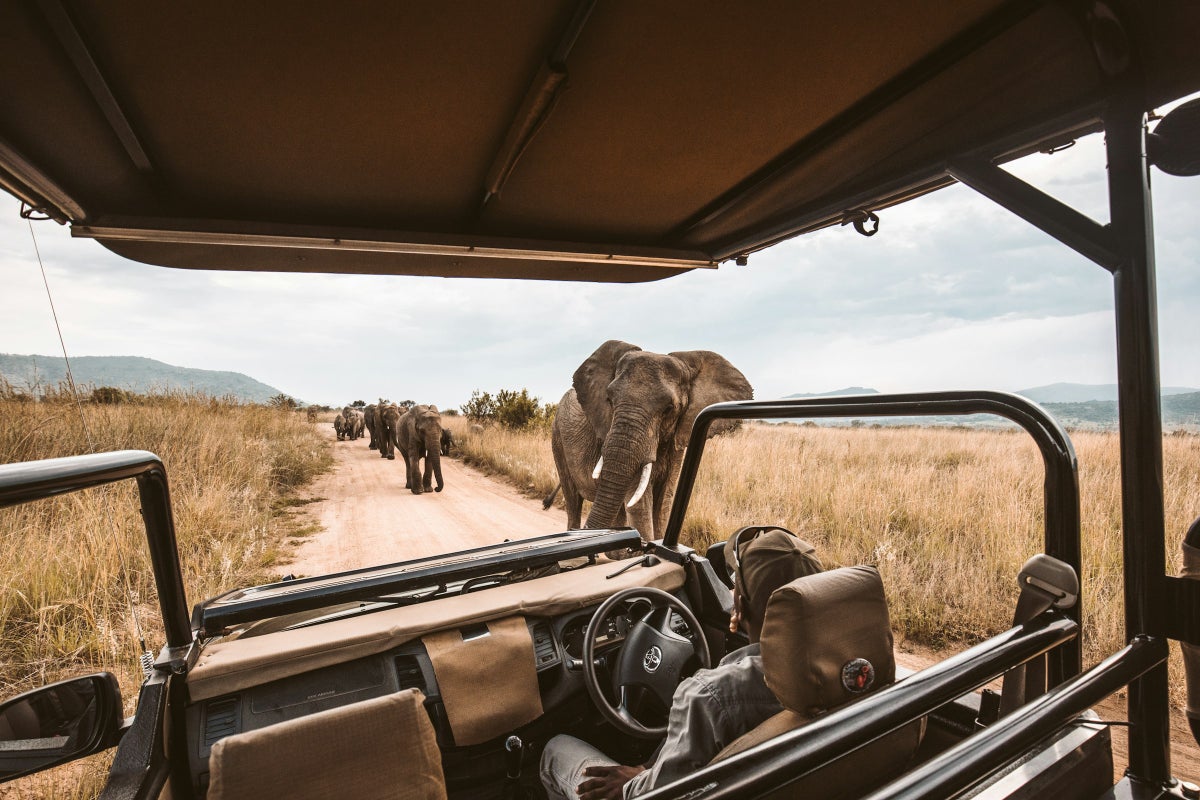
Table of Contents
1. how to plan a tanzania safari, 2. how to plan a kenya safari, 3. how to plan a botswana safari, 4. how to plan a namibia safari, 5. how to plan a uganda safari, 6. how to plan a rwanda safari, 7. how to plan a south africa safari, 8. how to plan a zambia safari, 9. how to plan a zimbabwe safari, final thoughts.
We may be compensated when you click on product links, such as credit cards, from one or more of our advertising partners. Terms apply to the offers below. See our Advertising Policy for more about our partners, how we make money, and our rating methodology. Opinions and recommendations are ours alone.
While Kruger National Park in South Africa is one of the most popular destinations on the African continent to see the Big 5 — lion, leopard, rhinoceros, elephant, and African buffalo — many other African countries offer incredible safari experiences and once-in-a-lifetime wildlife sightings, assuming you’re willing to think a bit outside the box and get off the beaten path.
These are some of the best places to go on a safari in Africa, from Botswana’s Okavango Delta to fan favorites like the Serengeti and Kruger to a safari you can do just outside of Kenya’s capital at Nairobi National Park.
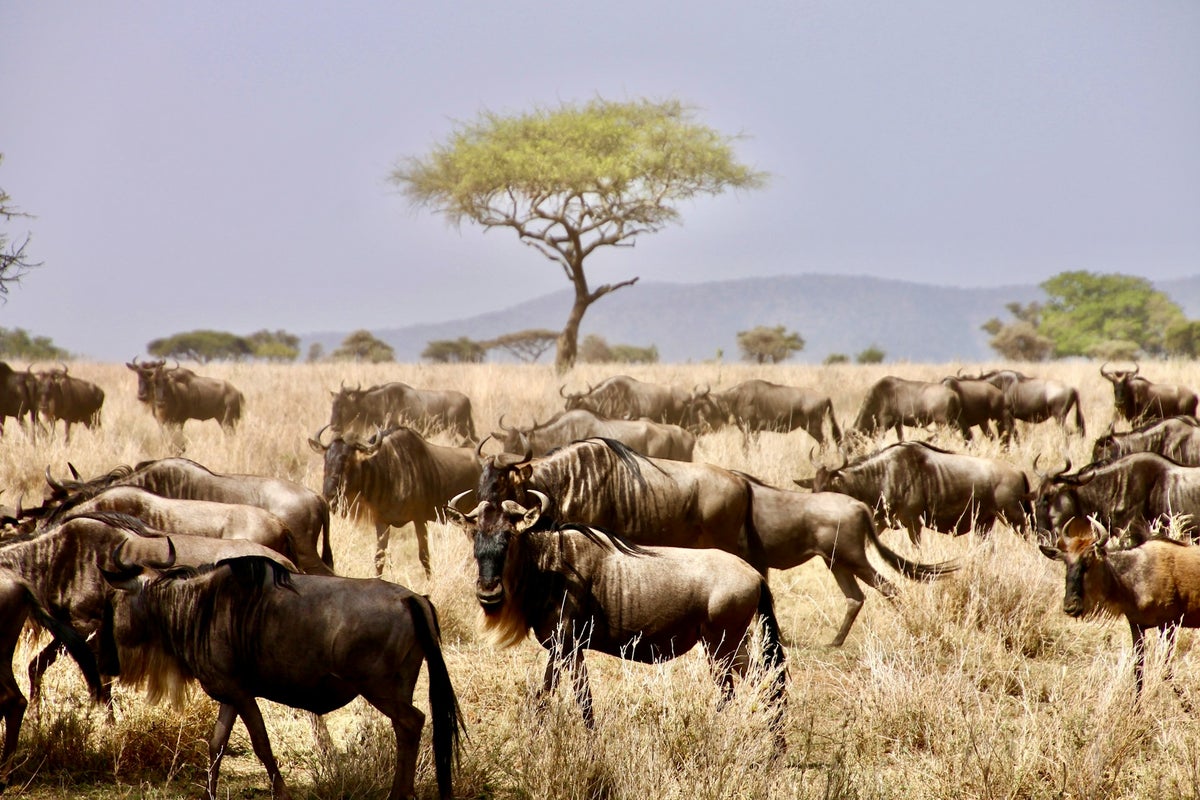
Most people planning a safari trip in Tanzania should head to Serengeti National Park , a UNESCO World Heritage Site known for its massive migrations of zebra and wildebeest . Start by organizing travel to Kilimanjaro International Airport (JRO) or Arusha Airport (ARK). From there, you can travel by land to the Serengeti or fly to one of the park’s 7 airstrips and transfer to your desired safari lodge.
Where To Go and What To See on a Safari in Tanzania
Most people take a safari trip to Tanzania to see the wildebeest migration, but you can also expect to spot the Big 5, cheetahs, hyenas, and leopards in the Serengeti.
Some of the best lodges in the Serengeti National Park are the Four Seasons Safari Lodge Serengeti (which can even arrange a hot air balloon safari) and various tented camps and luxury lodges from Singita , a company focused on sustainable exploration of the region. But start saving up Marriott Bonvoy points, as Marriott announced the opening of JW Marriott Serengeti Lodge in 2026 , an ideal spot to view the Great Migration between the Grumeti and Mbalageti rivers.
Travelers can also head to the Ngorongoro Crater , one of the world’s largest intact volcanic calderas, where you can also view the Big 5, zebras, impalas, hippos, and more. You may also spot flamingos there.
Birders or those who want to avoid larger crowds should consider Tarangire National Park , which has one of the largest elephant populations in Africa, more than 500 bird species, and a wildlife migration that’s not as large as the Serengeti’s but impressive nonetheless.
Besides taking more traditional safaris, visitors can go chimpanzee trekking in Tanzania in Gombe Stream National Park , one of Africa’s smallest national parks (and only accessible by boat).
Best Time To Go on a Safari in Tanzania
The best time to visit Tanzania for a safari is June to October, the dry season in the Serengeti . This is when the bush is thin and you can see more wildlife, including the Big 5. However, May through June is when visitors can see the wildebeest migration in the Serengeti. Those who want to view wildebeest calving should visit in January and February . And if you’re looking for a Tanzania safari on a budget, months like April and early May can offer better prices and fewer crowds.
See the most wildlife at Ngorongoro Crater from December to February and June to September, which are the months with the driest weather, when you can spot herds out in search of water. For Tarangire National Park, the best time for migrations is the June to November dry season , where you can spot many different animals grazing around and drinking from the Tarangire River.
When it comes to chimpanzee trekking, it’s best to go between May and October in the dry season, when the forest flora is short and trails are less muddy. Keep in mind these experiences require permits, and most companies require visitors to be over the age of 15 .
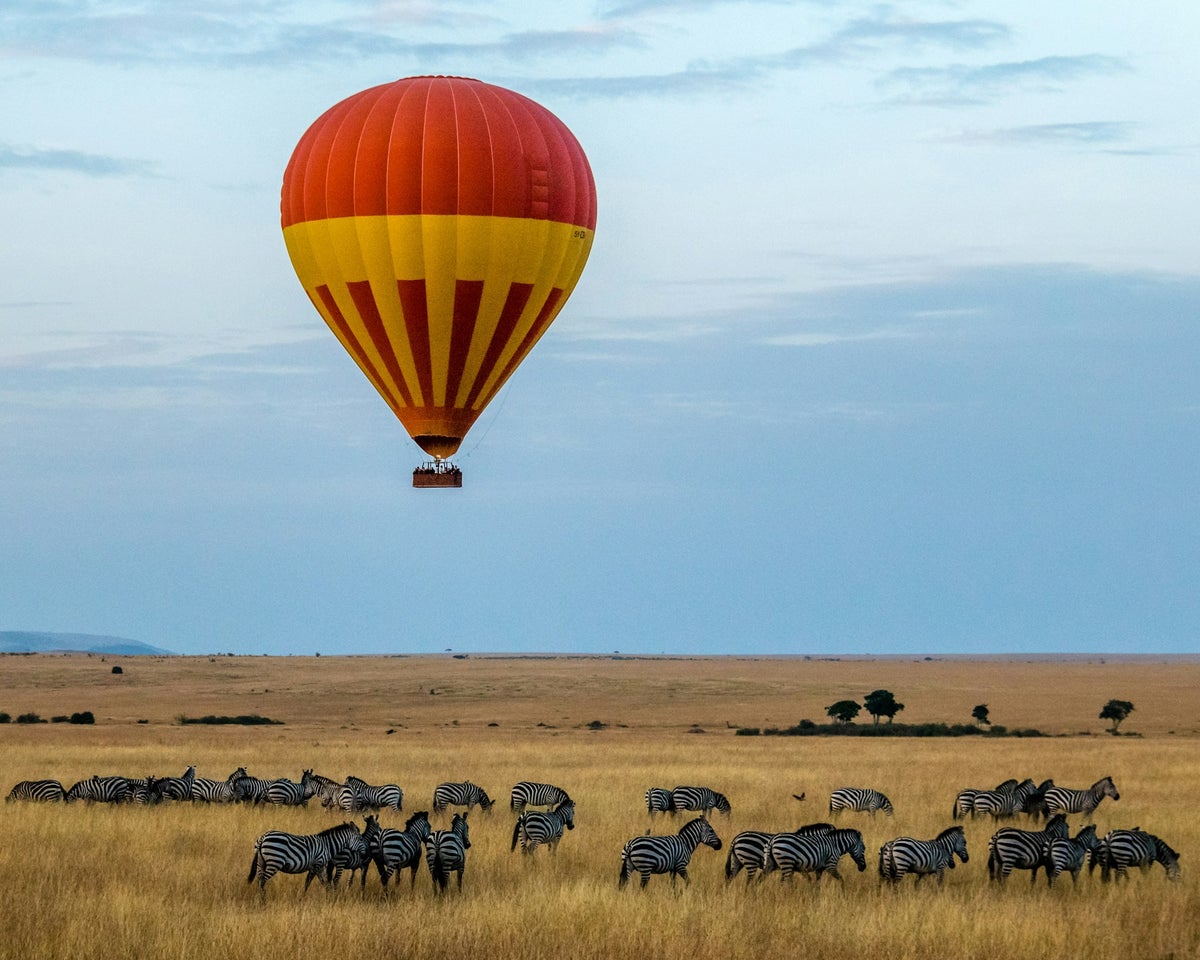
Some of the best African safaris in Kenya allow you to see the Great Migration and the Big 5 (just as you can in Tanzania). Masai Mara National Reserve is probably the most popular spot . Start by flying into the main airport, Jomo Kenyatta International (NBO) in Nairobi , then pop over to the nearby Nairobi Wilson Airport (WIL) for shorter, domestic hops to airstrips closer to the park.
Where To Go and What To See on a Safari in Kenya
Besides the Big 5, you can also expect to see animals like cheetahs, hyenas, gazelles, and wildebeest on a safari. Our top pick for lodging would be the JW Marriott Masai Mara Lodge , one of the few safari accommodations in Africa you can book using points and miles. The all-inclusive property features 20 luxury tents overlooking the Talek River.
Another iconic riverside camp is the Governor’s Camp , a collection of luxury tents overlooking the Mara River, where you can spot hippos and crocodiles. Both hot air balloon safaris and walking safaris are popular in the region, offering unique ways to enjoy the region’s flora and fauna. As the Maasai are one of the largest tribes in Africa, don’t forget to visit local villages and experience some of the tribe’s unique cultural practices.
Amboseli National Park at the base of Kilimanjaro is another Kenyan destination to experience a safari. Here, you can see the Big 5 and more than 600 types of birds. You can also get close-up views of large elephant herds. Samburu National Reserve is another popular safari destination, known as one of the best Kenyan destinations to spot leopards.
And if you’re extra short on time, remember that Kenya is one of the only countries in Africa where you can spot wildlife just a short drive from a capital city. Nairobi National Park is just a few miles outside of Nairobi, home to animals such as leopards, lions, black rhinos, and giraffes.
If you’re dying to stay at the famous Giraffe Manor (a hotel where the resident giraffes poke their heads into your bedroom window each morning) but it’s too expensive or fully booked, you can visit the Giraffe Center instead.
Best Time To Go on a Safari in Kenya
In most cases, the best time to take a safari in Kenya is between June and October, the dry season . You’ll be able to catch the wildebeest migration in Masai Mara in September . November and December can offer lower prices and fewer crowds. March through May is also a more affordable time to visit, but heavy rain or flooding may disrupt your trip.
There aren’t many opportunities to use your points and miles for safari lodges, but if the JW Marriott Masai Mara Lodge is on your list (or you want to start saving up for the JW Marriott Serengeti for a 2026 safari), building up a stash of Marriott Bonvoy points is a great plan. Consider getting a co-branded Marriott Bonvoy credit card . Amex Membership Rewards points from a card like The Platinum Card ® from American Express and Chase Ultimate Reward points from cards such as the Chase Sapphire Reserve ® or the Chase Sapphire Preferred ® Card transfer to the Marriott Bonvoy program at a 1:1 ratio.
Those looking for a more remote, intimate safari experience should consider Botswana. The country is a bit more difficult to get to, making it feel far-flung and offering an authentic African safari experience. As tour operators need to adhere to strict conservation requirements, safaris in Botswana are often smaller and more exclusive, which is why safari prices in Botswana can also be more expensive . Anyone in the market for a water safari will likely appreciate Botswana, as some of the best ways to spot wildlife are by boat or even canoe.
If you��’re coming from abroad, you may fly into Sir Seretse Khama International Airport (GBE), just outside of Gaborone. Still, many safari camps are much closer to the Maun Airport (MUB) or Harry Mwanga Nkumbula International Airport (LVI), which you can get to from hubs in South Africa .
Where To Go and What To See on a Safari in Botswana
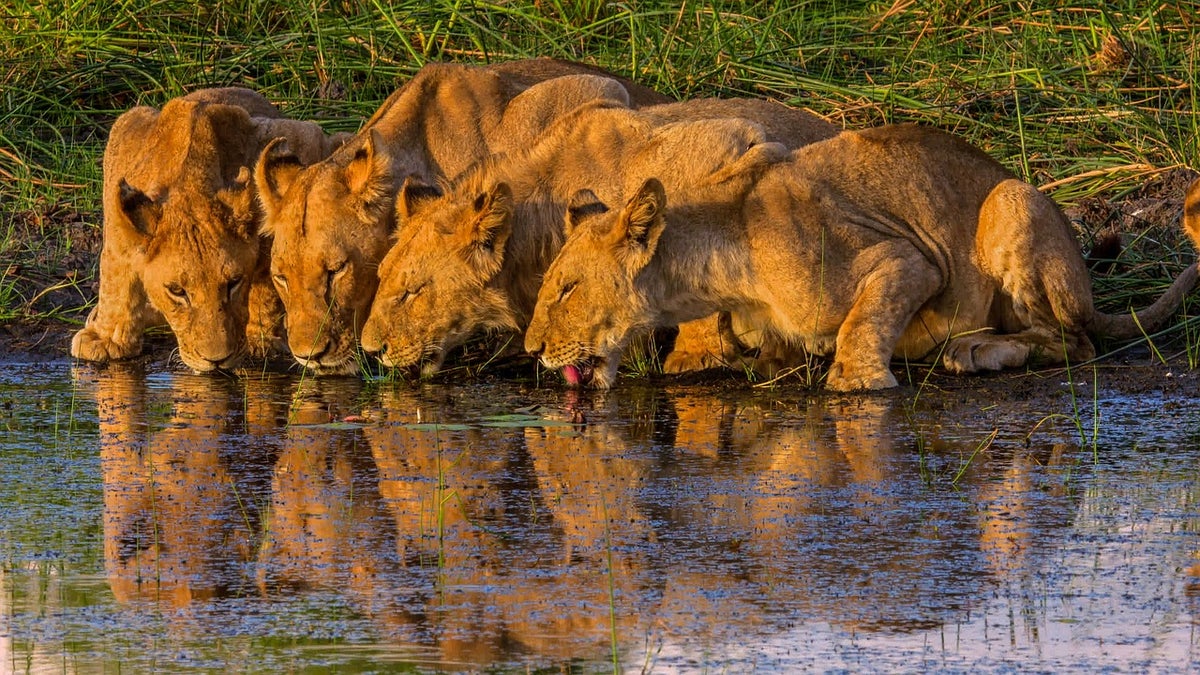
One of the most unique and popular destinations for a Botswana safari is the Okavango Delta , grassy flood plains home to the Big 5 and more. Here, you can explore the area by water safari on small boats or even canoes, as well as on land — both walking safaris and driving safaris. Make sure to keep an eye out for African wild dogs. There are less than 6,600 left in the wild, and many reside in this area. Stay at Xigera Safari Lodge in Moremi Game Reserve, an intimate lodge with just 12 suites and the stunning 32-foot baobab treehouse suite.
Chobe National Park is another emblematic destination in Botswana for a safari, especially if you’re in the market to support female guides. Guests at the Chobe Game Lodge can book a female guide as part of an all-female safari guide team, the Chobe Angels . Boat up and down the Chobe River, spotting lions, buffalo, elephants, and more along its banks.
For something different, consider a safari in the Kalahari Desert. Here, you can ride horses through salt pans, sand dunes, and savannas, go fishing, ride camels, hike, or even take a cycling safari. Keep an eye out for oryx, giraffes, and meerkats.
Best Time To Go on a Safari in Botswana
Similar to the aforementioned countries, the dry season in many areas of Botswana runs from May to October and is one of the best times to visit, as much of the wildlife comes out in search of watering holes. However, December to April is the rainy season, turning the Kalahari Desert into a green and blossoming paradise , making it the perfect time to visit this unique region.
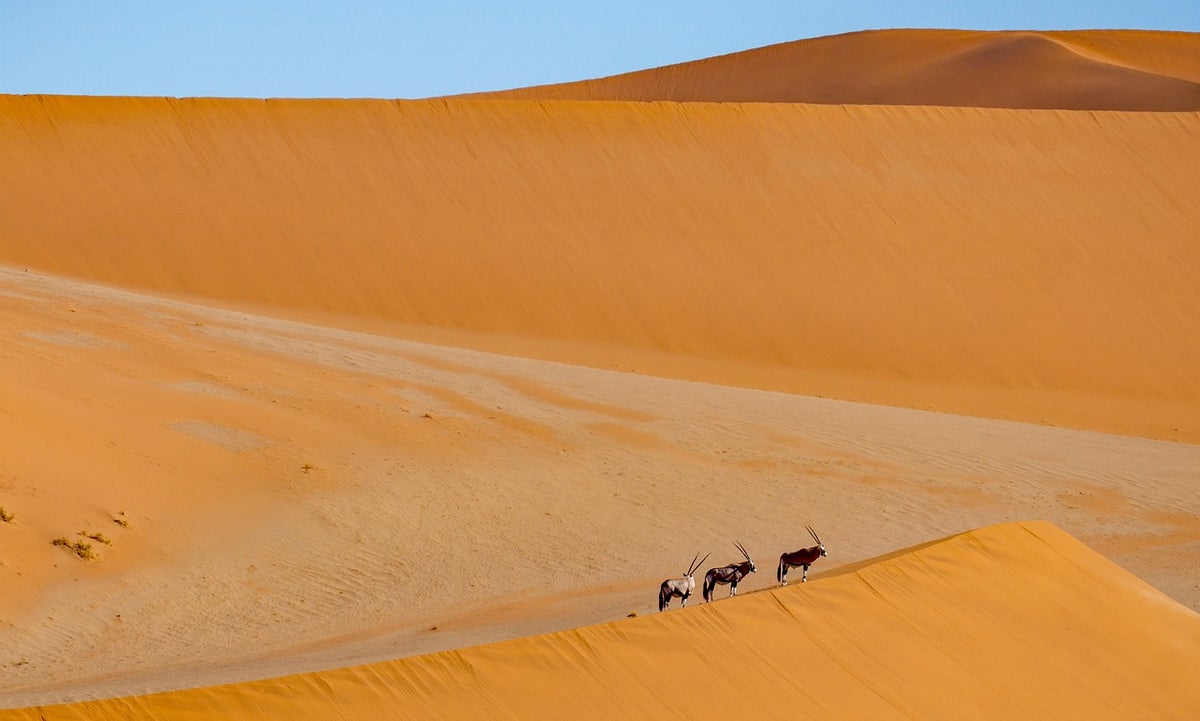
Namibia is a special place for a safari because not only can you see 4 out of the Big 5 in places like Etosha National Park, but you can also see a distinct collection of wildlife in the Namib Desert in Namib-Naukluft National Park. Namibia is more difficult to get to than many other safari spots, especially from Europe and the U.S., so most visitors come from destinations like South Africa first.
Where To Go and What To See on a Safari in Namibia
The most popular place in Namibia for a more traditional safari is Etosha National Park . One of the largest game reserves in Africa, it’s home to large populations of elephants, lions, cheetahs, giraffes, leopards, black rhinos, and black-faced impalas, among many others. There are several accommodations within the park, but the more luxurious, like Mokuti Etosha and Ongava Lodge (built into a rocky enclave), can be found just outside the park. Ongava Lodge is also home to an airstrip, and you can fly there from Namibia’s capital airport, Hosea Kutako International Airport (WDH), in Windhoek.
Sossusvlei is where the landscape changes , so don’t expect a traditional experience in this red-dune salt and clay pan. Part of Namib Naukluft National Park and Desert , it’s so vast you may want to explore it by hot air balloon to take it in from above. Hike dunes like Big Daddy, explore the ancient trees at clay pan Deadvlei, or traverse the entire area by 4×4 or quad.
While this desert landscape may seem barren, keep an eye out for wildlife like hyenas, jackals, foxes, ostrich, and geckos. Sossusvlei offers accommodation for all budgets, but luxury travelers should plan to stay at the andBeyond Sossusvlei Desert Lodge , home to 10 glass suites from which you can admire the sparkling, starry night sky (the NamibRand Nature Reserve is an International Dark Sky Place ).
And don’t discount Namibia’s barren Skeleton Coast — you may spot desert elephants, cheetahs, black rhinos, ostriches, lions, hyenas, and more. Named for the whale and seal bones once scattered on its beaches but now known for its numerous shipwrecks, it’s also home to Cape fur seals, too. Explore the area on foot, boat, surfboard, or quad.
Best Time To Go on a Safari in Namibia
June through September is the driest and best time to visit Etosha , as animals are crowding around sparse watering holes. The same goes for Sossusvlei when the dry season (May to October) brings crisp, blue skies that juxtapose beautifully against the ochre desert sands. However, those heading to the Skeleton Coast may prefer to travel between May and December . Although November and December bring some showers and fog, the weather also gets warmer at this time of year.
There’s a lot to know when planning a safari. Our safari adventure guide has updated tips on finding accommodation, booking travel, and packing for your upcoming African safari.
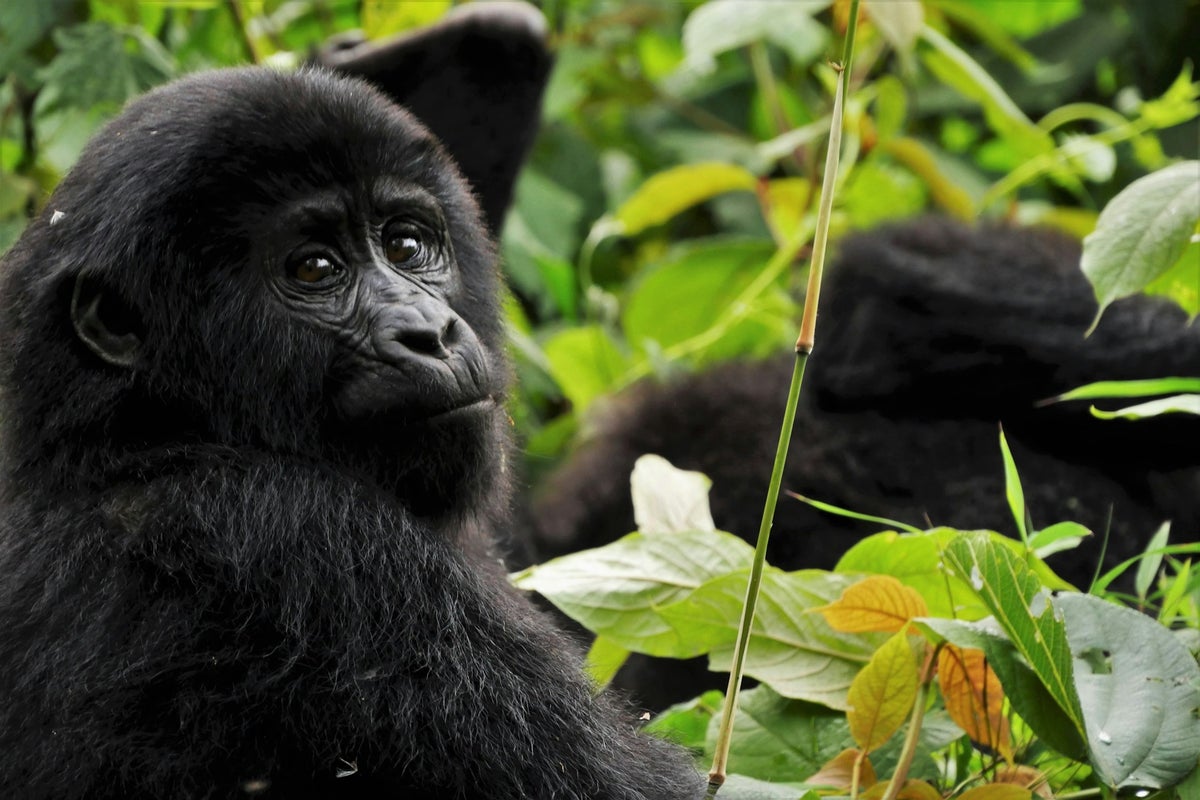
Although visitors can see animals like elephants, hippos, and lions on a Uganda wildlife safari, the main call of this African country is gorillas in the wild . About 400 mountain gorillas call Uganda home , which is about half of the mountain gorilla population left in the world. Gorilla safaris are different from more traditional safaris. In lieu of driving around in a Jeep-style vehicle, gorilla trekking is all about getting up into the hills to see these giant creatures in their natural habitat .
Chimpanzee trekking is also popular in Uganda, as are birding safaris. Most travelers start their adventure by flying into the Entebbe Airport (EBB) and then taking a quick domestic flight to smaller airports. However, visitors planning to gorilla trek in Uganda may find it faster to fly to Kigali International Airport (KGL), Rwanda’s capital, then drive to the national parks .
Where To Go and What To See on a Safari in Uganda
The most popular location for a safari in Uganda is Bwindi Impenetrable National Park , known for birding, forest elephants, chimpanzees, and, of course, mountain gorillas. There is some gorilla trekking in Mgahinga Gorilla National Park , but your chances of spotting gorillas are higher in Bwindi, as this park has more gorilla groups.
For gorilla trekking in general, many visitors are stuck between Uganda and Rwanda. When it comes to Rwanda versus Uganda for gorilla trekking , budget travelers ready for an adventure should select Uganda , where gorilla trekking permits for either park cost $800 per person per day . (It’s nearly double in Rwanda, as we’ll outline below). You must be at least 15 to get a permit.
However, those heading to Uganda should be ready for an adventure, as the treks can be tougher and longer . Always book permits well in advance .
If you go to Bwindi, stay within the park at cozy lodges like Buhoma or just outside the park at Mahogany Springs , perched along the Munyanga River. Birders may want to visit Queen Elizabeth National Park , home to more than 600 bird species, plus tree-climbing lions .
Best Time To Go on a Safari in Uganda
Visit UNESCO World Heritage Site Bwindi Impenetrable National Park for gorilla trekking between June and September and December and February . Since you’ll be hiking along hilly, forested trails, it’s better to go during the dry season, when it’s less muddy and slippery . The same times of year are best for visiting Queen Elizabeth National Park, though March through May are some of the best times for birding.
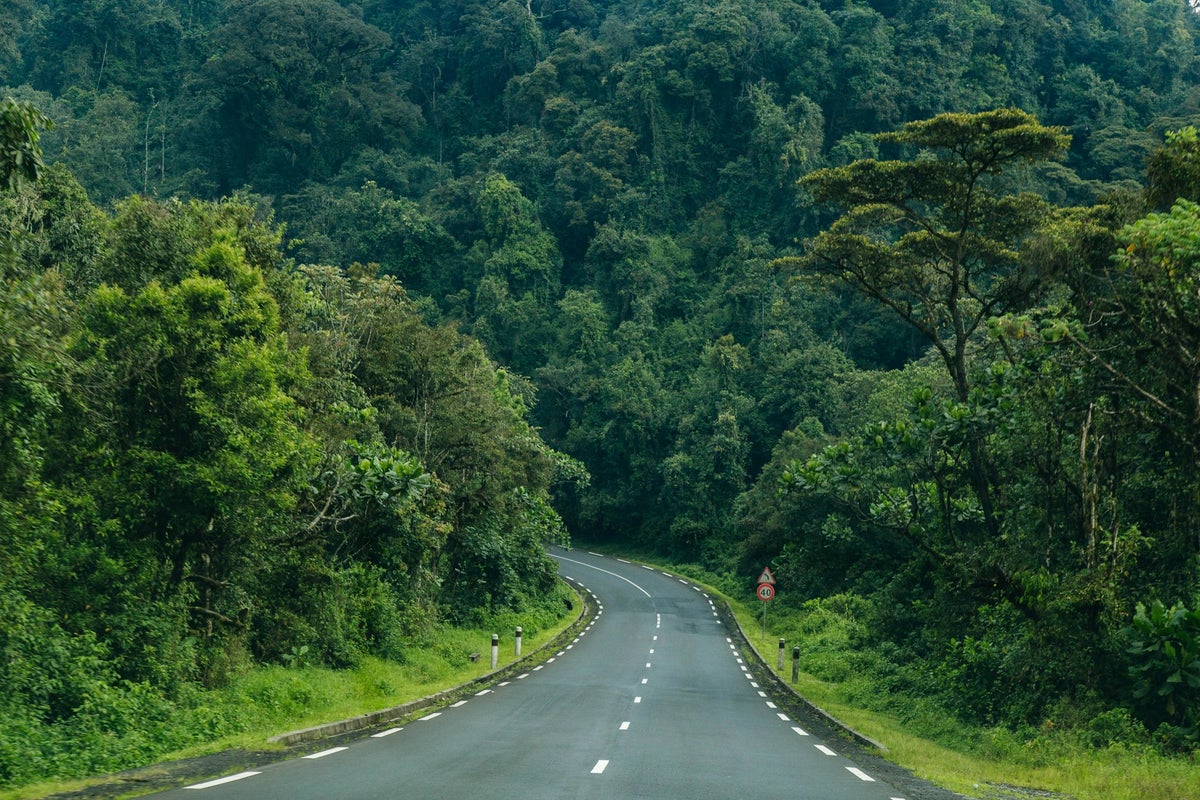
Rwanda safaris can be on the expensive side , and they’re best for adventure travelers who are also ready to splurge. The country offers some of the most accessible gorilla trekking but also some of the most costly.
Where To Go and What To See on a Safari in Rwanda
Start with a flight into Kigali (KGL), then take the 2.5-hour drive to reach the country’s most renowned destination for viewing mountain gorillas, Volcanoes National Park . The park itself is stunning, home to 5 volcanoes and a lush, hilly rainforest, home to mountain gorillas, elephants, buffalos, and nearly 200 bird species. Permits start at $1,500 per person per day , and they only issue 96 per day, so it’s important to book in advance. Stay at one of the 6 conical, luxury bird nest villas at Bisate , which overlooks an amphitheater formed by volcanic cones.
And yes, if you’re in the market to see the Big 5 after you’ve spotted the elusive mountain gorillas, head to Akagera National Park . It borders Tanzania and is one of the largest protected wetlands in Africa. Spot elephants, lions, black rhinos, buffalos, hippos, hyenas, zebras, antelopes, and more than 500 different types of birds, including the shoebill stork.
Down south, aid in rainforest conservation by visiting Nyungwe National Park , a UNESCO-listed site that’s home to 13 of Africa’s primates (including chimpanzees) and a stunning canopy bridge where you can walk amid the towering treetops
Best Time To Go on a Safari in Rwanda
The best time to visit Volcanoes National Park is during the dry seasons, which run from mid-December to early February and June to mid-September . However, if you find yourself there from March to May, make sure to view the many butterfly species that come along with the heavy rains . The dry periods are also the best times to visit Nyungwe National Park and Akagera National Park.
Some countries on this list require U.S. citizens to obtain a visa. Others, such as South Africa, require 2 full, consecutive blank pages in your passport per entry. Some require your passport to be valid for at least 6 months after your visit. Some require you to have certain vaccines, or you may need to take malaria medication. Check passport, permit, visa , and vaccination requirements before booking travel.
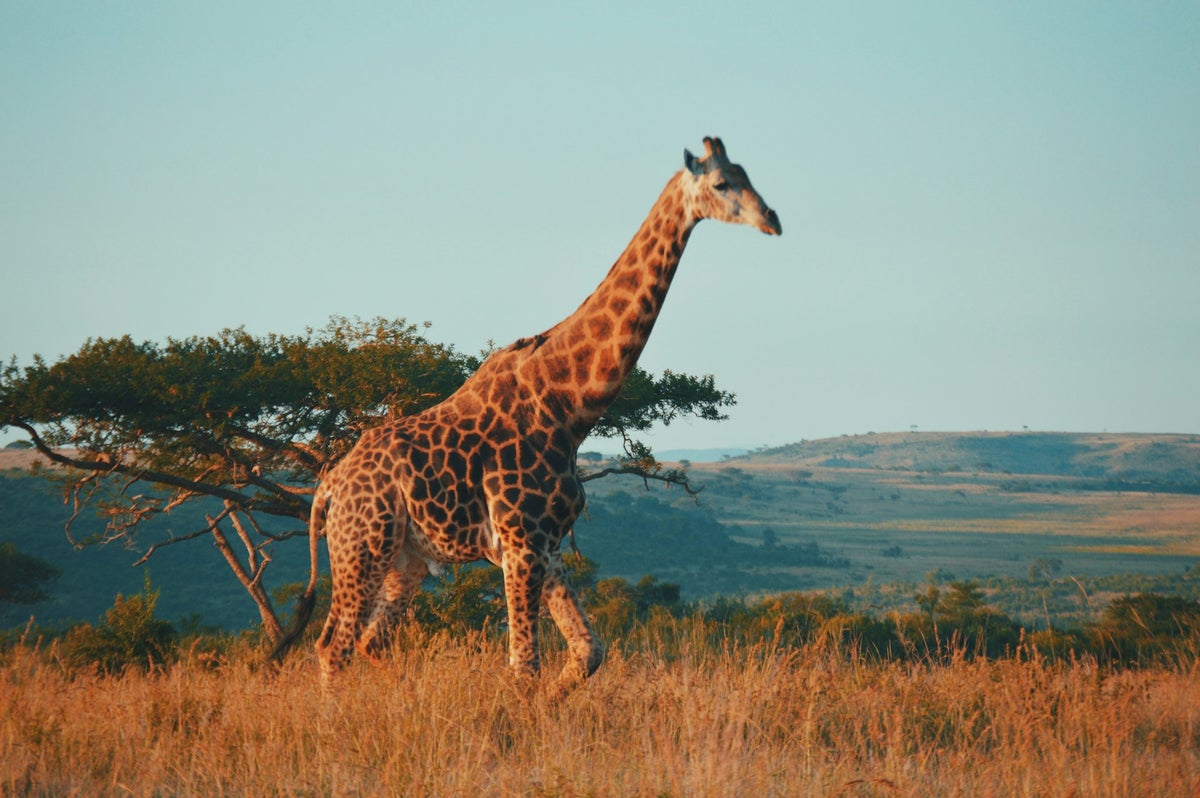
South Africa is the most popular African country for a safari, but that doesn’t necessarily make planning any easier. With so many different game reserves, tour companies, and other options, it can be difficult to decide exactly where to go. The good news is, because there are so many choices, it’s easy to find a safari that fits your budget and travel style. Start by flying into either Cape Town (CPT) or Johannesburg’s O.R. Tambo Airport (JNB). From there, many safaris have private airstrips, but you can also fly into smaller airports like Mpumalanga International Airport (MQP) or Hoedspruit (HDS) and be on your way to viewing the Big 5.
Where To Go and What To See on a Safari in South Africa
Start by deciding if you’d like to visit a state-run or private game reserve. Popular state-run game reserves include Kruger National Park and Addo Elephant National Park , which is actually home to the Big 7 (the Big 5 plus the great white shark and the southern right whale, found within the park’s marine section). Pilanesberg National Park also features the Big 5, while Kgalagadi Transfrontier Park is known for its big cats . These larger parks often offer more budget-friendly safaris, though they can get crowded during peak season.
Luxury travelers may prefer a more exclusive safari experience, where a lodge or tented camp on a private game reserve includes all the safari excursions. Some of the best private game reserves for a luxury African safari experience include Sabi Sand, Phinda, Timbavati, Kwande, MalaMala, Amakhala, and Phinda, among many others. Choosing a game reserve and safari lodge may come down to where you want to base your trip: You can start in Johannesburg or Cape Town. While Johannesburg is the most convenient hub for visiting Kruger, Cape Town is known for its immense beauty and unique cultural offerings and is a favorite among seasoned travelers.
Best Time To Go on a Safari in South Africa
Go on a South African safari during the dry season, where less vegetation makes it easier to spot animals, which you can often find gathering near rivers and watering holes. Most of the country’s wildlife parks see their dry season between May and September. However, this is when the Western Cape sees rain , so if you’re heading to that area of the country, it may be best to go to this region in the other months.
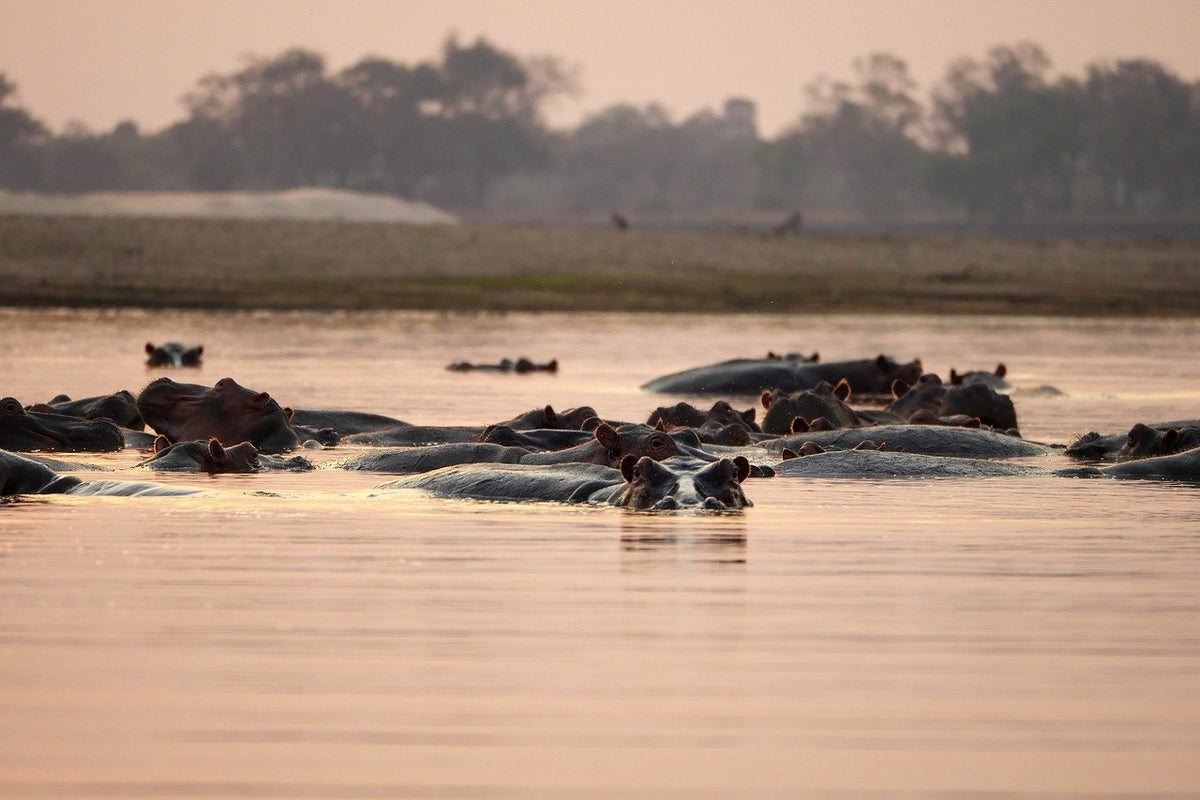
If you’re in the market for something a bit more off the beaten path, consider a safari in Zambia. Start by flying into the Kenneth Kaunda International Airport (LUN) in the nation’s capital, Lusaka. Then, catch a short flight to Mfuwe Airport (MFU), which is the hub for South Luangwa National Park , the most popular area in the country for a Zambia safari, where you can spot wildlife such as leopards, hippos, and rare Thornicroft giraffes. Or, fly to the Royal or Jeki airstrips to visit Lower Zambezi National Park .
Where To Go and What To See on a Safari in Zambia
South Luangwa National Park is the ideal destination for walking and driving safaris, as the Luangwa River can be unpredictable, so boat safaris aren’t common. Those who want to see wildlife by boat should visit Lower Zambezi National Park, where you can paddle through the Zambezi River via canoe with expert guides who can help you spot all kinds of wildlife, including elephants, hippos, and birds.
The nice part about a safari in Zambia is that it’s appropriate for any budget . Stay at cozy river lodges, in luxury tents, or open-air villas. The Old Monodoro camp in Lower Zambezi has 5 chalets — and don’t be surprised if you find an elephant sipping water out of your outdoor tub in the morning. Elephants also regularly walk through the open-air lobby at Mfuwe Lodge in South Luangwa.
Best Time To Go on a Safari in Zambia
Most lodges in South Luangwa National Park and Lower Zambezi National Park are only open during the dry season between March and October. To have the full Zambia safari experience, booking your trip during this period is best.
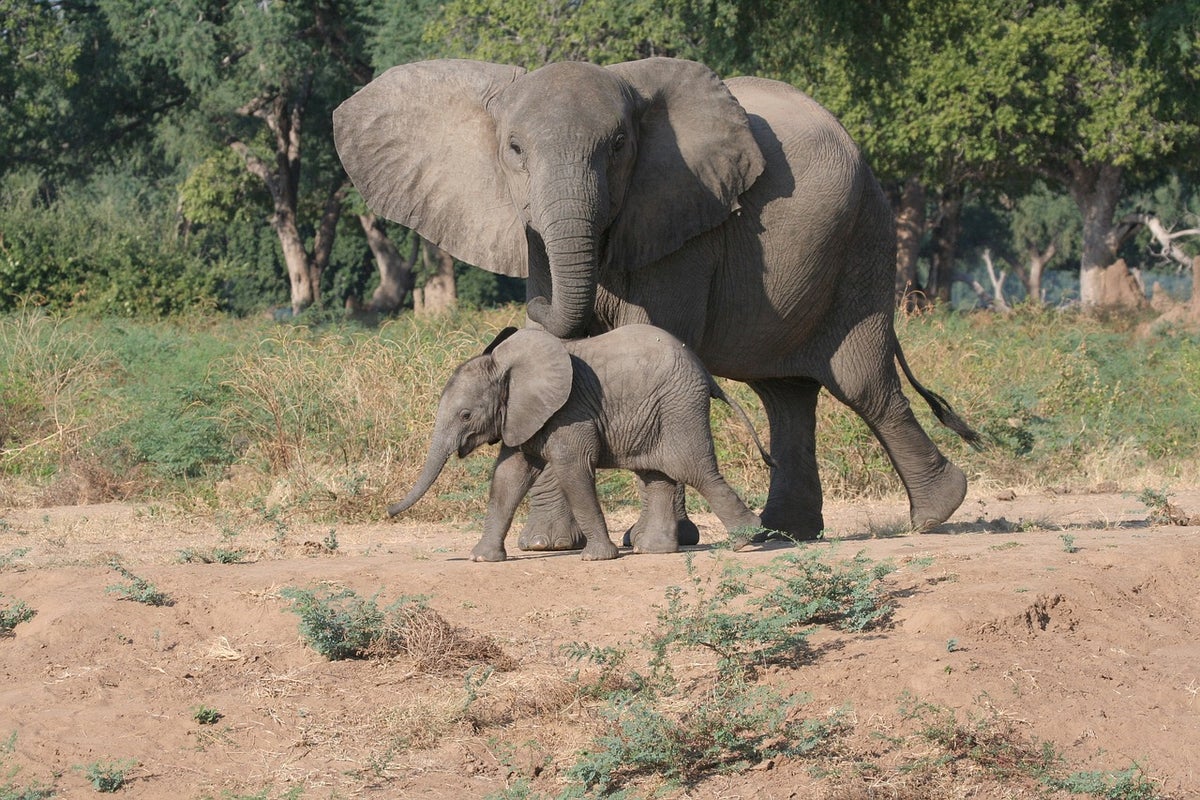
Most travelers combine a visit to Victoria Falls with a Zimbabwe safari . The best way to do this is to fly to Victoria Falls International Airport (VFA), which is about a 20-minute drive to the falls .
Where To Go and What To See on a Safari in Zimbabwe
Just a short drive from Victoria Falls, you’ll find Zambezi National Park (a completely different park than the aforementioned Lower Zambezi National Park in Zambia ). This park features the Big 4 (everything but rhinos). You can also cross the border into Zambia via a quick drive to visit Mosi-oa-Tunya National Park , where you can spot elephants, buffalo, giraffes, zebras, and white rhinos.
If you’re hoping to spot the Big 5, Hwange National Park is just over an hour’s drive away , though you’ll have to look hard to find rhinos, as they’re few and far between. You can even do horseback safaris through this park, getting up close and personal with wildlife on your horse. Plan to stay at Davidson’s Camp , where the en suite tents look out over a watering hole for prime wildlife-watching from your room.
Victoria Falls is also just an hour’s drive from Chobe National Park in Botswana , home to one of the world’s largest elephant populations.
Best Time To Go on a Safari in Zimbabwe
June to September is the best time for a safari in Zimbabwe , and June is an especially beautiful time to see Victoria Falls , as you may catch the tail end of the rainy season, bringing powerful sprays and cascades. However, those visiting Hwange to birdwatch should visit from November to April , when the migratory birds return from the north.
When planning a safari, you have endless possibilities to consider. But knowing you can visit other countries besides just Tanzania or South Africa may make it easier to create a safari trip that fits your timing, budget, and travel style. Whether gorilla trekking, birdwatching, or a traditional safari searching for the Big 5, these African countries have got you covered.
For rates and fees of The Platinum Card ® from American Express, click here .
UP's Bonus Valuation
This bonus value is an estimated valuation calculated by UP after analyzing redemption options, transfer partners, award availability and how much UP would pay to buy these points.
This is the best time to take an African safari

Lions and elephants and cheetahs, oh my! For nature lovers, an African safari is the ultimate immersive getaway. Safaris offer a combination of wildlife encounters and luxurious lodges, incredible thrills and peaceful, unplugged wilderness.
Although traveling to the African bush is a great experience any time of year, there are definitely more advantageous times for wildlife spotting. For example, in East Africa, you may want to time a trip to coincide with the great wildebeest and zebra migration. In Southern Africa, a trip at the same time most babies are born offers some incredibly special moments watching newborns with their mamas.
I've visited Africa more than a dozen times and have gone on safaris in six different countries, visiting every season.
While I've seen incredible wildlife — including lion cubs on a December trip to Botswana and spectacular herds of elephants in Zimbabwe on a May safari — in the nonhigh seasons, I've also dealt with some pretty extreme weather as well. For instance, I have experienced intense rain storms in November and freezing temperatures in June.
Sometimes the best time to take a safari is when you have flexibility in your schedule or can get the best rates. However, if you want to plan around the absolute best time to spot wildlife, read below to find out when to go.
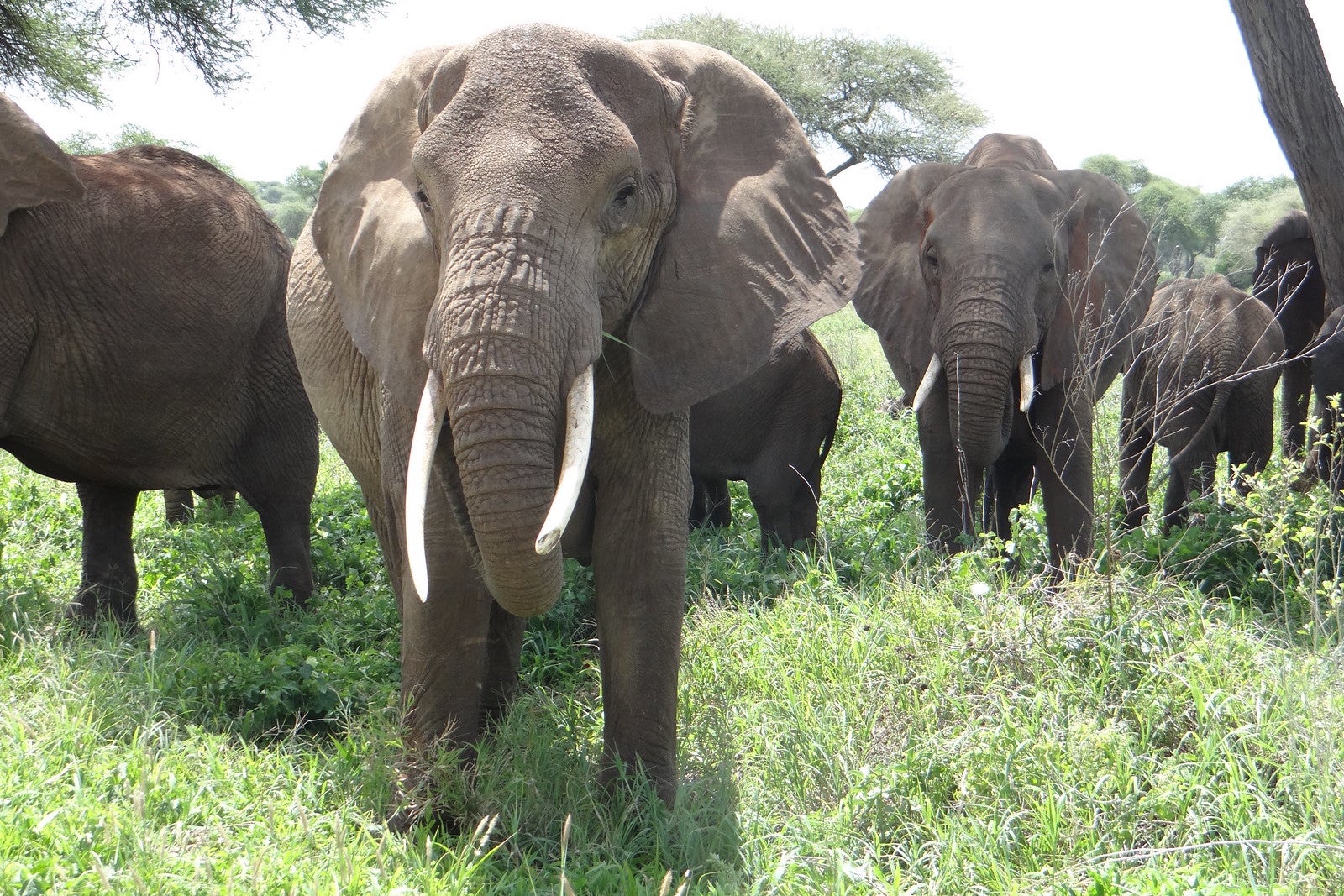
What months are best to go on an African safari?
The African continent is massive, comprising 54 unique nations and nearly 2,000 languages. Most safaris take place in two main savanna regions of the African continent: Southern and East Africa. The Southern Africa region includes South Africa , Botswana, Namibia, Zambia and Zimbabwe. East Africa contains the safari destinations of Kenya , Tanzania, Rwanda and Uganda.
Most of these destinations have one thing in common: They're located in the Southern Hemisphere. Even the ones that straddle the equator, such as Uganda, follow the Southern Hemisphere's weather patterns.
This means the seasons on safari will be the opposite of what you're most likely used to at home. Summer is December through February, winter is June through August, spring is September to November and autumn is March through May.
The Southern Hemisphere's winter and early spring — roughly June through October — is usually considered safari high season because it's the driest time of year. Wildlife gathers around watering holes when water is scarce elsewhere, Mark Nolting of Africa Adventure Company says; this makes it easier to see many species in one location.
In East Africa, the best time to go on an African safari is during the great migration, when thousands of antelope and zebra move in massive herds to find water. That season is roughly December to March and then again from June to mid-November.
There are some exceptions to this rule though.
In Botswana seeing wildlife from a mokoro, a type of dugout canoe, is a popular activity. That's why it's necessary to visit when there's water in the passageways. The dry season provides the same viewing opportunities as above, so you should be able to spot game anytime.
The private reserves in South Africa also defy seasonality; game is so dense in areas, such as the Sabi Sand Private Game Reserve, that you should be able to spot wildlife no matter the month or season.
Related: Up close and animal: Why walking safaris are so worthwhile
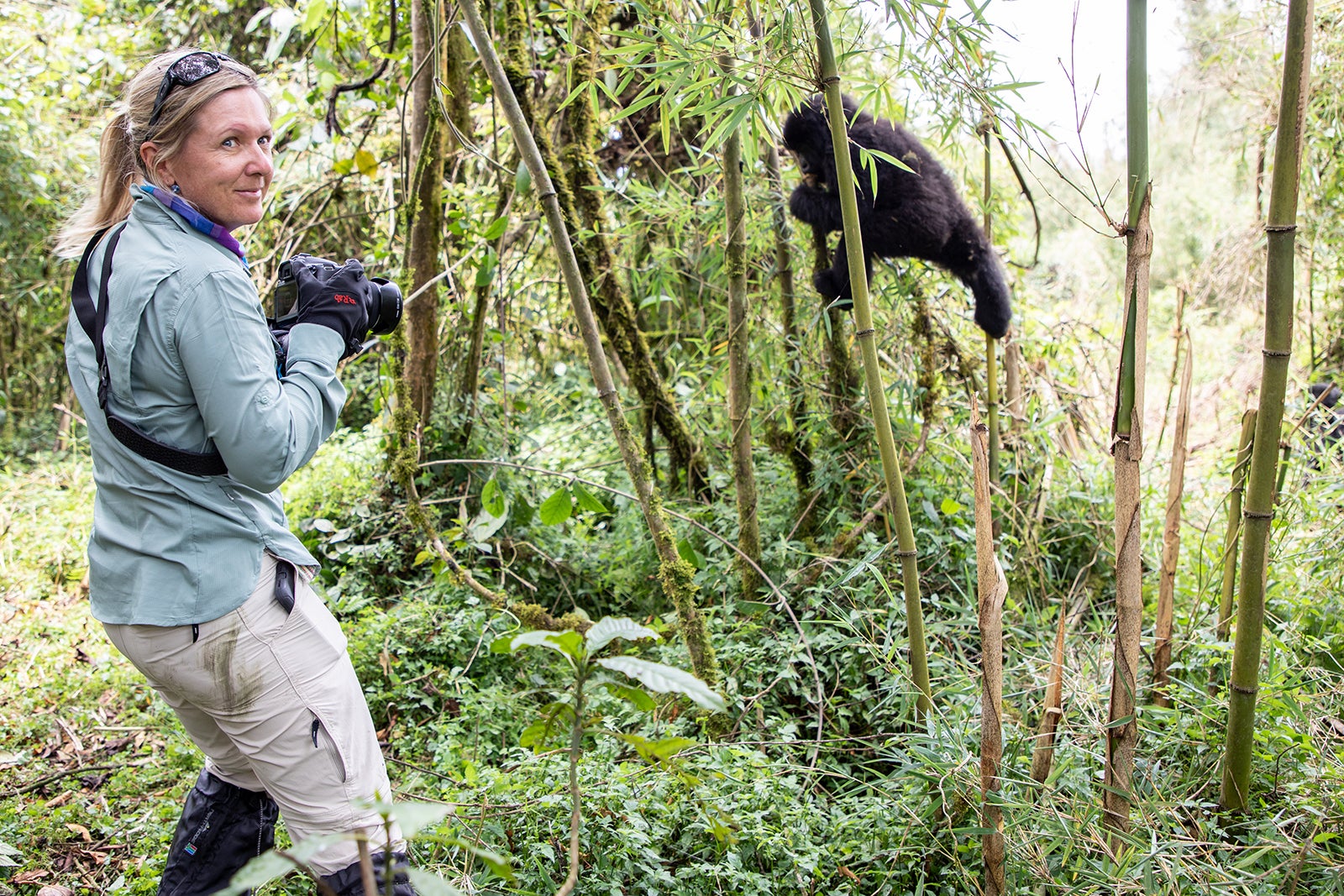
When is the best weather for a safari?
The dry weather of the winter season, roughly June through September, is often considered the best weather for a safari. Note: It can be quite cold after the sun sets, so bring a hat, fleece and gloves to keep warm during early morning game drives (though most safari lodges will provide blankets and hot beverages, too).
The "green season," as the rainier summer months are often called, is usually also the hottest time of year. At this time, you'll encounter the most insects, including mosquitos, in the bush.
Shoulder season — the times between the high season and green season, March to May and October to December — usually offers moderate temperatures and just an occasional storm. This time can be a great option for travelers since this is when you can get better pricing while still enjoying prime wildlife viewing.
Related: Luxury African safaris that support local communities
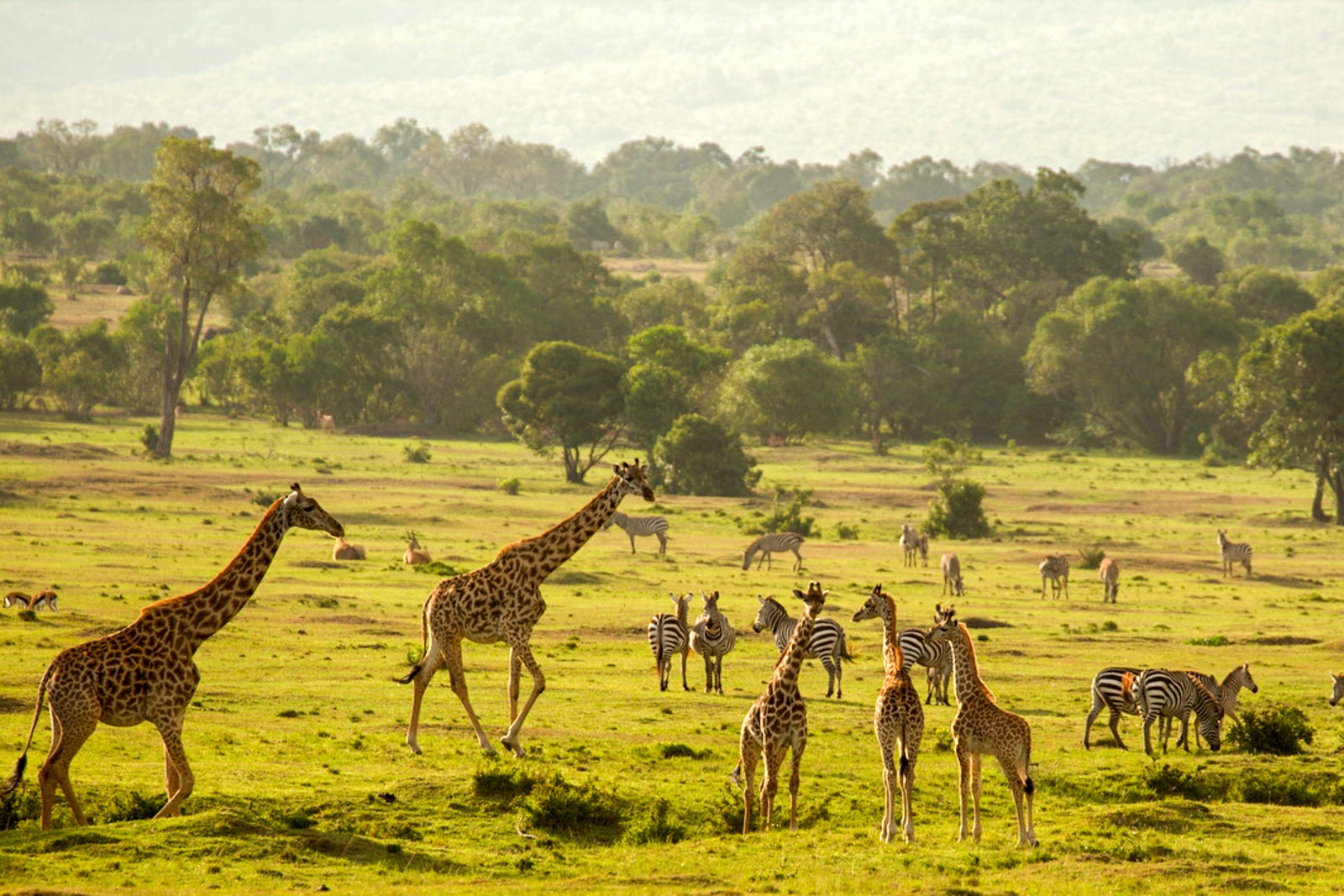
Is there one good time to go for seeing wildlife?
We're here to tell you that no matter what time of the year you go to Africa, you are guaranteed to see wildlife. The density and ease of spotting may change with the months and seasons, and some species will be easier to spot at certain times of year than others. However, there will always be free-roaming animals large and small if you visit the African bush.
That said, some times have a bit more to offer than others in terms of wildlife viewing.
The easiest time to spot wildlife — meaning you'll spend less time searching during your morning and afternoon game drive and more time watching the animals — is during the dry season. This coincides with the Southern Hemisphere's winter months, June through September, and usually reaches into October. During this period animals will be searching for water and will often congregate in the same location around a water hole or stream.
Spring, roughly October through December, is another prime time to visit. This is when many animals have babies, and the opportunity to see these newborns in the wild is truly a special treat. It's also when the foliage bursts into bloom and migratory avian life return to their leafy homes.
Summer brings denser foliage and a more vivid landscape, and for twitchers (birders, as they're known on safari), visiting this time of year offers big rewards. It's harder to spot wildlife with a large amount of dense growth, though, so you may need to spend another day or two on safari to tick off all the wildlife you're hoping to see.
Related: 9 incredible luxury family safari lodges for the ultimate African adventure
Looking for more planning advice for an African safari? Elsewhere's local experts in Botswana , South Africa or Tanzania can help you plan an epic wildlife adventure to those countries. (Note: Elsewhere is owned by TPG's sister brand Lonely Planet).
National Geographic content straight to your inbox—sign up for our popular newsletters here

Everything you need to know before booking your first African safari
For many, a safari represents the optimal escape and lifelong travel dream. If you’re going to invest in turning this dream into reality, there are some things worth considering. Plus, we recommend five incredible wildlife itineraries for 2023.
From the first waft of dewy morning air to the gentle owl hoots that drift into camp after dark, there’s a satisfying natural rhythm to a day on safari in Africa. Even if you’re not normally an early riser, you’ll quickly fall into the routine of pre-dawn starts, lazy lunchtimes, active afternoons and mellow evenings, making the most of the best hours both for wildlife-watching and for chilling out. Deep at night, if you’re lucky, you may hear the distant whoop of a hyena, the rasping call of a leopard or the bassy roar of a lion.
But more often than not, you’ll sleep soundly, drunk on fresh air. Soon after you wake, you’ll head out into the wild, eager to discover what the day will deliver. Perhaps you’ll find yourself inching up on some rhinos, watching boisterous elephants bathe in a waterhole or spotting the youngest, cutest members of a mighty big cat dynasty.
If this sounds like the kind of escape you’ve been craving, but you’re puzzling over possible itineraries, what’s the best way to choose?
Green means go
While every luxury safari offers unforgettable wildlife encounters, there are plenty of options to consider. High-end African trips and settings vary hugely in their atmosphere and style.
Some itineraries, for example, are much greener than others. If you’re passionate about nature, you’ll want to make ethical choices, mindful of climate change and biodiversity, perhaps by minimising your time in the air. While every long-haul trip has a high carbon footprint, you can limit your safari’s impact by choosing a destination near an international airport and sharing a vehicle rather than continuing by taking domestic flights.
With superb wildlife-watching opportunities within driving distance, Nairobi makes an excellent starting point for a low-airmiles luxury safari. “You could head for the stunning mountains and waterfalls of the Aberdare range, where lions hunt giant forest hogs”, says Kenya specialist Richard Trillo of Expert Africa. “The tree-dotted plains of the Maasai Mara, which host East Africa’s annual Great Migration, are also within reach,” Richard adds.
There are other ways to dial down the net impact of your trip without compromising on quality, however. While carbon offset schemes can help compensate for your emissions, for a more targeted approach, you could book your trip through a specialist safari operator that has established working partnerships with African conservation charities.
“We’re proud to support South Africa’s all-female Black Mamba Anti-Poaching Unit, and Greenpop, a non-profit Sub-Saharan forest restoration and urban greening organisation,” says Marcelo Novais of luxury operator Ker and Downey Africa.
“We give all our clients the opportunity to donate to these worthy causes, since leaving a positive legacy is one of our core values,” he adds. Other deserving organisations include African Parks, the African Wildlife Foundation, Tusk and the World Land Trust.
Another effective way of maximising the benefits of your trip is to choose lodges that go the extra mile in their vicinity, doing more for environmental protection, community partnerships and rural development than merely covering park fees and basic wages. In Tanzania, the Elewana Arusha Coffee Lodge invites guests to visit the craft project they support, Shanga, where locals with disabilities upcycle glass, textiles and fishing wire into cute elephant cushions, jewellery and clothing.
When it comes to shortlisting properties, membership of Ecotourism Kenya, Responsible Tourism Tanzania, Fair Trade Tourism and the Global Sustainable Tourism Council are generally useful indicators.
Settling in
Once you’ve arrived in the bush, what will your surroundings feel like? Anyone who’s cautious about camping in the wilderness will be relieved to discover that most top-end operators put their guests at ease by focusing on creature comforts: cool drinks, gourmet dining, indulgently appointed private bathrooms and sumptuous beds, for example. As a rule, their staff — from the head guide to the housekeepers — are superb at their jobs.
That said, there are significant differences between, on the one hand, intimate, minimalist camps with just a handful of canvas tents and, at the other extreme, sizeable lodges featuring swimming pools, gyms and perhaps even a spa, photography hide, editing suite, research centre, library and observatory. It’s a matter of weighing up how close to nature you’d like to feel — hearing all those thrilling sounds in the night, for example — against the range of facilities and creature comforts you’d like to enjoy.
When deciding, honest opinions from people who know the properties well can be invaluable. “Our safari specialists always have detailed conversations with our clients to understand their preferences and offer advice”, says Liberty Gilmour of Audley Travel. “Conventional aircon, for example, is rarely essential: Zambia in May and high-altitude destinations such as Ngorongoro can be quite cool, particularly at night. If it’s hot, natural ventilation may be sufficient, but many camps also have solar-powered cooling systems.”
Whether opulent, nostalgic or quirky, surroundings that suit your aesthetic aspirations can elevate your experience. The family heirlooms that decorate Camp Jabulani in South Africa’s Kapama Reserve, for example, create a uniquely cosy atmosphere, while Xigera Safari Lodge in Botswana’s Okavango Delta is so proud of its collection of original pieces by contemporary African artists and artisans that staff offer art and design tours of the premises. To strike a contemporary note, Loisaba Lodo Springs in Kenya’s Loisaba Conservancy has rooms dotted with hand-stitched West African textiles and elegant upcycled Edwardian furniture.

Peaceful days
Almost every safari programme revolves around guided excursions called game drives, a name dating back to the days of Big Five hunting trips, but the style of the vehicles you ride in isn’t discussed as much as perhaps it should be. While some outfits settle for basic open-sided 4x4s, others invest in supremely comfortable, easy-access vehicles with charging points, dustproof storage space and a fridge. If you’re a keen photographer, top quality private vehicles are a must. Electric safari vehicles offer a particularly smooth ride; while still rare, they’re the future, and are starting to catch on.
Ila Safari Lodge in Zambia’s Kafue National Park offers the rare luxury of total peace and quiet. Founder Vincent Kouwenhoven, who has pioneered electric transport at Ila and its sister lodges in Zambia and Malawi, explains: “Our love for Africa led us to develop technologies that enable guests to experience the bush in near-silent, pollution-free vehicles, charged by our own solar panels. It’s an ecologically conscious way to watch wildlife and very calming, too. Instead of the engine, you hear birdsong.”
Some safaris also promise near-solitude in a vast natural landscape — an intoxicating feeling. One way to dodge the crowds is to travel during low season, the dates of which vary from location to location; alternatively, you could choose private reserves where the only vehicles you’ll see will be those of your fellow guests. As well as providing daytime activities, guides may offer night drives, using spotlights to search for nocturnal activity, such as birds roosting or lions stalking their prey.
For the ultimate in exclusivity, it’s possible to book an entire camp or lodge, with the staff handcrafting everything to your precise specifications, from wake-up times to the cocktails and canapes. According to Ash Jarvis of Best of South Africa Travel, exclusive-use properties work particularly well for mixed-generation families: “With their private game drives, multiple living areas, private pool and the undivided attention of the whole staff, including the chefs (fussy eaters welcome), they eliminate stress and ensure that nobody has to compromise. That’s what good family holidays are all about.”
The ultimate adventure
If serenity is your scene, you may be dreaming of floating over herds of zebras and wildebeest in a hot-air balloon, or wandering across the savannah on a bushwalk or cycle ride. The most interesting safaris offer a mixed programme of imaginative guided activities such as these, enlivening the days with little surprises: picnics in beauty spots, perhaps, or lantern-lit barbecues.
The possibilities depend, to a large extent, on your choice of location. In Kenya’s northern conservancies, for example, you could explore the semi-desert by camel, while in Rwanda or Uganda, the activity you probably won’t want to miss is venturing into the depths of the rainforest on foot for a precious one-hour audience with mountain gorillas.
On a gorilla trek, you’ll be guided by rangers at the top of their game — a hallmark of an excellent safari. A knowledgeable, communicative guide can transform any trip, keeping you safe, entertained and intrigued.
“The inside track is what you really want, whether that’s in guiding, photography or conservation”, says Will Bolsover of Natural World Safaris. “In-depth knowledge leads you beneath the surface, for true insights into how conservation works, how wildlife benefits and how you can contribute.”
Since quality time with experts is one of the ultimate luxuries you can enjoy on safari, some top-end safaris, particularly in Kenya and South Africa, include a philanthropic element, whereby in exchange for a substantial donation to a conservation fund, you gain access to specialists in the field, perhaps even helping collar predators or collecting DNA samples from juvenile rhinos. Conservation safari companies such as Great Plains and AWF Safaris can assist with this. There’s no better way to start unlocking the mysteries of the African wilderness.

Five luxury safari trips in Africa to try in 2023 and beyond
1. low-carbon luxury in kenya.
After a night at Nairobi’s fabled Giraffe Manor, travel overland to Solio Lodge in the Central Highlands to explore Kenya’s oldest rhino conservation sanctuary, then continue to Sala’s Camp, in one of the least-visited corners of the Maasai Mara. Eight days from £8,400 with Expert Africa. expertafrica.com
2. Take to the skies in Tanzania
Flip from park to park in style on a SkySafari, travelling by private plane and touching down at luxurious Elewana Collection properties. This classic circuit takes in Arusha, Tarangire, Ngorongoro and the Serengeti, for blockbuster wildlife-watching. Ten days from £8,300 with Sky Safari. skysafari.com
3. Family adventures in South Africa
South Africa has a host of prospects to suit muti-generational families. Delightful safari properties such as Morukuru River House team well with Cape Town, the Cape Winelands and the Garden Route. Fourteen days from £4,500 with Best of South Africa Travel. bestofsouthafricatravel.com
4. Clock the Big Five in the safari heartlands
To experience some of southern Africa’s most exclusive wilderness retreats, string together Bushmans Kloof in South Africa’s Cederberg region, Sossusvlei Desert Lodge in Namibia, DumaTau in Linyanti and Xigera in the Okavango Delta. Twelve days from £24,797 with Beyond Green. staybeyondgreen.com
5. Meet mountain gorillas in Rwanda
Nothing can prepare you for the surge of emotions you’ll feel when, after an exhilarating trek, you first encounter a family of gorillas in the rainforest. Combine your hike with game drives in Rwanda’s Big Five national park, Akagera. Eight days from £7,493 with Jacada Travel. jacadatravel.com
Published in the 2022 edition of National Geographic Traveller (UK) The Luxury Collection
Follow us on social media
Facebook | Twitter | Instagram
Related Topics
- ADVENTURE TRAVEL
You May Also Like

Affordable gorilla encounters in Uganda's Bwindi Impenetrable Forest

How I got the shot: Ben Pipe on coming face to face with a lion
Become a subscriber and support our award-winning editorial features, videos, photography, and much more..
For as little as $2/mo.

Free roam safari: a self-guided campervanning trip through South Africa & Eswatini

5 game drive alternatives, from cycling to horse-riding

Are South Africa’s captive lions inbred?

Who buys lion bones? Inside South Africa’s skeleton trade

4 incredible places in urgent need of conservation
- Best of the World
- Environment
- Paid Content
History & Culture
- History & Culture
- Out of Eden Walk
- Mind, Body, Wonder
- Terms of Use
- Privacy Policy
- Your US State Privacy Rights
- Children's Online Privacy Policy
- Interest-Based Ads
- About Nielsen Measurement
- Do Not Sell or Share My Personal Information
- Nat Geo Home
- Attend a Live Event
- Book a Trip
- Inspire Your Kids
- Shop Nat Geo
- Visit the D.C. Museum
- Learn About Our Impact
- Support Our Mission
- Advertise With Us
- Customer Service
- Renew Subscription
- Manage Your Subscription
- Work at Nat Geo
- Sign Up for Our Newsletters
- Contribute to Protect the Planet
Copyright © 1996-2015 National Geographic Society Copyright © 2015-2024 National Geographic Partners, LLC. All rights reserved

4 Great Countries in Africa for Your First Safari
These experiences and operators offer a range of price points and embrace sustainable tourism practices..
- Copy Link copied
If you’ve never been on safari in Africa before, rest assured that no wildlife documentary can capture the awe of experiencing the region’s vastly contrasting landscapes and cultures in person. There are the sweeping savannas of the Serengeti-Mara ecosystem in East Africa, home to the world’s largest migrating animal herds, while green Central Africa is a habitat for the last remaining mountain gorillas on Earth. Southern Africa is home to such famous natural wonders as the Okavango Delta and the otherworldly Kalahari Desert. And in West Africa, forthcoming infrastructure in destinations like Pendjari National Park in Benin, where West African lions roam, is opening up lesser-explored areas for wildlife viewing.
Africa is composed of 54 countries with varying experiences ranging from thriving urban scenes to sublime landscapes. The continent’s seemingly endless wilderness experiences can be especially hard to navigate for the first-time safarigoer.
With that in mind, AFAR has picked four countries to get them started. Experiences include the fenceless savannas of Kenya, where such groups as the Maasai own and manage private conservancies; South Africa, with its family-friendly, malaria-free reserves and impressive rewilding projects; the wildlife-filled rivers of Zambia, known for family-owned camps and walking safaris; and Tanzania, home to sprawling, fenceless savannas and Mount Kilimanjaro.
These countries are only scratching the surface of nature-based experiences in Africa—and the beginning of a lifetime of return trips to explore. While we won’t cover the vibrant metropolises of these countries this time, you’ll regret skipping them, so ask your outfitter to work an urban experience into your trip. Here are four of the best places to go on safari if you’ve never been before.
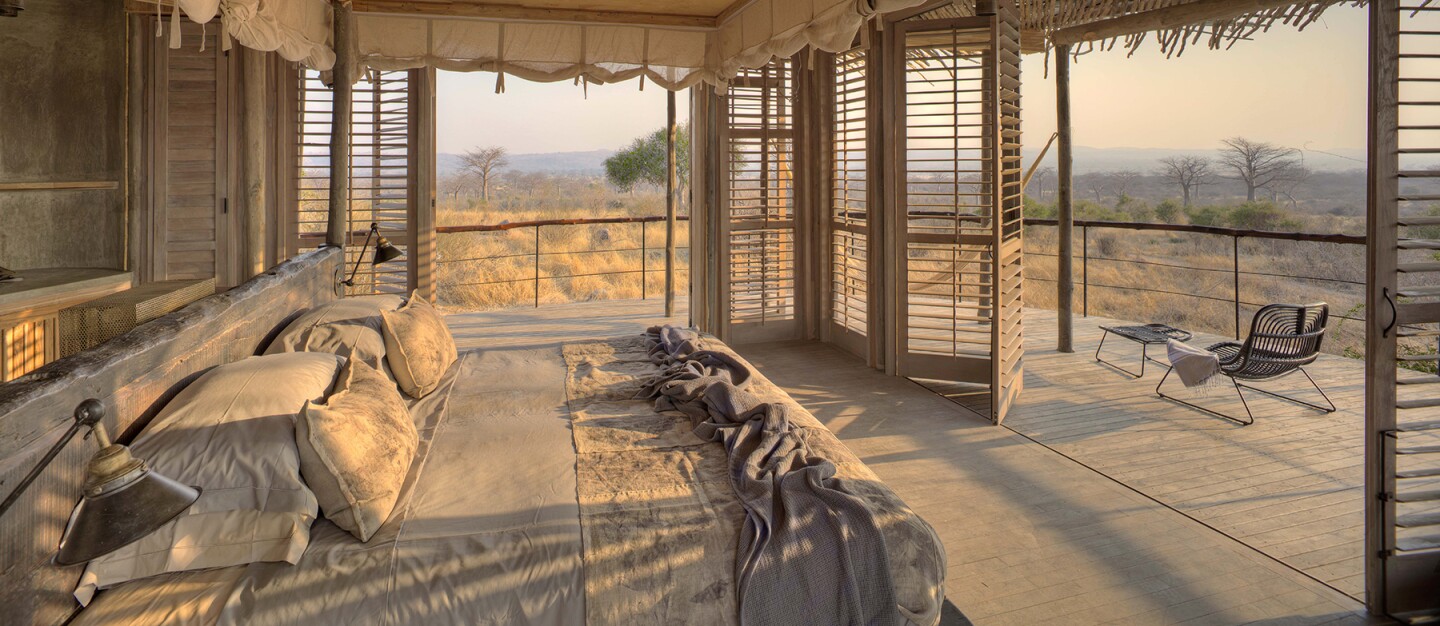
Asilia Jabali Ridge
With nearly two dozen national parks , Tanzania contains some of Africa’s largest remaining unfenced wilderness areas. It’s home to wildebeest who roam together in numbers upwards of a million and make dramatic crossings through the country’s river systems. Those who want to see the river crossings should aim for July to September, but the November-to-March green season can be even more appealing—the rains are short, there are fewer crowds, and you can catch the excitement of calf birthing season.
Serengeti-Mara Ecosystem
Tanzania’s most famous park gets the lion’s share of attention for being the site of the seasonal Great Migration of wildebeest. andBeyond Grumeti Serengeti River Lodge is well situated right in the path of a major river crossing area. A 2022 refurbishment transformed the camp into a design-driven retreat with sustainably sourced local hardwoods and colorful kitenge fabrics inspired by the region’s craft traditions. The camp, which now runs on 80 percent solar energy, offers plenty of ways to get outside of the safari vehicle, whether you’re tracking elephants on foot or visiting fishing communities on nearby Lake Victoria.
Sitting within the greater Serengeti-Mara ecosystem on its own 350,000-acre reserve, Singita Grumeti operates five lodges and camps, each with their own approach to the safari experience. There’s the hilltop Sasakwa Lodge, with its chandeliered guest rooms featuring four-poster beds, deep soaking tubs, and plunge pools that overlook the savanna. The lodge doubles as a museum, with rare artifacts from all over Africa and photography by the likes of Peter Beard. The recently renovated Sabora Tented Camp—an AFAR favorite—offers a more intimate connection with nature, thanks to outdoor showers and canvas walls that let all the noises of the bush lull you to sleep (or keep you awake).
Ruaha National Park
Ask a seasoned safari hand what their favorite wilderness area is in Tanzania, and there’s a good chance they’ll tell you it’s Ruaha National Park. Less-visited Ruaha happens to be the country’s second largest national park, and you could spend an entire trip exploring its widely varied landscapes, which range from miombo forests to sprawling wetlands. Asilia Africa’s camps offer a variety of experiences.
Located on a boulder-filled hill near the Mwagusi River, Jabali Ridge is a prime spot for sightings of lion prides and leopards, as well as elephants who dig beneath dry riverbeds in search of water. The design-driven camp itself features eight suites with a soothing palette of grays and natural woods; a massage in the airy spa comes with a soundtrack of birdsong. For those who want a hands-on conservation experience, the new Asilia Usangu Expedition Camp in the remote Usangu Wetlands offers that. It’s located in a former hunting block that the government is now researching and monitoring; Asilia stepped in as a partner to help raise tourism funds to go toward those efforts. Guests can help monitor wildlife by setting up camera traps and studying animal behavior through thermal monocular lenses—and any data they collect supports the research work happening here.
How to book
andBeyond puts together custom trips that include andBeyond Grumeti Serengeti River Lodge and other andBeyond and non-andBeyond camps. Niarra Travel can create individualized itineraries that include andBeyond, Singita, and Asilia camps.

Safari operators like Micato send guests to community-owned conservancies, which are sustainably operated and limit visitation.
Courtesy of Micato / Giuliana Provenzano
Kenya is a mosaic of contrasting landscapes and home to more than 40 distinct tribes and communities . In the arid hills to the northeast, the Laikipia Plateau is the historical land of the Samburu and Kikuyu among others; to the south, a safari in the Tsavo and Amboseli national parks means large elephant herds, self-drive safaris, and views of Mount Kilimanjaro. The iconic savannas of the Maasai Mara National Reserve are where millions of wildebeest known as the Great Migration roam, with hungry predators like lions and cheetahs in tow.
The Maasai Mara
The Mara fills with visitors in the dry period between June and October, when there’s less green foliage to hide wildlife; in July, hundreds of vehicles line the rivers to watch epic wildebeest herd crossings. But a visit outside of high season can be even more rewarding, according to Dennis Pinto, managing director of Nairobi-based Micato Safaris . “The lushness of the landscapes throughout Kenya right after the April rains, during the off-peak green season, makes for a photographer’s paradise,” he said. “Wildebeest, zebra, and multitudes of other plains game being born make April and May such a wonderfully literal time of renewal—along with the predators looking for easy prey.”
Micato frequently sends guests to the private, community-owned conservancies adjacent to the Mara reserve that are sustainably managing wildlife on their lands—and have more restricted visitation, which translates into fewer crowds, benefiting both visitors and nature. One such camp is the well-appointed, 12-tent Mahali Mzuri , a Virgin Limited Edition camp that leases land from the Masai-owned Olare Motorogi Conservancy .
Tourism on conservancies creates jobs and supports the creation of roads, schools, scholarships, hospitals, and enterprises such as basketry, according to Vincent Oluoch, the program officer who oversees tourism for the Kenya Wildlife Conservancies Association , which represents 174 conservancies across Kenya. Since the height of the pandemic, “most facilities within the conservancies have started experiencing a steady increase in visitor numbers, including domestic visitors, and in turn have started generating necessary revenues,” said Oluoch.
Some conservancies operate their own tourism businesses—often at gentler prices than international lodges. Oluoch recommends a safari in the Nashulai Maasai Conservancy , which owns and manages Oldarpoi Mara Camp , a series of midrange cottages and tents with en suite bathrooms and Maasai design touches. In the Tsavo Conservation Area, he suggests the recently renovated Kivuko Eco Camp , composed of a family house and camp accommodations run by the Taita Wildlife Conservancy.
Nairobi-based luxury outfitter Micato Safaris , owned and run by a Kenyan family, can arrange a custom-designed itinerary in Kenya that takes travelers to such private conservancies as Olare Motorogi and the Tsavo Conservation Area as well as the Maasai Mara National Reserve. Ask it to work in a couple of days in Nairobi, a vibrant city the company knows particularly well. Travelers can also book experiences directly through some conservancies, including Nashulai .
South Africa

The Tswalu Kalahari Reserve, in South Africa, is a popular—and malaria-free—spot.
Courtesy of Your Private Africa
With its winelands, grasslands, ancient forests, and windswept coasts, rural South Africa offers something for nearly everyone. Varying experiences also make it a year-round destination, with the cooler months falling between July and September.
Kruger National Park
In the country’s popular Kruger National Park, dry season falls between April and October. Green season can be a great option for those in search of better prices and fewer people. Showers are often brief, and less dust from the rain makes for beautiful light.
London-based tour operator Byron Thomas founded Niarra Travel in May 2021 to ensure that as much money travelers spend in a destination stays there—especially at smaller camps with few rooms that don’t have a lot of earning power. “Niarra’s goal is to get as much money to the destination as possible, and the best way to do this is booking directly,” said Thomas. “The second best way is to use a tour operator who has a real, vested interest in making sure they provide that service of putting together a trip that’s the right one for you as cheaply as possible for the particular destination.”
The Cape Town region
Niarra takes a 10 percent commission from companies on the ground, much lower than the industry standard, which can reach as high as 35 percent. The company also partners with responsibly run businesses with guidance from such groups as the Long Run , an organization that helps nature-based tourism businesses to drive such sustainability initiatives as community well-being and land and wildlife conservation. The 11-day Family Adventure itinerary starts with whale watching in the De Hoop Nature Reserve near Cape Town while staying at the four-bedroom Morukuru Ocean House. It continues to the malaria-free Madikwe Game Reserve, which has sunny days for much of the year. Game drives lead to lion, leopard, and elephant sightings, and guests sleep at the three-bedroom Morukuru River House .
Sabi Sand Game Reserve
For a safari that’s both ecofriendly and stylish, Nick Bay, founder of Seattle-based tour operator Your Private Africa , recommends Cheetah Plains in the Sabi Sand Game Reserve. Electric, solar-powered game drive vehicles offer not just a zero-emissions game drive but also quieter encounters with wildlife. The modern-feeling villa accommodations are a sight on their own, with their minimalistic interiors decorated with the work of contemporary African artists.
The Kalahari Desert
Bay also suggests heading north to the Kalahari Desert near the border of Botswana to experience Tswalu Kalahari Reserve , another malaria-free area set on a former cluster of overgrazed farmland that South Africa’s Oppenheimer family purchased and helped to rewild. Today it’s home to brown hyena, meerkats, desert black rhino, and large predators, including cheetah. Tswalu has an on-site researcher, Wendy Panaino, who is dedicated to studying ground pangolins , the world’s most trafficked animal, which can be found on the reserve.
Tswalu’s accommodations include the Tarkuni villa, a large home perfect for families. “The villa is especially family friendly, which is an emerging trend for safaris—bringing children six and under,” said Bay.
U.K.-based Niarra Travel offers several South African itineraries including the 11-day Cape, Wine, Wildlife, and Waterfalls, which goes to Kruger National Park and the country’s famous winelands. The 11-day Family Adventure in South Africa trip visits the malaria-free Madikwe Game Reserve for glimpses of big cats and elephants and the coastal De Hoop Nature Reserve for whale watching. U.S.-based Your Private Africa arranges customized private safaris for a wide range of travelers and budgets from start to finish, and it can organize hands-on conservation experiences at places like Tswalu.

Consider Chiawa Camp for a family-friendly safari.
Courtesy of Classic Portfolio / TCunniffe
Home to the Zambezi, Kafue, and Luangwa rivers, and sharing roaring Victoria Falls with neighboring Zimbabwe, Zambia offers a wide range of land- and water-based wildlife experiences. Safaris here are characterized by small, family-run camps that put guests especially close to nature through walking safaris, for which the country is famous (yet it’s still one of southern Africa’s less visited destinations). The popular dry season falls between July and November, but the April to June shoulder season, when the landscape turns green in the wake of the rains, is an especially good time to see Victoria Falls.
“Zambia is personally my ultimate safari experience,” said Suzanne Bayly-Coupe, managing director of Classic Portfolio , a collection of 53 independent lodges in 10 African countries. “It is one of the very few countries that has not been dominated by the bigger commercial safari companies.” According to Bayly-Coupe, Zambia’s water-based wildlife experiences rival those of the Okavango Delta in Botswana.
Lower Zambezi National Park
She recommends Chiawa Camp in Lower Zambezi National Park, which offers canoe rides along the crocodile-filled Zambezi River and has a multi-room family tent for parents with kids; about 20 miles to the east at Old Mondoro , five riverside chalets all have outdoor baths. In South Luangwa National Park, also known as valley of the leopard, add on a few nights at one of the half dozen tiny camps run by the Bushcamp Company .
South Luangwa
Niarra will soon add a trip in partnership with Green Safaris , which operates camps with light footprints, including the canvas-tented Shawa Luangwa Camp in South Luangwa. “We’ve been really impressed with the aptly named Green Safaris, which are all off-grid and all electric, including vehicles, bikes, and boats, and they’re doing a lot of good work on the ground,” Thomas said.
Lower Zambezi
According to Bay, some of the newest camps in Zambia focus on energy efficiency, resource conservation, and community capacity building. They include Lolebezi Safari Lodge in the Lower Zambezi, which is powered by solar panels, has its own water treatment plant, and was built with minimal use of concrete.
Livingstone
One of his favorite lodges in Zambia is Royal Chundu Island Lodge in Livingstone, which is easy to reach because of its location near Victoria Falls and an international airport. “Aggie Maseko, one of the owners, is a hospitality maven and makes it hard to ever leave,” said Bay. “The menu is composed of local ingredients elevated to French Relais & Châteaux standards.” Take a boat transfer to Katombora Island on the Zambezi River, where four sprawling villas have their own private river-facing decks that hover 40 feet above the ground. Go on a day tour to nearby Chobe National Park in neighboring Botswana for sightings of lions, cheetahs, wild dogs, and giraffes.
Book a tailored trip through southern Africa with these Classic Portfolio properties through such outfitters as Africa travel experts Explore Inc. or Your Private Africa. Niarra Travel offers a 13-day Victoria Falls, Okavango, and Cape Town itinerary that incorporates the Zambezi River and Falls into a three-country itinerary (Zambia, Botswana, and South Africa).


- South Africa
- The Ultimate Safari Planning Guide
- Safari Packing List
- Safari Luggage
- Safari Budget Guide
- Safari Reading List
- First-Timer’s Tips
- A Typical Day on Safari
Africa , Botswana , Kenya , South Africa
Where to go on safari in africa.
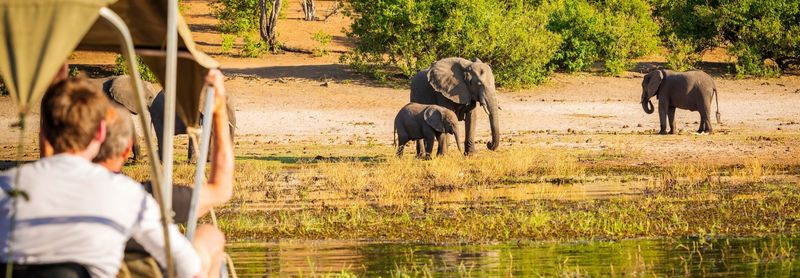
Once you’ve decided an African safari is your dream holiday (and who can blame you?!) the fun can really start. But where to go on safari?
There are numerous places in Africa that offer opportunities aplenty to see all of the Big 5, as well as many other endangered and beautiful species.
This post shares the best places in Africa to head out on safari, to help you choose the best destination for you. We’ll share the pros and cons of each African safari destination, as well as our own opinion on our favourite safari destinations. We’ll round it all off with a dedicated quiz, to guide you through the decision-making process based on your budget, your tastes, when you’re travelling and your favourite animals too.
So keep reading, and you’ll soon know where to go on safari next. Let’s get started:
Best for: A multi-activity holiday, where safaris form just one part.
Whenever I’m asked to recommend a good first-timer’s safari destination, I always say South Africa .
It was the first place we headed, and therefore where our love of safari began. Not only is it more budget-friendly than a lot of other African destinations due to the sheer amount of choice available, but it also offers lots of other things to do in case you tire of wildlife viewing (though, how could you?)
Pair a safari holiday to South Africa with a road trip along the Garden Route, where adrenaline junkies can bungee, photographers can marvel at the scenery, and wine and culture lovers can enjoy South Africa’s mother city of Cape Town. What’s not to love?
Sightings of the Big 5 are common in the major national parks and game reserves, but smaller private reserves offer a more intimate experience with sundowners, off-roading and bush walks too. It’s well worth searching these lodges out.

Struggling to choose between South Africa and Botswana ? Our guide compares the two, so you don’t have to!
Fast facts about South Africa:
- Regular sightings: South Africa is home to all of the Big 5, but you may also be lucky enough to spot a pack of wild dogs, cheetahs, meerkats and hippos.
- Types of safari: Walking safaris, game drives, sundowners, night safaris, photographic safaris.
- Budget: £-£££££
- Best time to go: May-September. The country’s winter months are best for wildlife viewing as there’s little rain or vegetation cover, meaning animals congregate around watering holes to feed and drink.
Best for: Sightings of the Big 5 and the big cats.
If animals are your top priority when choosing your safari destination, there’s nowhere better than Kenya .
Some of the most traditional game reserves and lodges can be found here, in prime position for safari-goers to witness the largest mammal trek in the world – the Great Migration. Thousands of zebra and wildebeest make the treacherous journey from Tanzania to Kenya to find the most plentiful grasslands in July and August. Outside of these months, visitors are treated to exceptional sightings of big cats, huge herds of elephants and birdlife too.
Lodge staff and guides/trackers are often hired from local Maasai villages, offering a unique perspective on the Maasai lands as well as the flora and fauna that live there. Safaris are often accompanied by visits to traditional villages, where you may see mud huts, farmland and displays of music and dance from the villagers.

Fast facts about Kenya:
- Regular sightings: All of the Big 5 and the Great Migration, with sightings of big cats are particularly common in Kenya.
- Budget: ££-£££££
- Best time to go: Visit Kenya between June and September as well as January and February, thanks to the great weather and wildlife spotting opportunities around the waterholes. If it is your dream to see the Great Migration, go in August.
Best for: A twin-centre safari + beach holiday.
Home to the world-famous Serengeti, Tanzania is a dream destination for wildlife lovers in Africa.
The other half of the Great Migration starts here between late April and June when immense herds of zebra and wildebeest head north after giving birth to their offspring. Visitors line the river banks and predator-rich plains as they watch the most incredible wildlife spectacle in the world.
Besides the wildlife, another huge draw for visitors to Tanzania is its natural beauty. In the north of the country, you’ll find Africa’s highest peak, Kilimanjaro, while just off the eastern coast, the tropical island of Zanzibar makes Tanzania an ideal twin-centre destination for both a safari and the beach.

Fast facts about Tanzania:
- Regular sightings: All Big 5, predators including cheetahs, hyenas and jackals.
- Best time to go: Visit between July and October, when Tanzania is at its driest. This also coincides with the Great Migration river crossings but, just like in Kenya, the dry season offers amazing wildlife sightings across the whole of Tanzania at this time.
Best for: An unforgettable water-based safari in the Okavango Delta.
Botswana is widely considered to be one of the best places in Africa to go on safari thanks to its beautiful landscapes, varied wildlife and exceptional hospitality .
If you’re heading to Botswana for the wildlife, no trip would be complete without taking in the Okavango Delta. Here, lucky visitors can spy on elephants, hippos and other water-based animals from a serene trip on a dug-out canoe or a motorised boat, while traditional game drives in the area are also filled with sightings of the big 5.
For an experience almost polar-opposite to the Okavango Delta, Botswana is also famous for the Makgadikgadi Pans. A dried-out lake, this is considered to be the largest salt flat in the world, and a wonderful place to see hardy species including meerkats, aardvarks and brown hyenas, as well as dark-maned lions and cheetahs chasing their prey.

Fast facts about Botswana:
- Regular sightings: All of the Big 5, as well as many other popular African safari animals like cheetahs, wild dogs, hippos and thousands of species of birds too.
- Types of safari: Walking safaris, game drives, sundowners, night safaris, photographic safaris, and boat safaris.
- Best time to go: Head to Botswana during the dry season between June and September, which brings high water levels in the Okavango Delta and beautiful weather.
Best for: Coming face-to-face with primates in their natural rainforest habitat.
Uganda is one of the only countries in the world you can see gorillas in their natural rainforest habitat.
Visitors flock to Uganda (and neighbouring Rwanda) to lay eyes on a gorilla family as they rest groom and chew on bamboo shoots. The aptly named Impenetrable Forest is where you’ll find them, but you’ll need to rise early, climb difficult terrain and trek in humid conditions for this experience that will stay with you forever.
Uganda’s rainforests are also home to incredible populations of other animals, including chimpanzees, monkeys and many bird species. But those in search of a more traditional safari should head to Queen Elizabeth National Park for encounters with the Big 5, away from the crowds.

Fast facts about Uganda:
- Regular sightings: Gorillas, chimpanzees and monkeys in the rainforests, as well as the Big 5 in the National Parks.
- Types of safari: Walking safaris, game drives, photographic safaris, gorilla trekking safaris.
- Best time to go: Visit during its two dry seasons: between December and February, and between June and August, when conditions are particularly good for gorilla trekking.
Best for: Gorilla trekking through Volcanoes National Park.
With its spectacular landscapes and gorillas among its mountains, Rwanda’s not called ‘the land of a thousand hills’ for nothing.
For many, the biggest draw of a trip to Rwanda is the opportunity to see mountain gorillas in Volcanoes National Park, but Nyungwe is also a wonderful place to spot chimps and 12 other species of primate. Here, the Canopy Walkway (a large suspension bridge) offers beautiful views right across the park.
More traditional safaris in Akagera National park make it possible to see the Big 5 – but only if you’re very fortunate! Buffaloes and elephants are most common here, with leopards sometimes seen at night. Following the reintroduction of black rhinos and lions in the last decade, sightings of these are becoming increasingly regular.

Fast facts about Rwanda:
- Regular sightings: Gorillas, elephants, buffalo, zebras, giraffes, monkeys and antelope.
- Best time to go: Visit Rwanda during the drier period from June to September, when you have the best chance at spotting the mountain gorilla.
Best for: Viewing wildlife against surreal landscapes and bright red sand dunes.
What Namibia lacks in greenery, it more than makes up for in spectacular wildlife sightings and scenery.
The country is home to almost half of the world’s remaining population of black rhinos, while Etosha National Park is the place to spot four of the Big 5 (everything but buffaloes lives here!) Sightings of cheetahs, giraffes and hyenas are also common. Marine lover? Head to the coast to find Mola molas, whales, dolphins, seals and penguins on tours from Walvis Bay.
Aside from the wildlife, Sossusvlei’s Mars-like landscapes make for beautiful photos. Surrounding this huge, white salt and clay pan and its skeletal trees are some of the highest sand dunes in the world at almost 400m tall. No trip to Namibia is complete without a climb to the very top!

Fast facts about Namibia:
- Regular sightings: Lions, elephants, cheetahs, seals, oryx and the gemsbok – an antelope only found in Namibia.
- Best time to go: Travel to Namibia between July and October for bearable temperatures and dry weather. This is also the best time for wildlife viewing.
Best for: Combining wildlife spotting on walking safaris with trips to the world’s largest waterfall.
Blending a rich history and culture with beautiful natural sights and animals, Zambia may just be Africa’s best-kept secret.
Zambia is considered to be the home of the walking safari and is where many guests ditch the game vehicle and head out on foot. Accompanied by exceptional guides, safari-goers in South Luangwa National Park are often treated to sightings of elephants, antelopes and big cats. Traditional game drives and walking safaris are also on offer in Zambia’s other national parks, so there’s something for everyone here!
Beyond the wildlife, head to the border with Zimbabwe for an exhilarating experience at the spectacular Victoria Falls. Here, you can enjoy a bungee jump, join a walking tour, take to the skies in a helicopter or negotiate the rapids of the Zambezi in a raft.

Fast facts about Zambia:
- Regular sightings: Elephant, hippo, buffalo, zebra, lion, leopard and hyena.
- Types of safari: Walking safaris, game drives, night drives, photographic safaris, and boat trips.
- Best time to go: The best time to visit Zambia is during the dry season between June and November. At this time of year, the days are hot but the nights are cool.
Best for: Witnessing one of the most bio-diverse countries in the world.
A place unlike any other, Madagascar is home to animals you simply won’t find anywhere else in the world.
The island’s rainforests are teeming with wildlife, including over 100 species of lemur which are native only to Madagascar. Lucky visitors can spot the cuddly ring-tailed lemurs and ruffed lemurs among many others, swinging from the trees in search of fruit. Carnivore fans will be in constant search of the fossa, Madagascar’s top predator, which, despite its resemblance to a small cougar, isn’t actually a cat.
Madagascar’s position in the Indian Ocean makes it an ideal wildlife destination for those in need of relaxation, thanks to its beautiful landscapes, coral reefs and tropical sandy beaches.

Fast facts about Madagascar:
- Regular sightings: Lemurs, cat-like fossas and many species of birds and reptiles.
- Types of safari: Walking safaris, game drives, photographic safaris, boat safaris
- Best time to go: Travel between September to October when the weather is mild and the lemurs are more active.
Best for: Mixing elephants with natural wonders, including the thundering Victoria Falls.
Home to one of the largest populations of elephants in the world, Zimbabwe is a mainstay on many safari lovers’ bucket lists.
Occupying an area similar to Belgium in size, Hwange National Park is the largest wildlife reserve in Zimbabwe, perfect for game-rich safari sightings. As well as elephants, the rest of the Big 5 can be found here, along with one of Africa’s largest surviving populations of wild dogs.
For those looking for more, Zimbabwe offers a range of natural wonders to see alongside its wildlife. Head to the northern border to view the thundering Victoria Falls. Adrenaline seekers will love the adventurous activities available nearby, including zip lining, abseiling and white water rafting on the Zambezi.

Fast facts about Zimbabwe:
- Regular sightings: All of the Big 5, wild dogs and unusual antelope like sable and roan.
- Types of safari: Walking safaris, game drives, sundowners, night safaris, photographic safaris, boat safaris
- Best time to go: Visit Zimbabwe between July and October, when game viewing is at its peak around the lakes, man-made waterholes and rivers.
If you’re still not sure where to go, spend a few minutes taking the interactive quiz coming soon. Just know that, wherever you choose, you’re in for a real treat and it won’t be long before you tick them all off your list!
Anna is the founder of Really Wildlife. She's a 30-something lover of wildlife travel, vegetables and listening to the Lion King soundtrack on full blast.
A day on safari in Africa: what you can expect in camp and in the wild
Oct 22, 2019 • 5 min read

A luxury camping tent in the southern section of Serengeti National Park, Tanzania © Jonathan Gregson / Lonely Planet
If you’ve never before been on safari, one of the great pleasures of travelling in Africa awaits. If you’re lucky, you’ll spend your days tracking down one species of charismatic megafauna after another, from elephants and rhinos to big cats, buffaloes and giraffes. But what does a typical day on safari really involve?
Although experiences will vary depending on your budget and the type of accommodation, whether you’re camping, sleeping in lodges, or glamping under canvas in a luxury tented safari camp, some elements remain constant. Here’s what to expect.

Most days on safari begin before dawn. While watching the sunrise in Africa is reason enough to rise before the sun, you’re also up early because the first two hours of daylight are the best times to see wildlife – in the cool of early morning, most animals are out and about and active (even some of the nocturnal species such as hyena). Even so, there should be no need for an alarm clock – on most safaris, a camp attendant will wake you, a quiet African voice coming from the darkness. Sometimes you’ll be served tea and coffee in your tent, and there may be light breakfast snacks available in the camp’s communal areas while everyone assembles.

As close to dawn as everyone can manage, you’ll be on the trail of wildlife, most often in an open-sided safari vehicle with tiered seating. The norm is that you’ll share these vehicles with other guests (private vehicles cost extra), but they’re rarely crowded. The better camps will provide you with blankets – mornings can be decidedly (and, for some, unexpectedly) chilly! Sometimes called ‘game drives’ in a nod to the safari drives of old, wildlife drives can last for two hours or even twice that – it all depends on what’s happening in terms of wildlife sightings. Very often, guides and drivers from the same camp will be in touch with their colleagues over the radio to make sure that everyone in camp gets to see the same wildlife where possible.

Drives in 4WD vehicles are the most common ways to explore, though walking safaris are sometimes a possible alternative if you're staying in a private conservancy; outside of Zambia, Zimbabwe and South Africa, walking options are rarely permitted in national parks. Boat excursions are another possibility in some areas, such as the dugout canoe ( mokoro ) trips in the Okavango Delta , Canadian-style canoes on the Zambezi in Zimbabwe (Mana Pools National Park) and Zambia (Lower Zambezi National Park), or the powered sightseeing boats in Botswana’s Chobe National Park or Tanzania’s Selous Game Reserve .
The heat of the day
On most days, you’ll be back in camp by mid to late morning. A more substantial breakfast or brunch usually follows, although sometimes this meal is served a little later as lunch. Whatever you call it, this meal is often followed (and sometimes preceded) by free time – have a siesta, laze by the pool if there is one, or simply find a vantage point from which to contemplate the beauty of wild Africa. If your safari experience includes the option of a visit to a local village or some other non-wildlife excursion, then it will most likely occur around this time.

Afternoon tea – sometimes called high tea – is an old safari tradition, and is ordinarily served around mid-afternoon, between 3pm and 4pm. How much food and drink are offered varies from camp to camp, but you’ll rarely leave hungry, and high quality cuisine is increasingly a part of the safari camp offering.

Late afternoon & evening
As the heat of the day passes, you’ll leave camp for another wildlife drive (or walk, or boat excursion…). These usually last for a couple of hours, and before you return to camp, most safari drives will pause at a scenic site for what’s known as the 'Sundowner', another venerable old safari custom. Nursing the drink of your choice while watching the sunset overlooking a waterhole or acacia-framed golden grasslands of the savannah – bliss!

If you’re visiting a national park, you’ll need to leave the park (if you’re staying outside) or be back in camp (if you’re staying inside) before the sun sets. If, on the other hand, you’re staying in a private or community-run conservancy, there are fewer (very often no) restrictions about driving after dark. In such cases, you’ll return later to camp on some nights, taking advantage of the opportunity to spot nocturnal species using an animal-friendly spotlight. While this could be all kinds of species that you can also see during the day, a night drive opens up a whole world of other possibilities, including rarities such as aardwolves, civets and aardvarks. Another advantage of these conservancies is that, day or night, your driver may be allowed to drive off-road as they try to find wildlife.
Whenever you arrive back in camp, you’ll be given time to freshen up, and change for dinner. In the more luxurious lodges and camp, you may be expected to dress for dinner as you might in a high-class restaurant. More often, a change of clothes is more about comfort than dress codes. Before and after dinner – which in most camps and lodges is the main meal of the day – there’s usually an open fire burning where you can take your evening drink to stare into the fire or talk with other guests. In some camps, there may be a pre-dinner lecture by a naturalist or some form of cultural entertainment.
When it comes time to return to your tent or room, chances are that you’ll be escorted by a camp attendant with a torch, just to make sure that you don’t stumble upon an elephant, lion or buffalo that may be hanging around camp at night. And then the lights go out and you fall asleep to a chorus of the night noises of Africa.
You might also like: Where you should go on your first safari in Africa The joys of a mobile safari The story of lions (and your guide on where to see them on safari) Are you ready for a self-drive safari in Africa?
Explore related stories

Wildlife & Nature
Feb 20, 2024 • 17 min read
If you’ve never been to Africa before, you’ve much to look forward to. But choosing where to go on your first safari is quite daunting. Here is our guide.

Feb 12, 2024 • 10 min read

Jan 30, 2024 • 8 min read

Jan 5, 2024 • 19 min read

Dec 17, 2023 • 4 min read

Nov 25, 2023 • 6 min read

Nov 22, 2023 • 8 min read

Nov 21, 2023 • 7 min read

Nov 2, 2023 • 5 min read

Oct 31, 2023 • 8 min read


Destination
- Sao Tome & Principe
- South Africa
- New Zealand
- French Polynesia
- United Kingdom
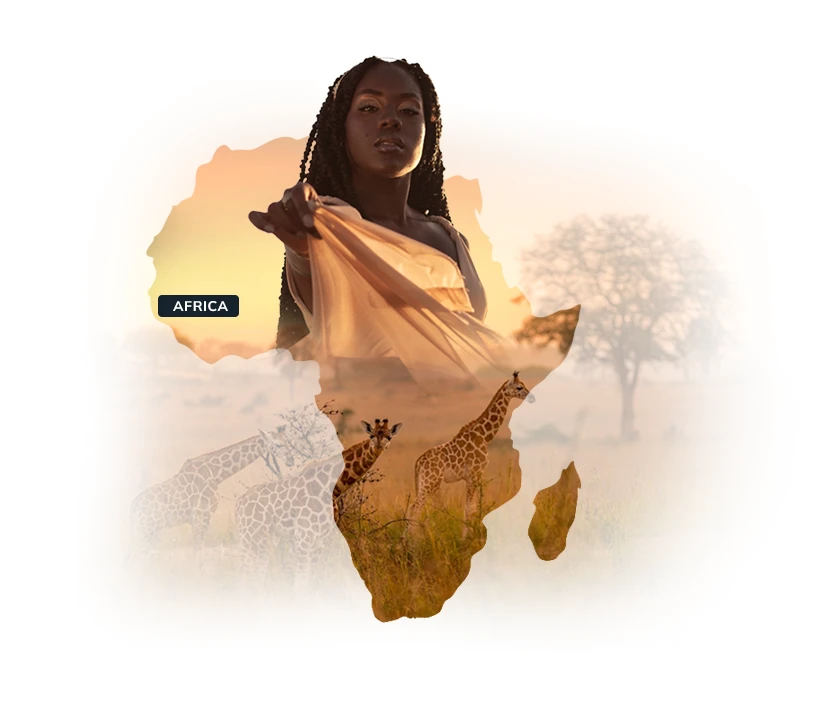
Australasia & South Pacific
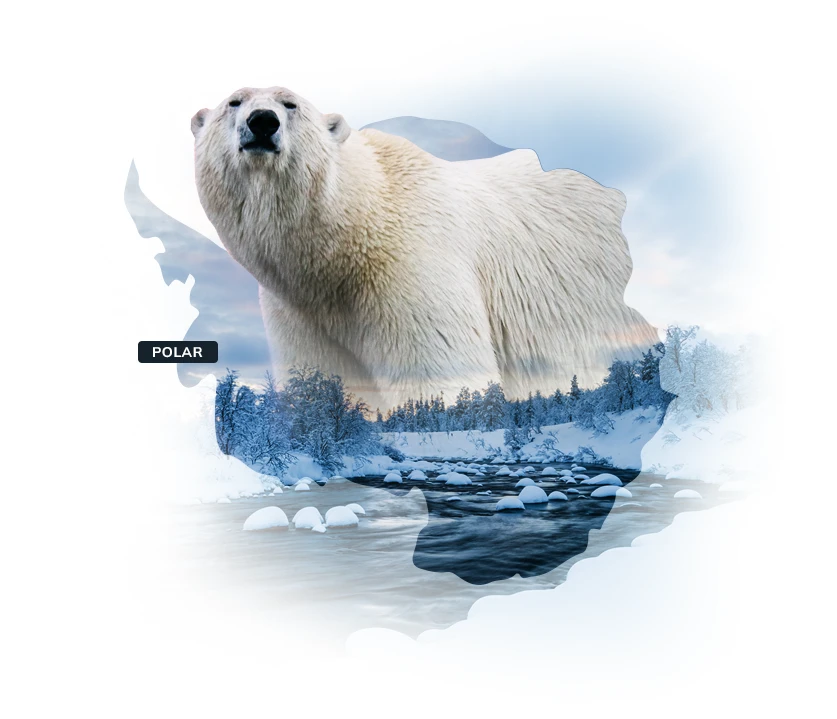
Latin America

Middle East
- Wayfairer Experience
- Responsible Travel
- Eco by Wayfairer
- Eco Gold by Wayfairer
- Beach Holidays
- Conservation Focused Holidays
- Family Beach Holidays
- Family Holidays with Babies
- Family Holidays
- Family Safari Holidays
- Luxury Holidays
- Safari and Beach Holidays
- Safari Holidays
- Trekking Holidays
- Travel Inspiration Travel Inspiration
- Get in touch +44 117 313 3300 [email protected]
12 Places to Go for the Best Safari in Africa

Discover where you should go for your perfect African safari
An African safari holiday features on most travel bucket lists, but with so many incredible wildlife destinations to choose from, how do you know where to go for the best safari in Africa?
Your choice depends on what you’re looking for: a particular species you want to see in the wild, the type of safari holiday you’re interested in (walking, game drives, camping, luxury) and who you’re travelling with, especially if you’re planning on doing a safari with kids or require an accessible safari holiday .
Here, we break down 12 popular places to go for the best safari holidays in Africa by country, with summaries of the kind of holiday you can expect to enjoy there, what to see and do, the best national parks and game reserves to visit, as well as the wildlife watching opportunities there are to enjoy.
Botswana Safaris
Kenya safaris, madagascar safaris, malawi safaris.
- Nambia Safaris
Rwanda Safaris
South africa safaris, swaziland (eswatini) safaris, tanzania safaris, uganda safaris, zambia safaris, zimbabwe safaris.

Africa’s Last Great Wilderness
Botswana has evolved as a safari destination free from fences and farmlands, which has resulted in a vast wildlife haven with high concentrations of big game, from prowling lions to herds of buffalo. The country’s natural landscapes are awe-inspiring too, from baobabs on the salt pans to stunning desert sands.
Learn about the bush from those who know it best, the San of the Kalahari , who have used the environment for thousands of years and run bushwalks for visitors. This safari destination is also known for wilderness camping (spend a night or two out of the lodge and sleep under the stars for a real treat), as well as flexibility for accessible and wheelchair-friendly safaris.
Botswana’s Best National Parks & Game Reserves
Chobe National Park , the Okavango Delta , Nxai Pan National Park, Makgadikgadi Pan , Moremi Game Reserve and Central Kalahari Game Reserve.
Botswana’s Wildlife
Botswana is home to over 130,000 elephants, boasting more of these creatures than anywhere else in the world, with herds numbering up into the hundreds. Other notable species to look out for include black-maned lions, big cats, herds of zebra, bathing hippos and a wide variety of birdlife.
Why we love it

The Classic African Safari
Kenya is one of Africa’s best safari destinations and one of the most well-known, famous for its colourful tribes, the Great Migration, Africa’s “Big Five” and stretches of savannah lit up in golden sunset colours. When you think of safari, you’re thinking of Kenya.
However, Kenya’s landscape has more to offer beyond the acacia trees. There are snow-capped mountains, vast deserts, thick jungle and gorgeous coastlines and beaches – the perfect relaxing end to any safari holiday.
Kenya’s Best National Parks & Game Reserves
Masai Mara National Reserve , Amboseli National Park , Samburu National Reserve , the Laikipia Plateau and Lake Nakuru National Park in the Great Rift Valley .
Kenya’s Wildlife
Kenya is a Big Five safari destination, with plenty of opportunities to see lions, elephants, leopards, buffalo and the endangered black rhino. Kenya’s Masai Mara is also the home of the Great Migration, where millions of zebra and wildebeest move in an annual cycle around Tanzania’s Serengeti and the Masai Mara. Other species to look out for include baboon, flamingo and giraffe, with the latter being a special point of interest at the “Instafamous” Giraffe Manor .
One of my favourite safari experiences was fly camping in Kenya’s Masai Mara, sleeping out under the wide, starry sky and hearing a lion’s roar in the distance. Walking between the multiple fly camps really takes safari to another level and chatting to my local Maasai guide was a real insight into local life.

Lemurs, Lemurs Everywhere
Although an incredible 90% of Madagascar’s forests have sadly been destroyed, the flora and fauna of this unique island can be found nowhere else in the world. 5% of all known plant and animal species can be found here and only here - meaning that it’s more important than ever to protect the country’s 25 national parks and the endemic wildlife species which lives in them.
Don’t miss the unique Malagasy culture, with influences from Borneo, Polynesia, France as well as East Africa. The fusion cuisine and cultural mix here is truly one of a kind, with a focus on ancestral worship and local taboos, called “fady.” Canoe along the river for the easiest access around the island, camping in remote spots and meeting village communities along the way.
Madagascar’s Best National Parks & Game Reserves
Amber Mountain National Park, Andasibe-Mantadia National Park, Andringitra National Park, Ankarafantsika National Park, Isalo National Park and Ranomafana National Park.
Madagascar’s Wildlife
It’s believed that Madagascar’s diverse range of lemur species evolved after they floated to the island around 60 million years ago. Today, there are over 100 species of lemur, all of which are endemic to the country. You’ll most likely recognise the panda-faced ring-tailed lemur, the “dancing” sifaka and the indri, which has a call much like whale song.
Other species to look out in Madagascar include endangered chameleons, cat-like fossa, brightly-coloured frogs and insects, as well as a few pesky animals missing from the Central Park Zoo…
Madagascar is the county for true lovers of the weird, wonderful and absolutely marvellous! Venture into the parks to find some of the amazing animals that call this island home, but spotting chameleons in the garden of your lodge is just as thrilling as seeing lemurs bound through the trees. And the wildlife is not only on land - look to the oceans to see whales, dolphins, sharks and pristine dive sites

Lakeside Relaxation & Laidback Locals
Little Malawi is one of southern Africa’s least visited countries, but this landlocked safari destination has wildlife in abundance. The local culture is not to be missed either and many visitors comment on the friendliness of the people, who are renowned for being warm, happy and always smiling.
Despite the country’s diminutive size, Malawi is home to Africa’s third-largest lake (Lake Malawi) and lake activities such as diving, snorkelling, kayaking, island-hopping and beach sunbathing are great ways to wind down post-safari.
Malawi’s Best National Parks & Game Reserves
Liwonde National Park, Nyika National Park and Majete Wildlife Reserve.
Malawi’s Wildlife
Poaching was once rife across Malawi, but conservation initiatives led by African Parks has relocated animals back into the country, including the famous Big Five. Majete Wildlife Reserve was African Parks’ flagship project in 2003 and the organisation has since gone on to introduce similar projects in many other African safari destinations, including Rwanda and Zambia.
Today, Malawi’s specialities include hippos, crocodiles, the endangered black rhino and lions, thanks to recent reintroduction programmes. Birders will also love Malawi for the 400 species of feathery friends found here.
Likoma Island in Malawi is a hidden gem: a beach destination in a landlocked country. This is one of the most peaceful places to end your holiday, with calm, clear turquoise water and the most incredible food. The lovely people make you feel so welcome and exploring the amazing work shops of Katundu show you their incredible talent.

Namibia Safaris

A Photographer’s Dream
Namibia is known for its otherworldly landscapes as much as its rich wildlife and excellent national parks. Photographers will love the Namib (the world’s oldest desert), the orange sand dunes of Sossuvlei, the barren clay pans of Deadvlei, shipwrecks off the Skeleton Coast and the abandoned town of Kolmanskop, half-submerged in sand.
Though Namibia is one of the least populous countries in the world, it’s also home to diverse native groups, including the Herero, the San of the Kalahari and the Himba, instantly recognisable by the ochre cream they use on their skin and hair.
Namibia’s Best National Parks & Game Reserves
Etosha National Park, Sossusvlei and the Skeleton Coast.
Namibia’s Wildlife
Boasting more wild animals than people, Namibia is another fantastic Big Five safari destination. With well-maintained roads and well-mapped routes, Namibia is also popular as a self-drive safari destination (or even a flying safari destination , if you’d rather make the most of your time and enjoy bird’s eye views). Etosha National Park sees elephants, giraffes, zebras, jackals, lions and leopards, as well as endangered black and white rhinos.
The sense of space, peacefulness and being in a natural environment; miles upon miles of sand dunes and rugged landscapes; the natural spectacle of seeing the sand dunes change colour as the sun sets. It is always a surprise when I arrive back into the relative hustle of Windhoek.

Gorillas in the Mist
Little Rwanda is a much smaller country in comparison to other big African safari destinations, however it makes up for size with astounding natural beauty: mountain ranges, shimmering lakes and lush tropical rainforest.
Outside the jungle, Lake Kivu offers swimming, kayaking and even scuba diving; whilst capital Kigali is one of Africa’s safest and cleanest cities. Though Rwanda’s horrific past has not been forgotten, the country is looking to the future and has become a leader in conservation and responsible tourism.
Rwanda’s Best National Parks & Game Reserves
Akagera Parc, National des Volcans and Nyungwe Forest National Park .
Rwanda’s Wildlife
Rwanda is a primate haven. Trekking through the country’s thick rainforests , you’ll meet native golden monkeys, colobus monkeys, chimpanzees and some the world’s last remaining troops of mountain gorillas, including powerful silverbacks.
A trek to see the gorillas here can be a longer and more challenging trek than in Uganda, as the Volcanoes National Park has typically denser forest and the families can be trickier to find. Consider the Nyungwe Forest National Park for bird spotting and primate tracking, or the beautiful shores of Lake Kivu. Rwanda is more off the beaten track, so now is the time to go and see this fantastic region.

Cool Cities & Epic Road Trips
Think of South Africa and you’ll think of laidback Cape Town , Table Mountain, surfers, scenic coastal drives, world-class wines and stunning beaches. The country is all this and more, with a diverse range of landscapes and activities to enjoy, known as one of Africa’s most popular holiday destinations for safaris and beyond.
The cities of Durban, Cape Town and Johannesburg offer culture and excellent international cuisine. The Winelands are perfect for gourmet vineyard tours, whilst the dramatic peaks of the Drakensberg escarpment descend down to beautiful tropical beaches. Our personal highlight of South Africa has to be a drive along the Garden Route , one of the world’s best road trip destinations.
South Africa’s Best National Parks & Game Reserves
Kruger National Park , Kwandwe Game Reserve, Amakhala Game Reserve, Hluhluwe Game Reserve and Madikwe Game Reserve.
South Africa’s Wildlife
South Africa is a Big Five safari destination, with elusive black and white rhino found at national parks such as Kwandwe and Amakhala. Big cats such as lions and leopards are also common, whilst the shy cheetah is most often seen in central Kruger. Outside of the game-rich national parks, you can also go whale watching in Hermanus or join African penguins on the beach.
An amazing destination that screams diversity from its amazing destinations to its people. Whether you looking for a holiday in one of Africa most cosmopolitan cities, tasting some of the best wines in the world, visiting wild animals in their most natural environment or even enjoying a holiday along the coast, South Africa has it all.

Self-Drive Adventures & Thriving Wildlife
If you’re looking for a more off-the-beaten-track African safari destination, then little Swaziland (recently renamed eSwatini, though Swaziland is still in common use) is the place to go. An island of land encased within South Africa, Swaziland is roughly half the size of Belgium or slightly smaller than the state of New Jersey.
However, its small size has no relation to its diverse and plentiful wildlife, making the country a great safari destination in itself or a great stop to include on a South Africa safari holiday, especially for self-drive tours due to easy border crossing and close proximity to South African national parks such as Kruger and Hluhluwe.
Swaziland’s Best National Parks & Game Reserves
Hlane Royal National Park and Milwane Wildlife Sanctuary.
Swaziland’s Wildlife
Due to highly effective anti-poaching units, Swaziland has grown its populations of endangered species, encouraging local communities to engage with nature and nurture conservation. In the big game parks, sightings include lion, giraffe, elephant, vultures, marabou, roan antelope, sable antelope, buffalo, black rhino and white rhino.
A hidden gem in the south, Swaziland offers a very unique experience with fantastic cultural experiences. I visited Milwane Sanctuary as I passed through en route to Durban (South Africa) and enjoyed every second of my stay. The scenery is beautiful and with no major predators, activities are far more varied and independent. It was fantastic to trek with kudu and warthogs so close.

Tanzania ’s geography covers the mighty Mount Kilimanjaro, the natural phenomenon of the Ngorongoro Crater and a coastline of surprisingly quiet beaches (or if you prefer, a hop over to semi-autonomous Zanzibar ).
Within those environments, you’ll find millions of mammals on the Great Migration across the Serengeti , the largest herds of elephants in East Africa and an abundance of diverse wildlife living on the microcosmic crater floor. Tanzania is deservedly one of the best safari destinations in the world.
Tanzania’s Best National Parks & Game Reserves
Serengeti National Park , Tarangire National Park , Selous Game Reserve , Ruaha National Park , Ngorongoro Crater and Lake Manyara .
Tanzania’s Wildlife
Tanzania is another Big Five safari destination, but you’re really spoiled for choice when it comes to national parks and wildlife. Observe tree-climbing lions, pods of bathing hippos, migratory birds including flocks of pink flamingos, hyenas, cheetahs, giraffes, elephants, jackals, the critically endangered African wild dog (also known as painted wolf), as well as masses of zebra, wildebeest and gazelle on their annual trip around the Serengeti into Kenya’s Masai Mara.
Tanzania is truly extraordinary for its unique topography, bountiful wildlife and warm, welcoming culture. From a safari perspective, the infamous Great Migration in the Serengeti ecosystem draws safari enthusiasts from around the world. Couple this with the Ngorongoro Crater and it’s easy to see why northern Tanzania is so popular as a safari destination. The lesser known safari parks, in the south and to the west, are what we believe safari purists should focus on; Selous, Ruaha, Katavi and Mahale Mountains are all must-haves on any aficionados safari wish list.

Dense Rainforest, Wild Primates & Big Five Safaris
Uganda is green mountains, gorgeous lakes and streams, and the source of the Nile, the world’s longest river. This lush landscape creates a multitude of different habitats for wildlife, making Uganda easily one of the best safari destinations in Africa.
Take a Nile cruise with the crocodiles, visit local tea and coffee plantations, chase waterfalls, go white water rafting, take a game drive to tick off your Big Five and then meet a mountain gorilla in their natural habitat.
Uganda’s Best National Parks & Game Reserves
Queen Elizabeth National Park, Kidepo National Park, Bwindi National Park, Murchison Falls National Park, Lake Mburo National Park and Kibale National Park.
Uganda’s Wildlife
You’ll see Africa’s Big Five here, as well as tree-climbing lions , Nile crocs, hippos and endemic birds species such as shoebill, green-breasted pitta and gray crowned crane (Uganda’s national bird) – Uganda is one of the world’s best birding destinations .
However, one of the main draws is the wide range of primates that call Uganda’s jungles home, particularly the endangered mountain gorilla. Trek to see families of gorillas in Bwindi or participate in the Gorilla Habituation Experience .
Gorilla trekking in Bwindi Impenetrable Forest is such an awesome experience; it’s not only a physical challenge to get to the families of gorillas, but just so special when you reach them. I had one large female gorilla stop right in front of me and stare – it was so exhilarating! Their likeness to human behaviour is just extraordinary.


Walking Safaris & Wondrous Waterfalls
Zambia is a little more under-the-radar in comparison to the big African safari destinations such as Kenya and Tanzania. However, the country’s game-rich national parks offer unique wildlife watching experiences, such as walking safaris, night game drives, open-top game drives and even canoe safaris.
Aside from the safari attractions, there is also the legendary Victoria Falls, on the border between Zambia and Zimbabwe. The falls are one of the Seven Natural Wonders of the World and there is a plethora of activities you can do here , from hikes up to breath-taking views, to helicopter rides above the spray, to a brave swim out to the edge of Devil’s Pool.
Zambia’s Best National Parks & Game Reserves
South Luangwa National Park, North Luangwa National Park, Lower Zambezi National Park and Kafue National Park.
Zambia’s Wildlife
Zambia recently regained its status as a Big Five safari destination, as black rhino were reintroduced to North Luangwa National Park. The other big names can also be found here, such as elephants, giraffes, zebra, buffalo, lions, hippos, leopards, African wild dogs and even cheetahs.
On a night safari in South Luangwa, you might also be treated to sightings of nocturnal creatures, such as honey badgers, African wild cats, porcupines, civets, genets and perhaps even the rare and critically endangered pangolin.
In South Luangwa, instead of your typical bush brunch, you can be taken to a clearing with a pizza oven and all these gorgeous ingredients. It becomes a competition to see who can make the most creative pizza. Such a surreal safari experience eating pizza and drinking beer at 10am whilst elephants wander past!

Safari Tourism Reawakening
Zimbabwe’s economic and political troubles have seen the tourism industry take a hit during the last decade or so, however this wildlife wonder of a safari destination has always been a favourite and is now embarking on a kind of renaissance. Bookmarked as somewhere you should visit in 2019 , there’s never been a better time to go.
The country’s incredible national parks, plus the shared wonder of the world that is Victoria Falls (on the border with Zambia) makes Zimbabwe one of the best African safari destinations. Hike the excellent network of trekking trails, challenge yourself with adrenaline activities at the falls or go wildlife watching with the family.
Zimbabwe’s Best National Parks & Game Reserves
Mana Pools National Park, Hwange National Park, Matoba National Park, Nyanga National Park and South Gonarezhou National Park.
Zimbabwe’s Wildlife
Zimbabwe is packed full of game and wildlife. The Big Five can be found here, as well as hippos, crocodiles, zebra, leopard, buffalo, giraffe, impala, cheetah, the critically endangered African wild dog and diverse birdlife, amongst many other species.
Thinking of ticking of one of the world 7 wonders? Then come to Zimbabwe where you will be in awe of the mighty Victoria Falls. The largest in the in the world with a whopping width of 1.4km. Zimbabwe is also known to be the adrenaline capital of Africa as there are plenty of awesome fun filled activities to be done at the falls. The sight is just amazing and this one of the many reason why Zimbabwe is loved by all travellers. The country boasts five UNESCO world heritage sites and amazing safari destinations like Hwange National park and Mana Pools.
More Safaris in Africa
Of course, your safari destination options aren’t limited to the 12 countries above, though here we have listed the 12 most popular places to go for the best safari in Africa. Up-and-coming safari destinations range from Chad to Mozambique to Senegal, and we’re happy to help plan those trips too.
Outside of Africa, you may wish to go wildlife watching in India’s tiger habitats , see breaching whales and endemic bird species in New Zealand or even venture all the way to Antarctica for a chance to see emperor penguins in their only natural habitat (just like the BBC Earth team did for the latest David Attenborough documentary, Dynasties).
Whatever your dream safari destination or wildlife favourites, Wayfairer Travel endeavour to create a luxury, tailor made safari holiday customised to your needs and preferences. Chat to our friendly team of Luxury Travel Specialists or fill out our enquiry form to start planning your journey today.
We understand that booking trips, especially adventurous and alternative ones such as this can be intimidating, so get in touch; we can take the stress out of your holiday planning and organise a trip you won’t forget!
More safari travel inspiration from wayfairer customers and travel specialists.

Tree Climbing Lions of Ishasha
May, 8, 2024

Off the beaten track: A safari in Swaziland
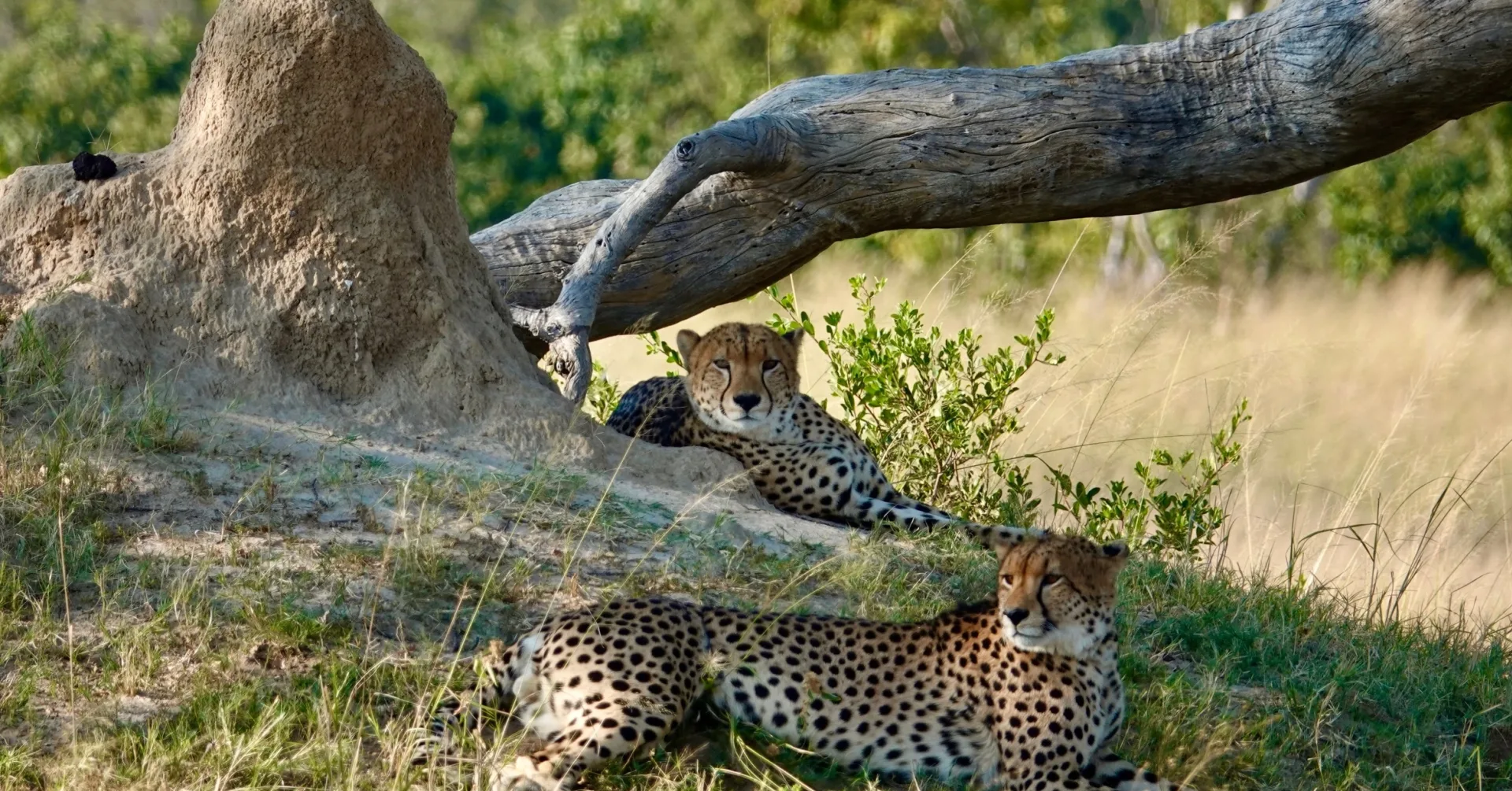
Incredible Places to Stay While on a Zimbabwe Safari
January, 31, 2024
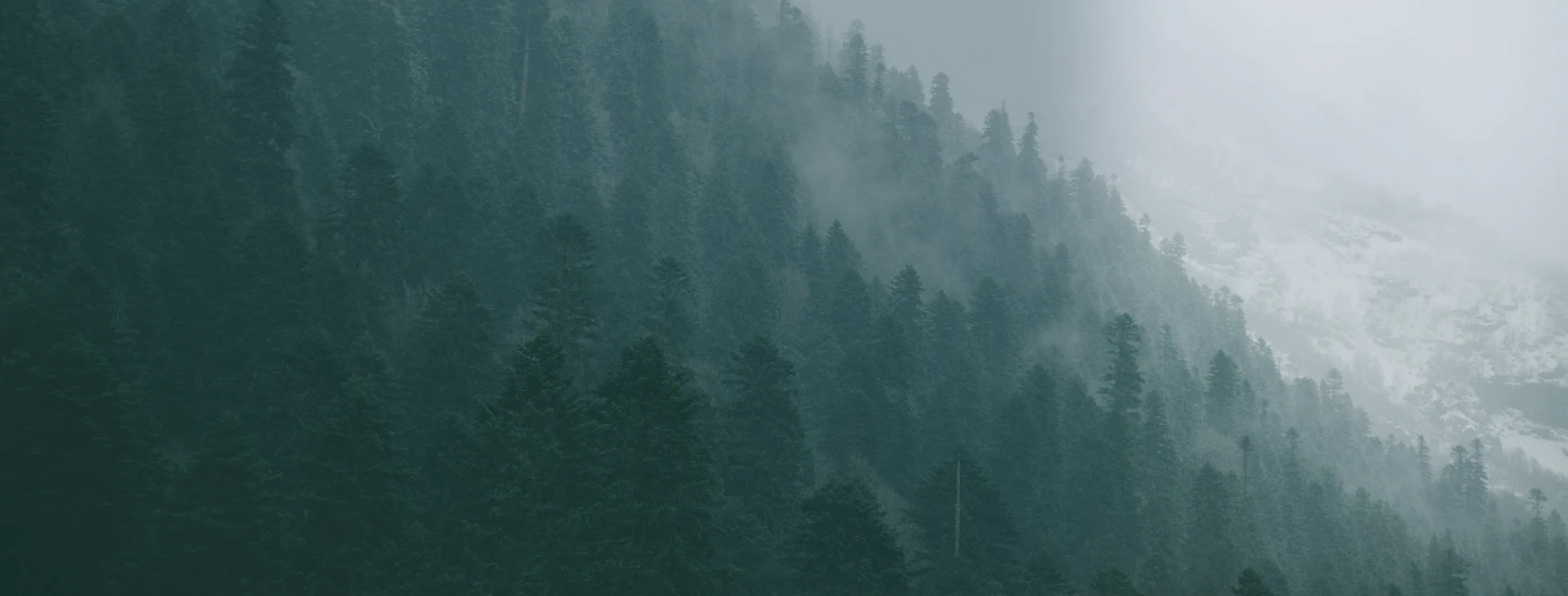
Sign up to our newsletter
For more travel inspiration delivered straight to your inbox just fill in your details here
- Search Please fill out this field.
- Newsletters
- Destinations
- Africa & Middle East
The Best Time to Go on Safari
:max_bytes(150000):strip_icc():format(webp)/anoukmarrakech-56a373305f9b58b7d0d20299.jpg)
The best time for an African safari is typically from July through October, when the animals are easy to find and in substantial numbers. Deciding when to go on safari depends on what country you would like to visit and when you can plan your trip. Seasons differ in East and Southern Africa so you can plan an excellent safari for almost every month of the year if you are flexible about where you want to go to.
Below you'll find a country-specific guide for the absolute best time to plan a safari. A month-by-month guide for the best country to visit for a safari is also included. The last part of this article is for if you're looking for animal-specific safaris, like a gorilla or a chimpanzee safari.
The best time to go on safari in Kenya and experience a vast density and diversity of wildlife is when the annual migration of millions of wildebeest, zebra, and gnu descend on the Mara plains with predators close behind. The best time to see this wildlife spectacle is from July to October. Other parks in Kenya are also excellent and the best time to visit these would be during the dry seasons —January through March and July through October.
With the scarcity of water during the dry seasons, the animals tend to gather in more concentrated numbers around permanent waterholes, rivers, and lakes, so they are easier to find. The vegetation is also less lush which means that viewing animals from a distance is easier.
If you want to see the Great Migration unfold, head to Tanzania's northern parks : the Serengeti and Ngorongoro. The best time to witness the migration is probably February through March when the wildebeest and zebra have their young. Not only can you enjoy seeing baby animals, but the predators are at the highest number too. Because the herds also concentrate in the south of the Serengeti, it's easy to plan your wildlife viewing in that area and find a safari company that offers lodging there.
June to November is Tanzania's dry season and is the best time to visit all the parks (and you can always hop over to Kenya's Masai Mara to witness the Great Migration during this time). Tanzania's Southern Parks are perfect to visit during this time since the animals tend to congregate around permanent water and it isn't so hot and humid.
All of Tanzania's parks suffer from the rains which generally fall from March to May in the North, and from November to May in the South and West. Roads get washed out and given the sheer size of Tanzania's parks, the animals tend to spread out, and this makes wildlife viewing less satisfying (if you're looking for sheer numbers of animals).
December through March can get quite hot and humid, especially in Western and Southern Tanzania which makes it a little uncomfortable to spend a lot of time in the bush.
Uganda has some magnificent National Parks which are best visited from December through March or June through September when it is predominantly dry. Most people who choose Uganda as a safari destination go to see the Mountain Gorillas . Although rain is likely all year round, the rainy seasons make the trek up to the gorillas particularly tricky, so avoid the months of March and April or October and November.
The best time to enjoy Zambia's wildlife is from September through mid-November which is the end of the dry season. Elephants abound and large herds of buffalo, impala, zebra, and others congregate in the Lower Zambezi Valley. April to September is also a good time to go, but beyond these months many parks in Zambia all but shut down due to impassable roads. In November, there's a smaller version of the Great Migration where 30,000 wildebeest gather in Zambia's Liuwa Plain National Park, that's not witnessed by many, but worth trying to plan a trip around.
July to October is the best time to go to Zimbabwe's excellent wildlife parks, especially Hwange, the largest game reserve in the country. Whitewater rafting on the Zambezi is best from August to December when the water is low, and the rapids are fast.
The Victoria Falls are at their most impressive in March and April after the rainy season. You may have difficulty seeing all of the falls due to massive amounts of spray it can be quite torrential.
June through September is the best time to go on safari in Botswana . There is little chance of rain, and the weather is still lovely and warm during the day. Huge herds congregate around the Okavango Delta during this time, making a trip in a mokoro (traditional canoe) extremely rewarding.
Botswana is one of Africa's most expensive safari destinations because many of the parks are inaccessible by road and you have to charter a small plane to get there. If you have your heart set on Botswana's excellent parks, but can't quite afford them, check out some of the shoulder season deals in April, May, and October.
Etosha National Park is Namibia's prime safari destination and the best time to visit is from May to September. This is Namibia's dry season (despite being mostly desert , there are still seasons in Namibia!) and animals congregate around the water holes making viewing easier.
Many birders come to Namibia, and the best time to visit is during the summer months from December to March, but be prepared for some scorching and humid weather.
South Africa
The prime safari areas in South Africa around Kruger National Park are best visited from June through September when the weather is cooler and dry. But South Africa's wildlife parks have better infrastructure than most parks in Africa, so rains don't necessarily mean the roads will be washed out. There are also many excellent game parks in South Africa's Eastern Cape region which experience less rain during the winter months than in the north of the country.
When to go on a safari sometimes depends on when you can take a vacation. If you're looking for the best safari experience and don't mind what country you go to, this is a useful guide for you. It's month by month account of the best animal viewing opportunities in Africa.
- January is prime safari time in Kenya, Tanzania, and Uganda. The weather is usually dry, and the animals will congregate in dense numbers around permanent water supplies. The migrating wildebeest, zebra, and gnu can be found in Tanzania's northern parks during this time of year particularly in the southern Ndutu and Salei plains.
- February is one of the best months to go on safari in Tanzania's northern parks because thousands of wildebeest are usually born around this time. Most of the wildebeest give birth within the same three week period. If you like baby animals , Kenya, Tanzania, and Uganda are all perfect this time of year. Southern Tanzania can get quite hot and humid this time of year, so stick to the northern parks if you think the weather will bother you.
- March: East Africa is still the place to be in early March if you're looking for the best safari experience in Africa. Kenya, Tanzania, and Uganda are still in their dry season, and the density and diversity of animals can't be matched elsewhere this month. If you're visiting Uganda and want to see the gorillas, you should avoid March.
- April is a good month for those looking for discounted safaris because the rains usually start in East Africa and are on their way out in Southern Africa. Rains bring plentiful water, and the animals tend to disperse making them harder to find while on safari. Vegetation begins to get very lush which can obstruct your views of the animals. And perhaps most importantly, the dirt roads in national parks can get washed out and become impassable. You can still enjoy an excellent safari in Tanzania without the crowds, especially in the northern parks. Southern Africa is coming into its own in April with cooler, drier weather. Botswana and Namibia are good bets for April. The Victoria Falls (Zambia/Zimbabwe) are at their most spectacular in April with the start of the heavy rains. They are easily combined with a visit to any Southern African safari destination.
- In May , the best country to go on safari is probably Zambia. Zambia offers a genuinely wild African safari (and the best walking safaris), and there aren't too many months when the parks can operate at full tilt, so you have to take advantage of it when you can. The rest of Southern Africa is good as well though as the dry season is well on its way. If you have your heart set on an East African safari, May isn't the best time to go, but you'll still see a lot of animals, especially in Tanzania. Make sure the camps and lodges you wish to go to are open. You should be able to get some excellent discounts.
- June: Southern Africa is heading into its best safari period by June. South Africa, Botswana, Zambia, Zimbabwe, and Namibia enjoy their high season this time of year. Be prepared for some chilly nights and bring a jacket for the early morning drives.
- July - September: Take your pick of destination from July to September. Every major safari destination is primed for business. Kenya's Masai Mara lays out the green carpet for millions of migrating wildebeest. This is the time for those spectacular river crossings with the crocodiles lying in wait for feeble wildebeest to stumble into their watering jaws. Southern African parks are dry and packed with diversity which you can enjoy from your lodge bar overlooking a waterhole. Since this is also when the northern hemisphere takes their summer vacation, parks can get crowded and booked up well in advance. If you're looking for a budget safari, try a different season.
- October: Zimbabwe, Kenya, and Tanzania are the best places for a safari in October. The small rainy season has usually not arrived yet and the months of dry weather makes game viewing very rewarding.
- November: While Southern Africa begins its rainy season with significant heat and humidity, Zambia is still a good destination for a safari because of a unique wildlife event that takes place in Liuwa Plain National Park. A smaller version of the great East African migration takes place, and for safari aficionados, this can be very exciting to witness. Unfortunately, the rest of Zambia's parks during this time aren't at their peak, but game viewing is still fair. Northern Tanzania is the best place to go on safari in November, as the migrating herds make their way back to the Serengeti plains. If you're a birder, Botswana's Okavango Delta begins to fill up with migrating birds this month, starting their breeding season (which lasts until March).
- December: East Africa reigns once again as the best safari destination if you'd like to spend Christmas in the bush. Kenya, Tanzania, and Uganda enjoy some dry weather and excellent game viewing.
Best Times to See Specific Animals
- Gorillas are actually a year-round attraction since their habitat has been reduced so significantly, they couldn't roam far even if they wanted to. However, tracking gorillas is hard at the best of times, and during the rainy season, the steep paths and mud can make it almost impossible to manage. Very heavy rain also makes it more difficult to take good photos, and since you only have an hour with the gorillas, it would be a shame not to get a good snapshot or two. The main rainy seasons in Rwanda, Uganda, and the DRC are from March to April and October to November.
- Chimpanzee safaris can be found in Western Tanzania and Uganda. Like gorilla safaris, they can take place year-round but the rainy season makes walking in the forests a little tougher, and the photo opportunities aren't as good as in the dry season (July through October and December). However, the rain also means the chimpanzees don't have to roam too far to find water, and they are easier to locate (February-June, November-mid December).
- Whales: South Africa offers some of the world's best whale watching especially if you don't fancy going out on a boat, but would like to see them from the shore. The best time to view whales is from June to November when the Cape coast comes alive with hundreds of southern-right whales. You can also see humpbacks, Bryde's whales, and orcas.
- Birds: The best time to see birds in Southern Africa is between November and March. South Africa, Namibia, Botswana, Angola, Zimbabwe, Zambia, and Malawi are all excellent destinations for birders, and many birding safaris are available. In East Africa, the best time to go birding is January through March. Kenya, Tanzania, Uganda, and Ethiopia are all popular birding destinations. West Africa also offers a huge and exciting variety of birds, the best time to visit Cameroon, the Gambia, and other destinations are during the European winter from November to March.
Related Articles
More related articles.

- Adventure Travel / Africa / Ask RAI / Travel
Best Safari in Africa → Top Countries + Places for First-Timers
Published August 1, 2024 · Updated August 1, 2024
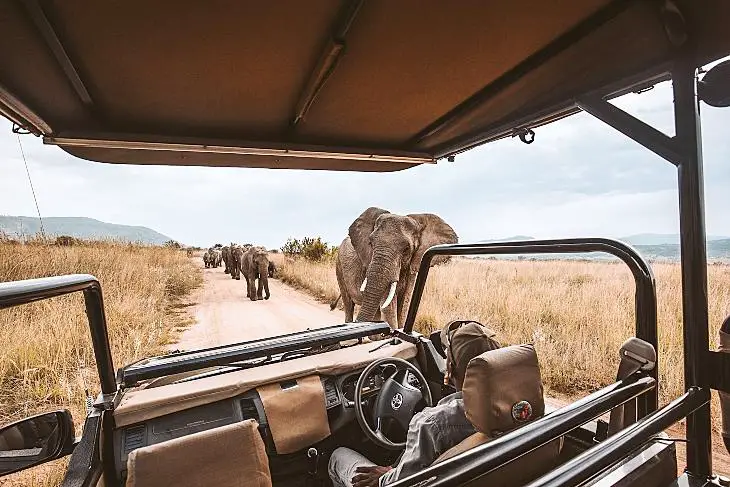
Looking for the best African country for safari in 2024? You’re in the right place!
Witnessing lions stalking their prey or leopards lounging on tree branches against the backdrop of endless savannah is an unforgettable sight. Africa offers the ultimate adventure, with its fascinating and diverse landscapes, abundant wildlife, and unmatched safari experiences. From the vast plains of the Serengeti in Tanzania to the majestic Okavango in Botswana, the best safari in Africa offers an unlimited number of options for an extraordinary wildlife expedition. Whether you’re a seasoned traveler or embarking on your first African safari, join us as we explore the best places to safari in Africa and unique experiences that this beautiful continent has to offer. Get ready to be immersed in nature’s wonders as I guide you through the best countries for safaris in Africa.
You may be wondering, where should I go on my first safari in Africa?
When you think of the best safaris, the first continent that comes to mind is Africa. With its vast national parks, incredible wildebeest migration and high densities of predators, it’s not hard to see why Africa is the most popular safari destination in the world.
There are many countries in Africa which are popular for safaris, each with their own unique national parks, animal species, and cultures. Below I’m going to run through the best places for safari in Africa, so you can decide which is the best country for your first (or next) safari in 2024.
How long should I spend on an African safari?
My personal recommendation, from countless number of safaris of my own, is that you should plan to spend at least 10 – 14 days for an in-depth safari African experience. This will give you sufficient time to see plenty of wildlife and visit three or four different camps and lodges in different areas to get a good feel for the region. The best month to go on a safari in Africa is during the dry, winter season of June to October. During this period, it is easier to spot the wildlife as the vegetation is more sparse and the animals tend to gather at water sources due to the scarcity or rain and water.
>> Read next:
- Ranked: the wealthiest countries in Africa
- Your guide to the best countries in Africa in 2024
- List: safest destinations in Africa
- Top quotes about Africa on the beauty of this land
- Where to find the best African sunset and islands
- What is the biggest country in Africa ?
- The best African songs to get you ispired
Which Country Offers the Best Safari in Africa
Which African country is best for safari?
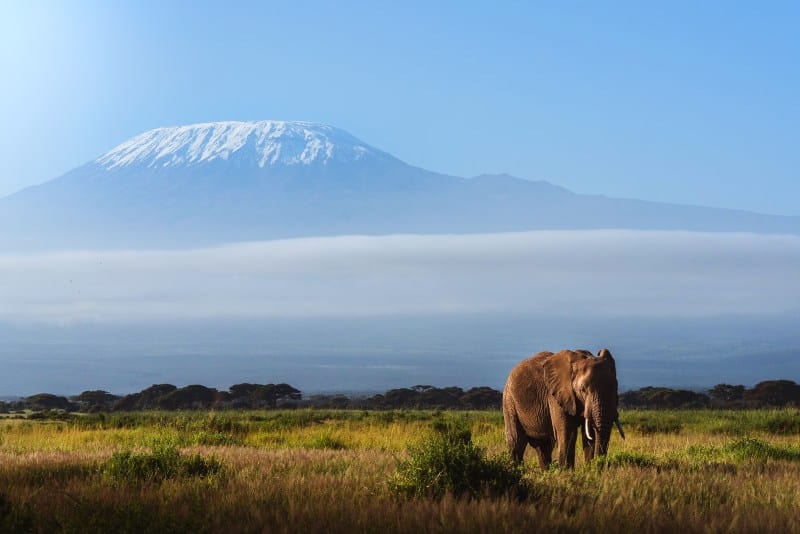
Which country offers the best safari in Africa?
1 | TANZANIA
Tanzania is arguably the best safari destination in Africa. Boasting the absolutely huge Serengeti National park in the north, all of the big five (elephants, rhinos, lions, leopards, and buffalo) and an incredibly diverse culture including the famous Maasai tribe, Tanzania has a lot to offer.
Tanzania is also renowned as having the safari with the most animals and the continent’s largest populations of safari species, with an estimated 4 million wild animals. One of the highlights of a safari in Tanzania is seeing the legendary great migration, whereby over 2 million wildebeest, zebra, and gazelle move across the Serengeti ecosystem.
There are two main options when it comes to planning your Tanzania safari itinerary — the northern circuit or the southern circuit. The northern circuit is the most popular and more cost effective option and also includes the most popular parks such as Taragire, Serengeti, and the Ngorongoro Crater.
The southern circuit is more expensive and less visited due to the longer distances involved. However, it does include some great parks such as Selous Game Reserve, Ruaha, and Udzungwa Mountains.
The cost of a Tanzania safari is one of the highest in Africa due to the high park fees. It’s also more geared towards using a safari company vs self drive which can also increase costs somewhat. Tanzania safaris typically start at $250 pp per day for budget and from $450 pp per day for mid-range, excluding external flights .
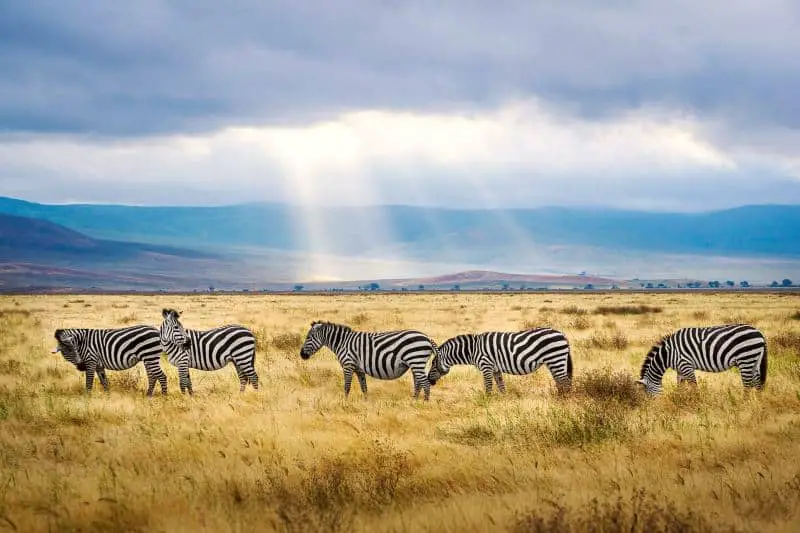
Most Popular Tanzania Safari Circuits
Northern Circuit includes Serengeti National Park, Ngorongoro Crater, Tarangire National Park, Arusha National Park
Southern Circuit includes Selous Game Reserve, Ruaha National Park, Mikumi National Park and Udzungwa Mountains National Park
Western Circuit includes Katavi National Park, Mahale Mountains National Park, Gombe Stream National Park and Rubondo Island National Park
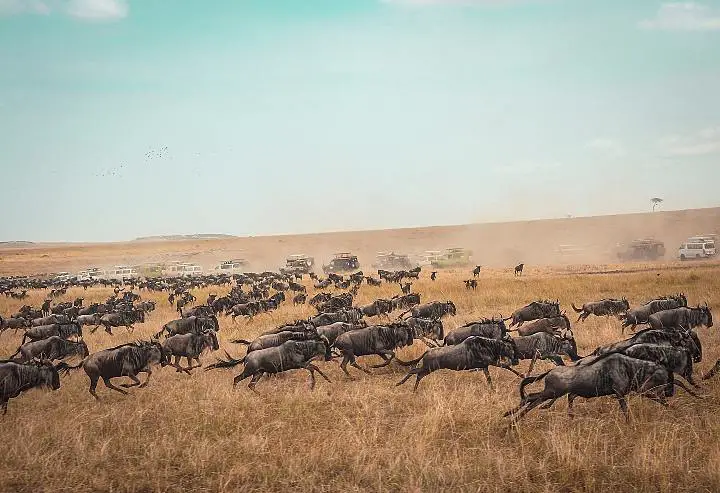
Key Parks in Tanzania
The Serengeti which means “endless plains” is absolutely huge at approximately 14,763 square kilometres (5,700 square miles). One of Africa’s most famous and iconic national parks and the best place in Africa for safari, it’s renowned for its vast savannah plains, wildebeest migration, and high density of predators.
Game in the serengeti includes lions, leopards, African elephants, Cape buffalos, cheetahs, giraffes, wildebeest, and zebras.
Tarangire National Park covers an area of about 2,850 square kilometres (1,100 square miles) and is famous for its large herds of African elephants. The park is also known for its diverse landscapes, including grassy plains, baobab trees, and the Tarangire River which spans the park and gives it its name.
As well as elephants, the park is home to many other game including lions, leopards, cheetahs, giraffes, zebras, buffalo, and numerous bird species.
Ngorongoro Crater is part of the Ngorongoro Conservation Area, a UNESCO World Heritage Site and a world famous African landmark . The conservation area covers an area of about 8,292 square kilometres (3,202 square miles), with the crater itself being around 260 square kilometres (100 square miles). It was recently separated from the Serengeti National park to allow for the Massai to live there as the Serengeti National park does not allow tribes to live inside it.
The Ngorongoro Crater has a wide range of wildlife, including all of the big five animals. This massive volcanic caldera is home to game including lions, elephants, black rhinos, leopards, Cape buffalos, as well as various other animals such as zebras, wildebeests, hyenas, hippos, and a rich birdlife. Some of the animals move into and out of the crater, while others stay here all year round.
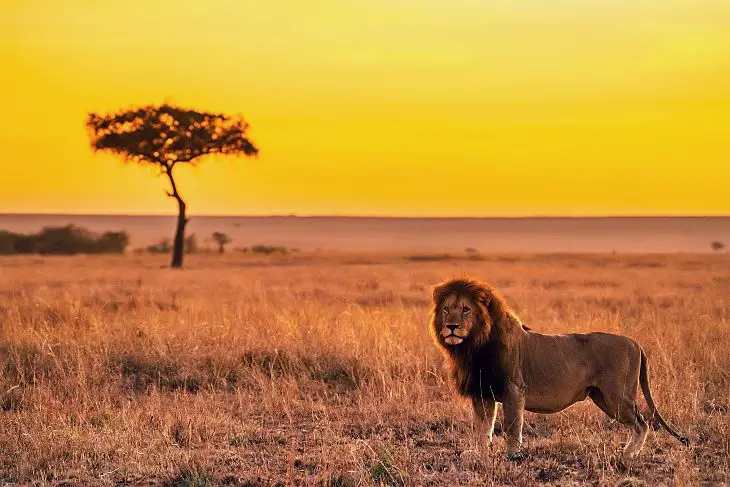
2 | SOUTH AFRICA
South Africa needs no introduction when it comes to the world of the best safaris in Africa in 2024. It is a must-visit destination for wildlife and nature enthusiasts alike with its diverse wildlife, diverse landscapes, and plethora of accommodation options.
Which country is best for first safari in Africa?
A South African safari offers an unparalleled opportunities for encountering wild animals and flora up close amidst stunning natural settings. This country boasts an incredible variety of wildlife species that can be observed during your African safari. From the iconic Big Five (elephant, lion, rhino, buffalo, and leopard) to hippos, giraffes, zebras, cheetahs, and countless bird species – there is just such a large bounty and variety of safari animals to encounter while exploring the game reserves.
Safaris in South Africa tend to either centre around national parks such as the world-renowned Kruger National Park in the northeastern part of South Africa and private game reserves. You can expect to find an abundance of safari experiences with plentiful lodges, expert guides, and many intimate encounters with the wildlife.
Although South Africa caters to some very luxurious safaris in their private reserves, they also offer reasonably priced budget safaris starting at $200 pp per day, excluding international flights.
South Africa also provides world-class horse riding safaris in their game reserves. The wildlife grow used to the horses, who often live in the bush with the other animals when they are not being ridden, which allows riders to get close to the game without startling it.
For ethical tourism, avoid private game reserves that have hands-on animal experiences as these pose a number of ethical issues.
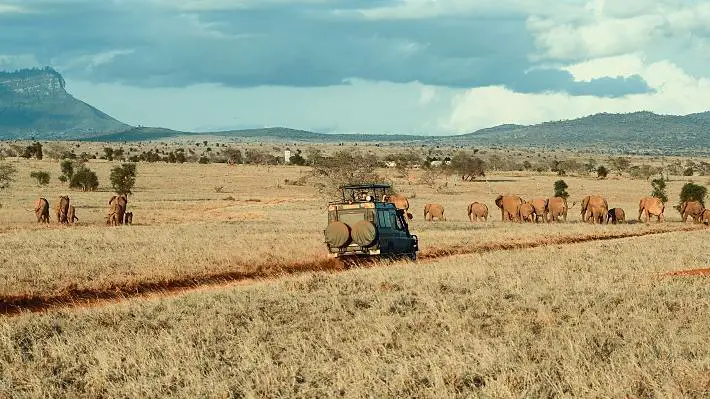
Most Popular Safari Routes In South Africa
The Kruger National Park Route focuses on exploring the Kruger National Park. You can enter the park through one of the multiple entrance gates and drive along the network of roads to explore different regions within the park.
The Panorama Route takes you through the Mpumalanga province, near Kruger National Park. This route includes attractions such as Blyde River Canyon, Bourke’s Luck Potholes and God’s Window. This can be combined with the The Kruger National Park Route above.
The Madikwe-Mapungubwe Route explores the Madikwe Game Reserve and Mapungubwe National Park in the North West province, a UNESCO World Heritage Site. This is a good route for those seeking a malaria-free safari.
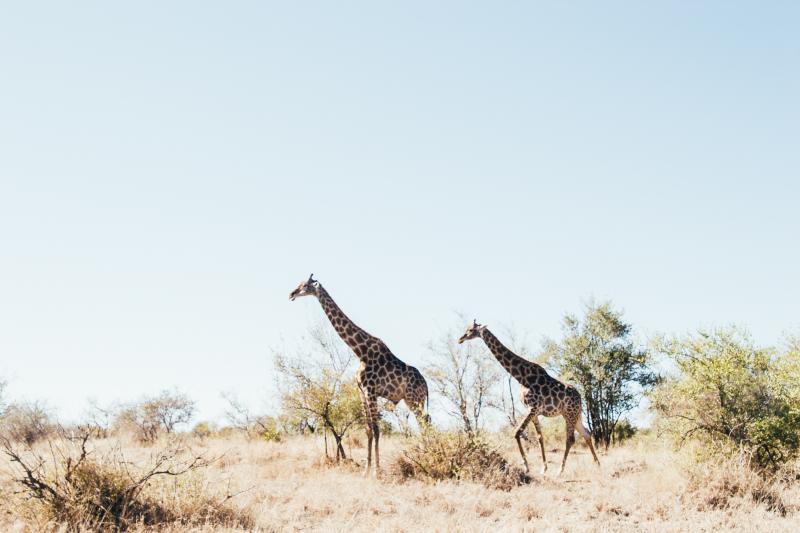
Key Parks in South Africa
No list of the best African safari countries is complete without South Africa . Here are the most famous parks in the country.
The Kruger National Park covers an area of approximately 19,485 square kilometres (7,523 square miles), making it one of the largest national parks in Africa and slightly bigger than the Serengeti in Tanzania.
Located in the northeastern part of South Africa this vast wilderness sanctuary that is one of the best places to go on safari in Africa is accessible for both self-drive safaris and guided game drives.
Game includes the Big Five as well as cheetahs, wild dogs, giraffes, zebras, hippos, crocodiles, and antelopes.
Sabi Sands Game Reserve covers an area of approximately 65,000 hectares (160,618 acres) and shares an unfenced border with Kruger National Park.
It is a private game reserve known for its frequent leopard sightings and luxury accommodation.
As well as leopards, animals include lions, elephants, buffalos, rhinoceros, cheetahs, wild dogs, giraffes, zebras, hippos, crocodiles and a wide array of bird species.
Madikwe Game Reserve covers an area of approximately 75,000 hectares (185,329 acres) in the North West province of South Africa.
One of South Africa’s largest malaria-free reserves, the park is also known for its successful conservation efforts with species such as African wild dogs, as well as black and white rhinos.
In addition to the Big Five, Madikwe is known for its populations of cheetahs, giraffes, zebras, wildebeests, hyenas, warthogs, antelopes and over 300 species of birds.
Hluhluwe-iMfolozi Game Reserve spans approximately 96,000 hectares (237,221 acres) in the KwaZulu-Natal province of South Africa.
The park is one of the oldest game reserves in South Africa with a high concentration of wildlife. Hluhluwe-iMfolozi played a crucial role in the conservation of the white rhino species.
The park is famous for its populations of both white and black rhinos.
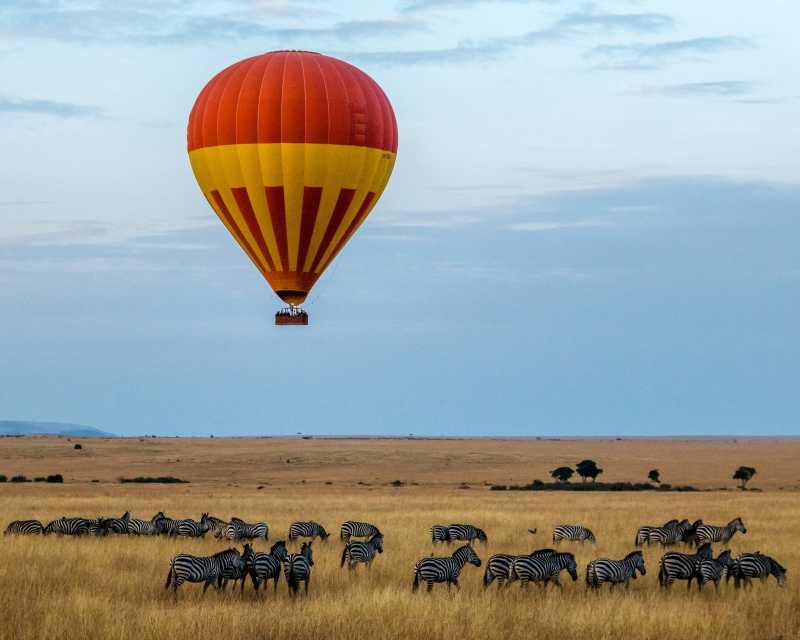
Still wondering where to safari in Africa? Next up we have…
Kenya is another country which is synonymous with the best African safaris. And for good reason — the Kenyan Maasai Mara, which joins the Serengeti at the Mara river, is world-class. More than 8 percent of the land in the country is protected and it offers an amazing safari experiences all year long due to its plethora of wildlife, pleasant weather, and vast open areas.
There are 23 national parks and game reserves in Kenya, each offering a memorable safari experience. One of the highlights in one of the best places for an African safari in Kenya is seeing the great migration, where millions of wildebeest and other herbivores cross treacherous rivers in search of greener pastures.
The Maasai Mara provides front-row seats to one of nature’s greatest spectacles, which incorporates the Mara river crossing in the south of the reserve. In addition to offering iconic safaris in a region teeming with wildlife, you also have the opportunity to enjoy cultural encounters in Kenya with the local Masai tribespeople. The best time to go to Kenya for an African safari is during the dry season of of January to February and July to October. Plan to spend at least 10 to 14 days exploring the best that this region has to offer.
The Most Popular Safari Routes In Kenya
The Maasai Mara Route which centres around the Maasai Mara National park and also includes Lake Nakuru National Park and Amboseli National Park.
The Amboseli-Tsavo Route which focuses on the Amboseli National Park, then onwards to Tsavo West and Tsavo East National Parks.
The Samburu-Isiolo-Meru Route which explores the northern parts of Kenya, including Samburu National Reserve proceeding off the beaten path to Isiolo and Meru National Parks
The Aberdare-Mount Kenya Route takes you through Aberdare National Park and includes Mount Kenya National Park.
Kenya offers slightly lower rates for budget safaris compared with other African countries with budget safaris starting at $150 pp per day excluding outbound flights.
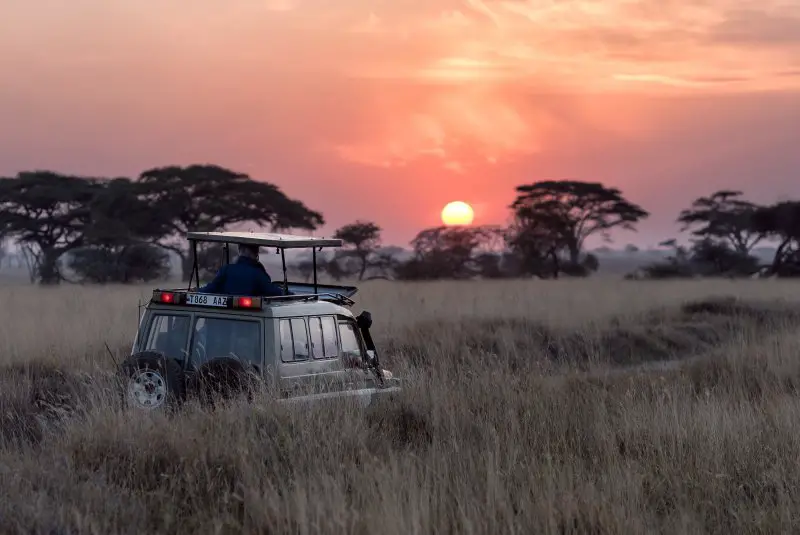
Key parks in Kenya
Maasai Mara National Reserve covers an area of approximately 1,510 square kilometres (580 square miles). One of the most renowned safari destinations in Africa, it borders the Tanzanian Serengeti National Park in the south where it meets the Mara River. Located in the south, it’s famous for the great migration, where millions of wildebeest and zebras move in search of fresh grazing.
The Maasai Mara is home to a wild variety of game including the Big Five and also cheetahs, hyenas, giraffes, zebras, hippos, crocodiles, and a rich diversity of bird species.
Amboseli National Park spans approximately 392 square kilometres (151 square miles).
Located in southern Kenya, Amboseli National Park is famous for its views of Mount Kilimanjaro , Africa’s highest peak. The park is also known for its large herds of African elephants roaming freely across vast plains. The swamps within Amboseli are teeming with a diverse range of birdlife.
Game in Amboseli include elephants, lions, cheetahs, leopards, giraffes, zebras, wildebeests, buffalos, hyenas, and a variety of bird species.
Tsavo National Park is another great option to go on a safari in Africa. Tsavo East and Tsavo West National Parks form one massive ecosystem divided by a railway line.
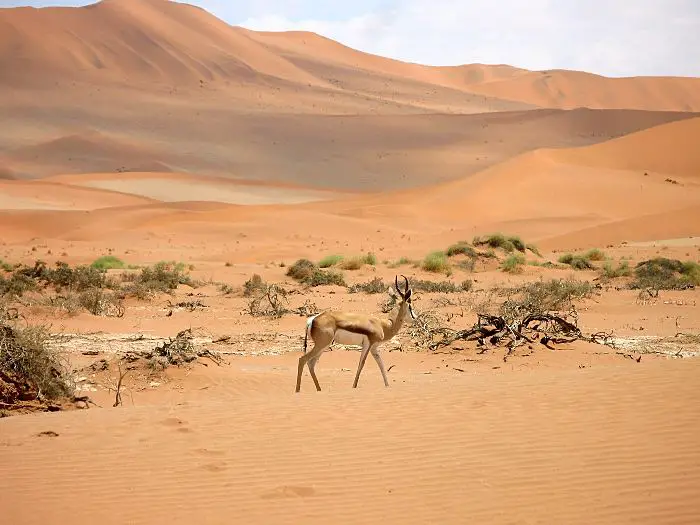
4 | NAMIBIA
One of Africa’s top safari destinations in 2024, game viewing in Namibia is unique due to the country’s stunning dune and desert scenery such as the Namib Desert, which is one of the oldest deserts in the world. Expect to find an abundance of desert-adapted wildlife and mesmerising landscapes.
Namibia’s biggest national park, Etosha is renowned for its salt pan and numerous waterholes, which attracts a wide variety of wildlife during the dry season.
As well as Etosha national park, Namibia has a number of private game reserves and conservation areas.
Self drive safaris are popular in Namibia, however, due to the vast distances between destinations it’s recommended to study a Namibia travel guide beforehand to help you construct your itinerary to make the most of your trip.
As self drives are popular and accommodation is reasonably priced or you can sleep in a roof top tent, costs can be quite reasonable compared to other safari destinations in Africa. Prices for a budget trip will start from around $100 pp per day.
The best time to visit Namibia for wildlife viewing is between the months of July to October. This is when you will find pleasant temperatures and a low chance of rain.
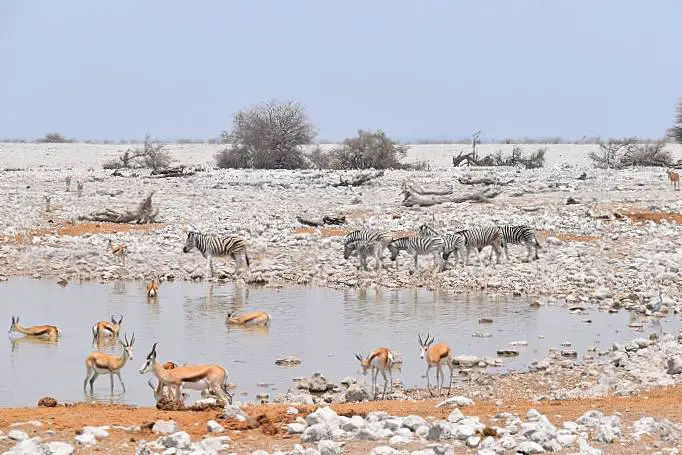
Most Popular Namibia Safari Circuits
Etosha National Park Route focuses on exploring Etosha National Park, The route typically starts from Windhoek, the capital city , and includes stops at various rest camps and water holes within the park.
Namib-Naukluft National Park and Sossusvlei Route takes you to the Namib Desert and the Sossusvlei sand dunes. The journey often starts from the city of Windhoek and heads south to Sesriem, the gateway to Namib-Naukluft National Park.
Damaraland and Kaokoland Route explores the rugged and remote regions of Damaraland and Kaokoland in northwestern Namibia.
Skeleton Coast and Namib Desert Route explores the wild and remote Skeleton Coast, The route often starts from Swakopmund or Walvis Bay and takes you along the coast. The route can also include a visit to the Cape Cross Seal Reserve and the Namib Desert.
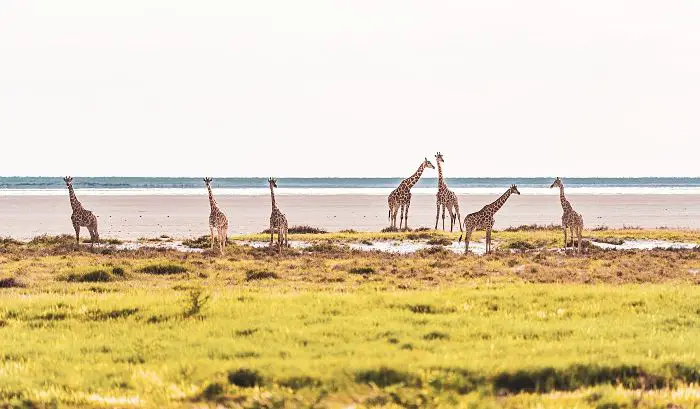
Key Parks in Namibia
Etosha National Park covers an area of approximately 22,270 square kilometres (8,600 square miles), making it one of Africa’s largest national parks and slightly bigger than the Kruger National Park in South Africa.
The park is dominated by the vast Etosha salt pan, which attracts a wide array of wildlife, especially during the dry season.
Wildlife in Etosha include the Big Five (elephant, lion, leopard, rhinoceros, and buffalo). Other key animals include giraffes, zebras, wildebeests, springboks, oryx, kudus, cheetahs, hyenas, and a variety of bird species.
Namib-Naukluft National Park is one of the largest conservation areas in Namibia, covering an area of approximately 49,768 square kilometres (19,216 square miles)
The park encompasses the Namib Desert, one of the oldest deserts on Earth, known for its towering sand dunes.
Wildlife includes oryx, springboks, ostriches, jackals, hyenas, various reptiles and endemic bird species.
Skeleton Coast National Park stretches along Namibia’s northwestern coastline for approximately 500 kilometres (310 miles).
It is named after the numerous shipwrecks that dot the coastline and often requires experienced guides to visit due to its remote location and challenging conditions.
Wildlife includes seal colonies, which attract predators such as jackals and brown hyenas. You can also see elephants, giraffes, oryx, springboks, and a variety of bird species, including flamingos and pelicans.
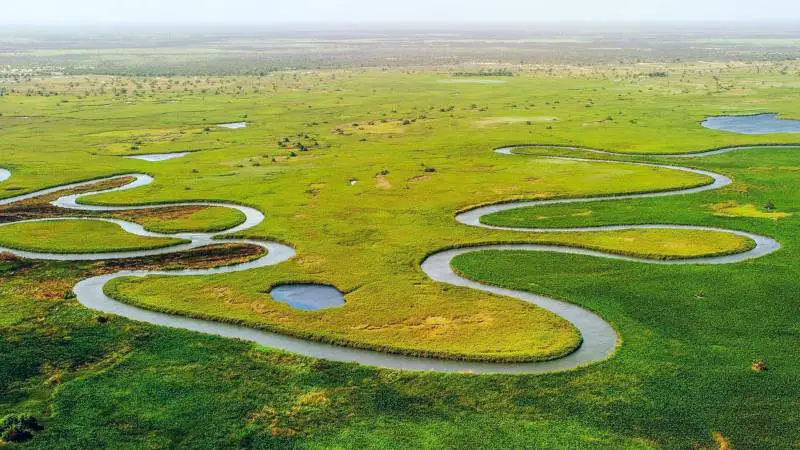
5 | BOTSWANA
The landlocked country of Botswana in Southern Africa is next up on this list of best safari Africa. Its landscape is defined by the Kalahari Desert and the Okavango Delta and it is this fascinating range of habitats that make going on a safari in Botswana truly special. Its main safari reserves, such as the Okavango and Chobe, are less accessible and wilder than the majority of those mentioned in the other countries above. The Okavango becomes a lush animal eden during the seasonal floods while the Central Kalahari Reserve is home to a plenitude of animals. In addition, Botswana is often ranked as one of safest places to safari in Africa .
Botswana emphasises high-cost, low-impact fly-in tourism. With high-end lodges and prohibitive costs, you will have a more peaceful safari experience compared to some of the busier safari destinations in Africa, the likes of Kenya.
Botswana is a country that is committed to conservation, and its protected areas are well-managed, allowing for exceptional game viewing opportunities in a remote and unspoiled environment.
Botswana is arguably the most expensive safari destination in Africa. In addition to the highest conservation fees in Africa, safari costs are quite high. A safari here starts at around $250 pp per day for budget and from $450 pp per day for mid-range, excluding external flights.
Most Popular Botswana Safari Circuits
Okavango Delta Circuit includes Moremi Game Reserve, Khwai Concession and Private concessions within the Okavango Delta.
Chobe Circuit includes Chobe National Park, Kasane region, Linyanti Reserve, and Savuti.
Central Kalahari Circuit includes Central Kalahari Game Reserve and Makgadikgadi Pans.
Nxai Pan and Makgadikgadi Circuit includes Nxai Pan National Park and Makgadikgadi Pans.
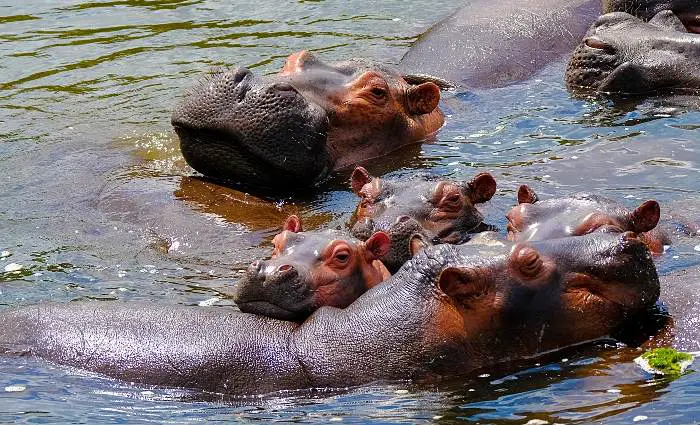
Key Botswana Parks
The Okavango Delta covers an area of approximately 22,000 square kilometres (8,500 square miles).
The Okavango Delta, a UNESCO World Heritage Site, is the largest inland delta in the world. Formed by the overflow of the Okavango River, this extraordinary ecosystem encompasses a network of channels, lagoons, and islands .
Game includes Elephants, lions, leopards, buffalos, hippos, crocodiles, giraffes, zebras, antelopes, and many species of birds.
Chobe National Park covers an area of approximately 10,566 square kilometres (4,083 square miles).
This woodland park is known for having the large population of wild elephants than anywhere else in the world, especially during the dry season when they gather around the Chobe River.
Game includes elephants, lions, leopards, buffalos, giraffes, zebras, hippos, crocodiles, antelopes, and lots of birdlife.
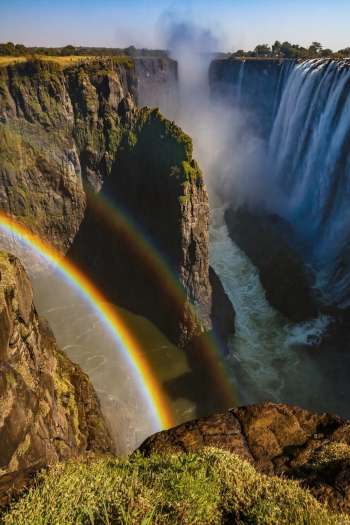
Home to one of the natural wonders of the world, Victoria Falls, Zambia contains a number of sprawling national parks which are teeming with wildlife. It offers real safari encounters in wild, remote destinations and is a strong contender as one of the best countries for safaris in Africa.
As well as traditional 4×4 safaris, Zambia is well known for its excellent walking safaris which allow you to immerse yourself in the nature of their unspoiled landscapes for a more intimate safari experience in Africa.
Water-based safaris such as boat safaris, canoe safaris , or river cruises along the Zambezi River or other waterways are also popular in Zambia. Water-based safaris allow you to view hippos, crocodiles, and a variety of bird species from a unique angle.
Most Popular Zambian Safari Circuits
Northern Circuit includes South Luangwa National Park, North Luangwa National Park, Kasanka National Park, Bangweulu Wetlands, Lavushi Manda National Park.
Luangwa Valley Circuit includes South Luangwa National Park, North Luangwa National Park, Luambe National Park, Lukusuzi National Park and Luangwa River.
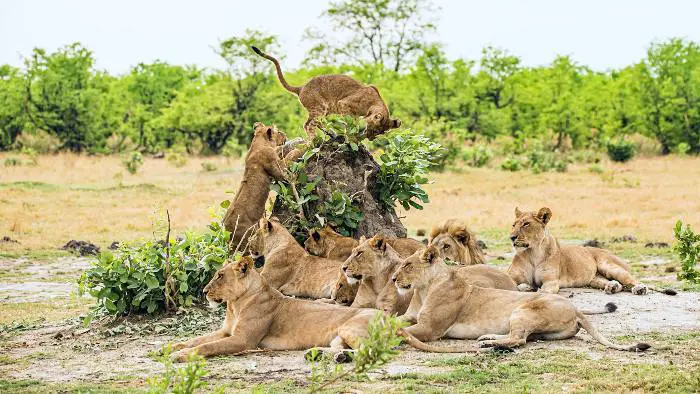
Key Zambia Parks
South Luangwa National Park covers approximately 9,050 square kilometres (3,500 square miles).
The park is known for its untouched wilderness, walking safaris and high concentration of leopards.
Game includes leopards, elephants, lions, giraffes, buffalos, hippos, wild dogs, zebras, antelopes and over 400 bird species.
Lower Zambezi National Park spans an area of approximately 4,092 square kilometres (1,580 square miles)
Situated along the banks of the Zambezi River, the park includes floodplains, riverine forests, and impressive escarpments.
Game includes elephants, lions, leopards, buffalos, hippos, crocodiles, zebras, giraffes, antelopes and many different birds.
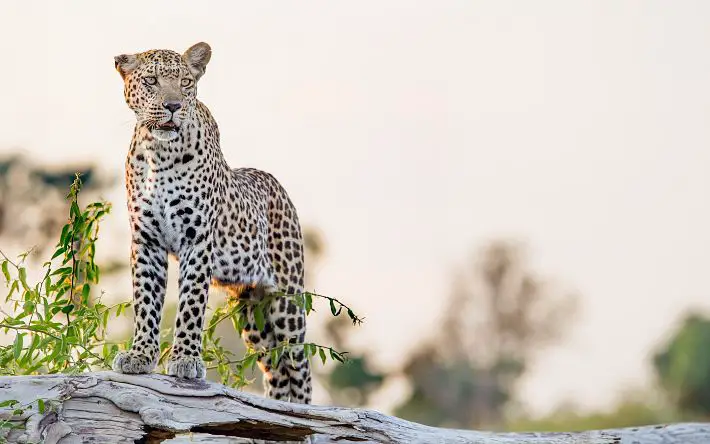
Africa is the perfect continent for a safari , home to some of the world’s best national parks which are absolutely teeming with life. You really can’t go wrong with any of these top African safari destinations, each one offering something unique to travellers.
And now you know where to find the best safari in Africa .
What is YOUR favourite safari destination in Africa? Let me know! Rai
You may also like...
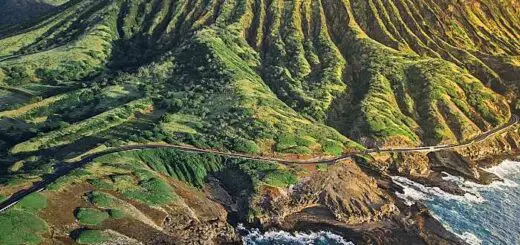
The Ultimate Oahu Itinerary (2023): 7-10 Days In Oahu Hawaii
September 7, 2023
by Raihaan · Published September 7, 2023

ᐅ Top 100 Mexican Songs About Mexico To Add to Your Playlist ♫
June 12, 2024
by Raihaan · Published June 12, 2024
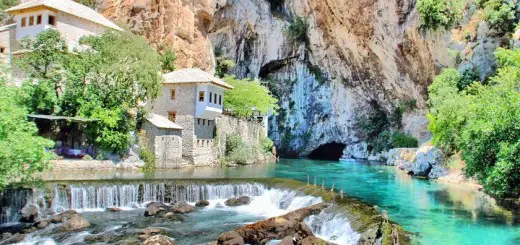
Travel Guide to Blagaj Buna: Bosnia and Herzegovina
January 14, 2021
by Raihaan · Published January 14, 2021 · Last modified September 1, 2021
Leave a Reply Cancel reply
Your email address will not be published. Required fields are marked *
- Next story Nomad eSIM Review: Everything You Need to Know as a Traveler
- Previous story Greece Island Hopping: Your Complete Travel Guide
WHO IS ARAIOFLIGHT ✈
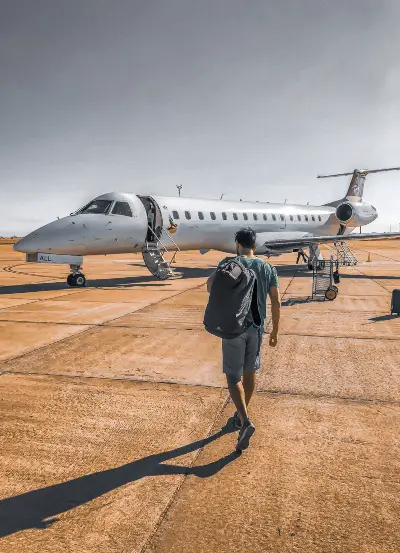
Welcome to A Rai of Light!
A home for extraordinary people around the world. If you've ever felt like there must be more to life, this site is for you.
Out of a love for travel, writing, photography, sharing stories and a desire to inspire others , I created this space to connect with other like-minded individuals.
Along the way, I share my journey and strategies on Travel , Art and Life . Enjoy!
DISCOVER MORE: POPULAR ✈
- Recent Posts
- Popular Posts

15 Romantic Getaways in the Midwest USA

15 Amazing Bucket List Experiences in Italy [Best Things To Do]

The Top Things To Do in Malta and Gozo [25 Most Instagrammable Spots]

Nomad eSIM Review: Everything You Need to Know as a Traveler

Greece Island Hopping: Your Complete Travel Guide

35 Essential Dominican Republic Travel Tips in 2024 [+ Top Destinations]

Ranked: 15 Most Beautiful Flags in the World in 2024
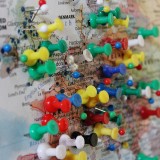
List: Which Countries Can You Visit on a Schengen Visa in 2024

WEIRD Food around the world | 35 World Travelers reveal the strangest food they’ve ever eaten

First Trip to Egypt? My Ultimate Guide of Insider Tips To Know BEFORE You Go
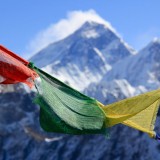
Epic List: The Best Short Treks in Nepal!

Flying Tips: 13 Things NOT To Do on an Airplane

Aruba Flamingo Beach: Worth $130? + How To Visit in 2024
FOLLOW THE ADVENTURE ✈
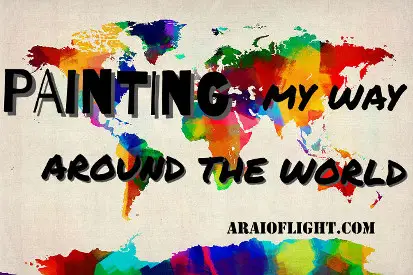

When’s the best time to go on safari in Africa?
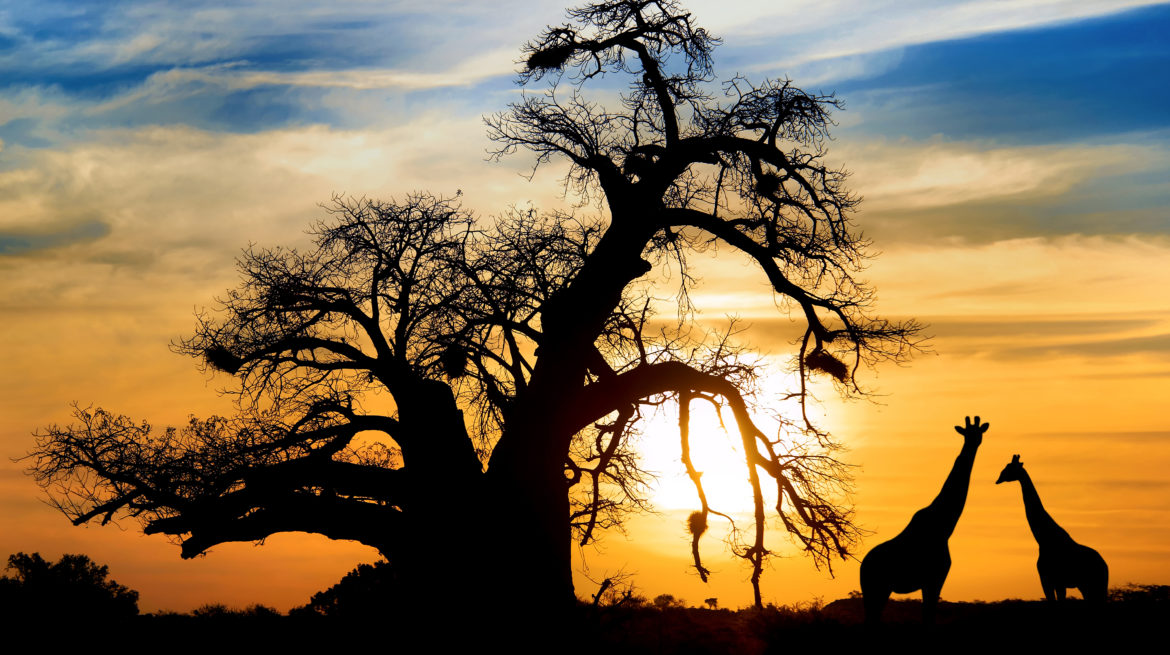
An African safari is the ultimate bucket list trip, so you want to make sure you go at the right time.
The journey will take you across vast, ever-changing landscapes and give you an up-close look at some of the world’s most beautiful animals in their natural environment. You’ll probably want to pack your bags as soon as you start imagining the awesome journey, but a little planning ahead of time can make your trip that little bit more magical.
When is the best time for a safari in Africa?
The best time to go on safari is between June and October, during the dry season. This is a cooler time of the year and you are more likely to see animals, who are searching for water sources. During these months, you can also catch the iconic Masai Mara migration.
Here is a breakdown of some of the best countries to visit, when to go, and the perfect trips for you.
Safaris from January to February
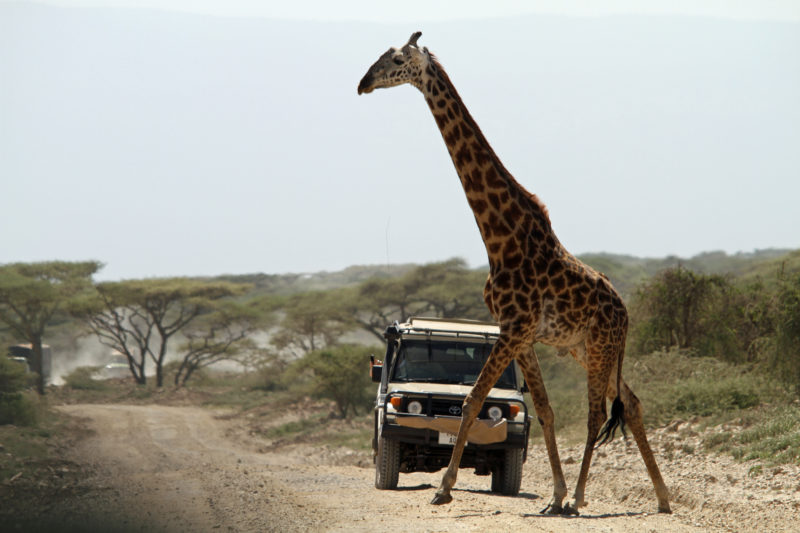
Giraffe crossing in Serengeti National Park
The Great Migration of wildebeests from Tanzania’s Serengeti to Kenya’s Masai Mara is awe-inspiring, to say the least. The precise timing of it is dependent upon rainfall patterns each year, meaning you can see different aspects of it at different times: the mass birthing of calves between January and March in the southern Serengeti, and river crossings between July and August.
In addition to wildebeests, safari-goers will also have the chance to spot Africa’s most famous predator, lions. Prides of lions will follow the herds for the prime hunting opportunity they present. Cheetahs, wild dogs and hyenas also make appearances as they try to take down vulnerable members of the herd. If you’re lucky, you might even see a wildebeest or zebra giving birth.
Read more: 7 reasons why your next adventure should be in Tanzania
Tip from Intrepid’s Africa Product Manager, Jenny:
Have an open mind! A lot of travelers have this unrealistic expectation of seeing river crossings with thousands and thousands of wildebeest (and the odd crocodile) battling it out in the ultimate scene from National Geographic! The migration is a natural phenomenon and no year is the same as the last. That being said, it is magical!
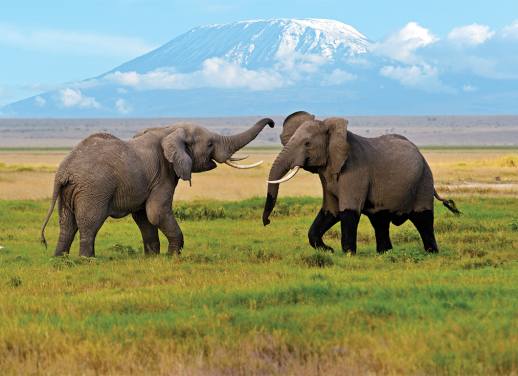
Safaris from March to April
South africa.
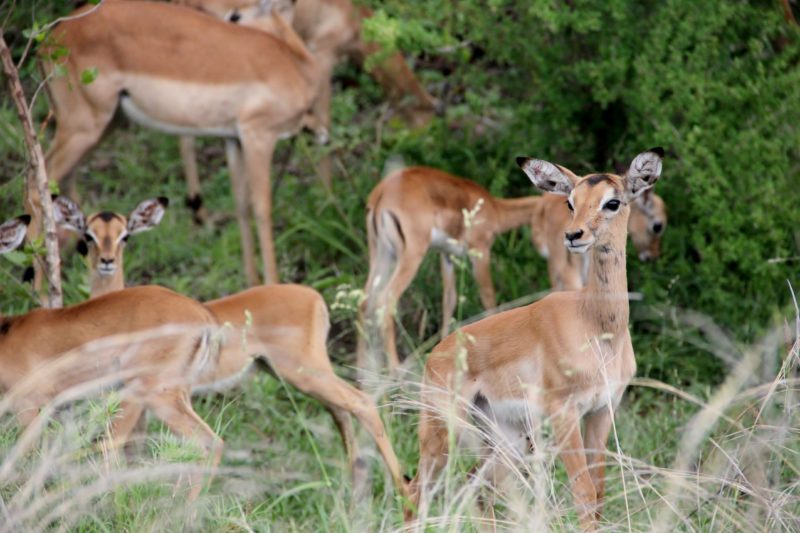
Herd of impalas in Kruger National Park
South Africa is pretty much your one stop shop for everything a good African holiday is made of. It’s also incredibly good value. Consider heading there in March and April for pleasant weather and fewer crowds. These two summer months fall in the country’s wet season, but the rains really do open the door to some of the best wildlife-spotting opportunities.
Kruger National Park, the region’s most famous National Park, not only has the big five (and more!), but is also close to the vibrant, underrated city of Johannesburg.
Read more: 6 reasons why South Africa is a destination with something for everyone
But any time is a good time to visit South Africa. Cape Town offers food, wine, shopping, dreamy views, and activities for all ages. Just outside it lies the popular wine region, located on the Western Cape. You simply can’t go wrong!
If you don’t want to sit in a vehicle all day, our exciting new active itinerary is a great shout. It’s a 9-day cycling and hiking trip through South Africa, and lets you hike Table Mountain, bike through Stellenbosh winery region, and so much more.
The weather is fairly temperate throughout the entire year here so visiting in any season is an option, but it’s a little rainier from June to September. A few months before this time is hot, but not too hot.
The Simien Mountains National Park, a UNESCO World Heritage Site, is one of the best places to go on a safari adventure. The park’s sweeping mountains and deep valleys, the result of erosive activity, are covered in the deep green of alpine forests. Animals living in the park include caracals, leopards, jackals, hyenas, bushbucks, klipspringers and hundreds of species of birds. Safari-goers might also glimpse the rate Simien fox or Walia ibex.
Fall in love with Ethiopia on this amazing 15-day trip or explore our range of small group adventures in Ethiopia .
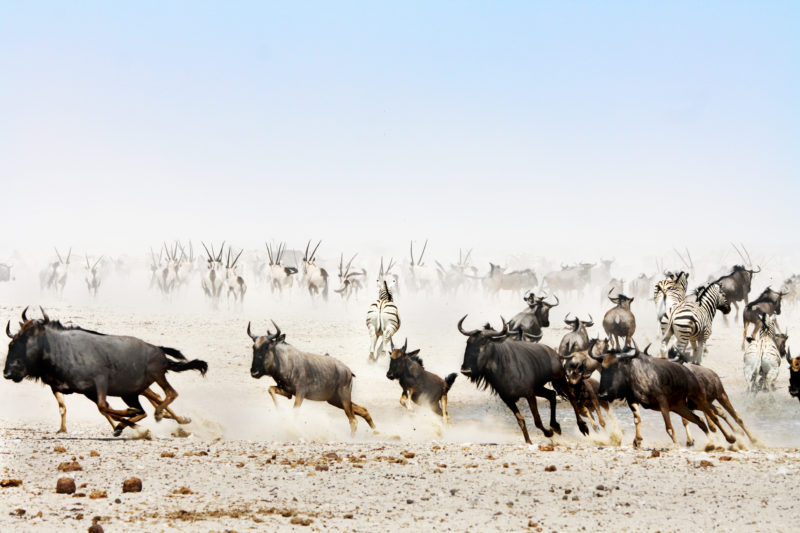
Etosha National Park, Namibia. Image by Rebecca Dannock.
The wildlife viewing opportunities in the desert-filled country of Namibia might surprise (and delight) you. Many different African animals have adapted to live in the harsh-but-beautiful Namib, a coastal desert. Herds of elephants traverse the desert, as do different types of antelope, zebra and even lions. Outside the desert, March can be humid and rainy, but April tends to be drier. The rains that fall early in the year make much of the country verdant in April.
Travel from Vic Falls to Cape Town and discover the highlights of Namibia
Safaris from May to June
May and June are winter months in Madagascar, but the island’s proximity to the equator means pleasant temperatures during the coolest months of the year. You’ll also see particularly lush landscapes in May and June, and these two months are considered part of the low season; there won’t be throngs of tourists.
Read more: 8 reasons why Madagascar should be on your bucket list
For the daring traveler who craves unique experiences, Madagascar is an essential destination. The island is rich in wildlife with hundreds of species of birds, reptiles, amphibians and mammals. The majority of the flora and fauna in Madagascar are endemic – they live naturally nowhere else in the entire world. Take a safari to glimpse lemurs swinging through the trees and the masters of disguise, chameleons.
Experience the undiscovered island of Madagascar on this magical 16-day trip or check out our full range of Madagascar adventures
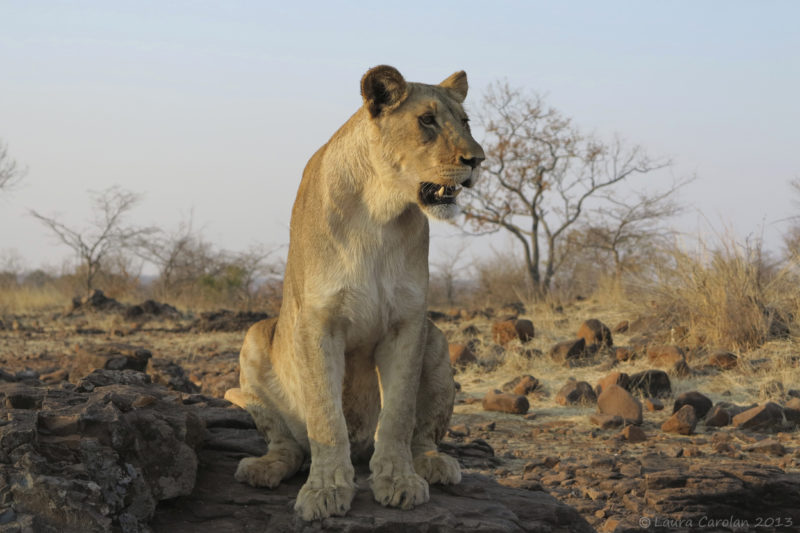
18-month-old lioness in Zimbabwe
In Zimbabwe, May is a transitional month with elements of both wet and dry seasons. The recent rains leave the land looking lush and green, but as the month progresses the weather becomes drier and the nighttime temperatures begin to drop. Come June, the days are warm and pleasant, while the nights are chilly. This time of year is the peak season for safaris. The drier weather draws animals to the country’s rivers and watering holes. Keep a lookout for lions, leopards, rhinos, zebras, elephants and more.
Read more: Here’s why you should visit Victoria Falls
Safaris from July to August
July and August are right in the midst of Rwanda’s dry season (which takes place from June through to September). These two months are very popular for booking gorilla trekking adventures because of the clear skies and sunny conditions. The gorillas live in Rwanda’s rainforests, mainly within the bounds of Volcanoes National Park. Here, you can also see chimpanzees and colobus monkeys living among the trees. Keep in mind that gorilla habitat is, by default, very wet and you can’t avoid rain completely. However, after heavy rain, the skies often open up to bright sunshine.
The permits are a flat price year round and just last week got hiked up from $750 USD to $1500 USD effective immediately. Luckily, Intrepid has pre-purchased permits on our group trips which means we are able to honor existing 2017 prices. So, when is the best time to go? Now, before it gets too expensive!
Go gorilla trekking in Rwanda (and so much more!) on this epic 16-day trip
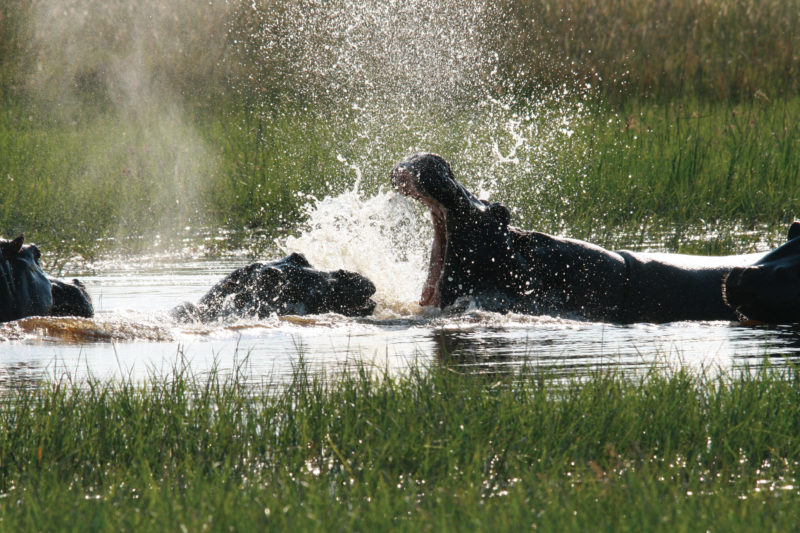
Hippos in Moremi Game Reserve
The Okavango Delta, Moremi and Chobe are among Botswana’s most popular parks and animal-spotting destinations. The best time to visit them is from May to September, during the dry season and winter, which results in more moderate temperatures.
Photo essay: What it’s really like on an Intrepid safari in Botswana
There is also less vegetation during these months, so animals tend to concentrate around waterholes and rivers, making wildlife easier to spot. The Okavango Delta is also in full flood then. The skies are clear, rain is rare and there are fewer mosquitoes. It does get cold at night and in the mornings, so packing warm winter clothing during June, July and August for the cold morning game drives is advisable.
Check out the highlights of Botswana on this life-changing 9-day trip or explore our range of Botswana adventures
Safaris from September to October
There is some light rainfall in September and October, but these two months are still part of the dry season in Ghana. You won’t have to worry about heavy rains causing flooding or travel delays. Birdwatchers will love taking a canopy tour through Kakum National Park – you can spot guinea fowl, African grey parrots and many other types of birds flitting through the trees. The national park is also home to forest elephants, civets, leopards, pangolins, a variety of monkeys and more.
Other wildlife hotspots include the Ankasa Rain Forest, the Wechiau Hippo Sanctuary and Mole National Park.
See West Africa’s wildlife on this awe-inspiring 21-day trip through Ghana, Togo and Benin
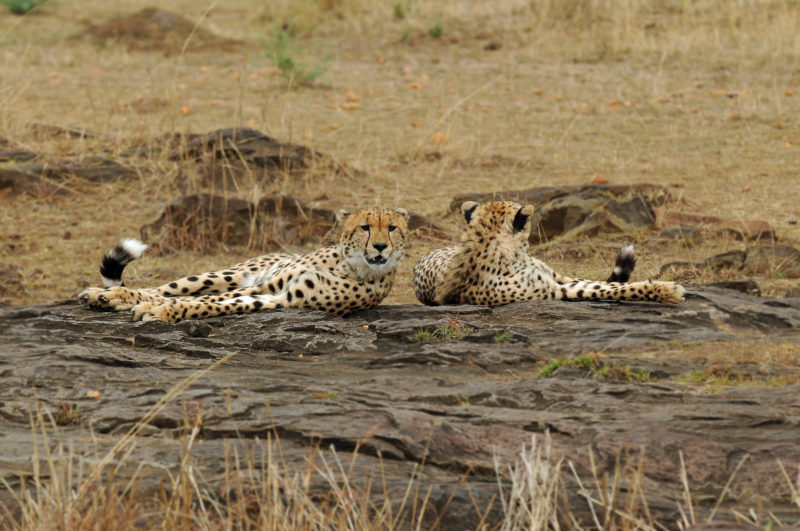
Cheetah siblings in the Maasai Mara
With more than 40 national parks and reserves, Kenya is a dream destination for safaris. This country draws tourists year-round, but September and October have certain advantages. These months are part of the dry season and the weather is also cooler. During these months, you can also catch the iconic Masai Mara migration (guide here ). The mass movement of these animals will attract larger predators, including lions.
Visit some of Kenya’s finest game parks (and see the Big 5) on this 8-day adventure or check out our full range of Kenya adventures
September heralds the beginning of springtime in Eswatini, a fairly dry time of year. Hlane Royal National Park and Mkhaya Game Reserve are ideal destinations for safari-goers who want to get close to animals like elephants, rhinos, buffalo, leopards and lions. In addition to these big mammals, Eswatini is also home to zebras, a variety of antelope, giraffes, hundreds of bird species and more.
Hit up Eswatini’s wonders (and South Africa) on this 9-day ‘Kruger and Coast’ trip
Safaris from November to December
Ivory coast.
November and December are the first two months of the warm and dry season in Ivory Coast. The temperate weather and minimal rainfall are ideal for travelers. And Taï National Park, a UNESCO World Heritage Site, is perfect for wildlife seekers. The park protects a tropical rainforest and its inhabitants include chimpanzees, pygmy hippos, leopards, colobus monkeys, flying squirrels, two species of bat, a variety of birds and much more.
This epic 28-day trip covers four countries in West Africa (the beautiful Ivory Coast included)
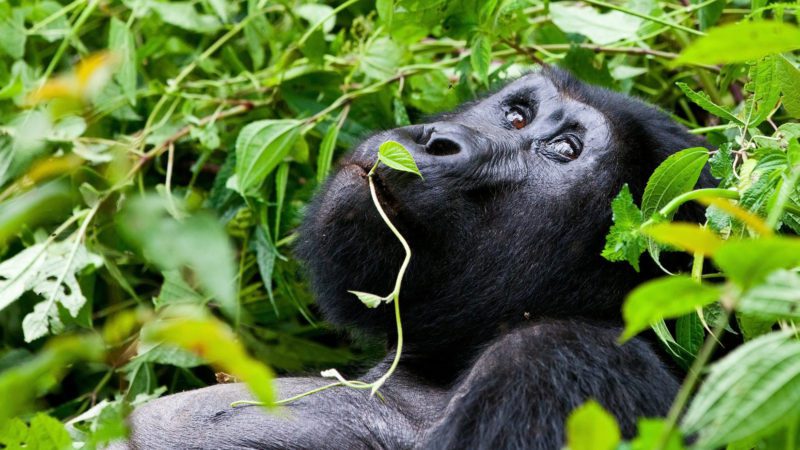
This low season also takes place in March and April and the pay-off is well worth it. Why? Well, as Jenny, Intrepid’s Africa Product Manager puts it, “Without the crowds you could find yourself trekking the gorillas with as little as 2 or 3 other people”. She adds that “it’s unlikely to rain all day. You’ll get a downpour at some stage each day, or even light rain on and off, but there are plenty of blue sky days as well.”
Explore the Ugandan rainforest and more on this incredible 21-day trip. Or, if you’re pressed for time, check out this 4-day gorilla short break in Uganda.
A note on the rainy season: don’t dismiss it!
Generally distinguished as the low season in Africa, the ‘green season’ is characterized by frequent rains. It’s a great option for travelers who can live with a bit of rain, and a bit more of a challenge when it comes to animal spotting. The vegetation is thick, and the grass high making wildlife harder to spot, and water is plenty so you don’t get a lot of animals congregating around waterholes.
What you do get is incredible, lush, green landscapes. Most animals give birth at the beginning of the rainy season so you will see plenty of newborns. It’s also a bird lover’s paradise with flowers in bloom and many migratory birds arriving back in the area from as far as Asia or Europe. The Serengeti and Masai Mara may be home to the world’s largest annual migration but green season Botswana hosts part of the longest recorded migration! Thousands of Burchell’s zebras cover more than 500km in a straight line across Namibia and Botswana.
It really is a great option for those second-time visitors to Africa who have been there, done that, seen the Big 5 and want to experience something ‘different’. Some destinations like Botswana in particular look like an entirely different place from one season to the other and it’s pretty amazing to see both ends of the spectrum, and you can get some incredible savings for traveling at this time of year. For example, travel on our new Okavango Delta Fly-in Safari in low season and you could be saving yourself about $1500 USD per person (as opposed to high season).
Ready to explore Africa on safari? Check out our wide range of small group trips.

Carrie Pallardy
Carrie Pallardy is a Chicago-based writer and editor. Despite just returning from a trip to New Zealand, her wish list of places to travel is nearly endless. She plans to travel to every continent and every national park in the U.S., and, of course, loves to write about her experiences traveling near and far.
You might also like
Best places to travel in march, best places to travel in may, best places to travel in february, best places to travel in april, best places to travel in june, how to secure your inca trail permit the..., best places to travel in july, best places to travel in january, best places to travel in november, best places to travel in october, best places to travel in september.
Revel in the bazaar
Marrakech is synonymous with sensory overload. But if you slow down and tune in to the everyday rhythm of local life – often found in the souks of the labyrinthine medina and the city’s vibrant main square – a distinctly Moroccan beat emerges.

Time and place: Djemaa El Fna, Marrakech
- Best of Morocco
- Premium Morocco Highlights

Things To Know Before Going On A Safari In Africa: 13 Top Tips
E mbarking on a safari in Africa is high on many people’s travel bucket list . Ever since we’re children, we are exposed to stories and cartoons of wild animals roaming freely through the plains of Africa, from hungry lions to majestic giraffes and wise old elephants.
If you’re about to make your Discovery Channel viewing a reality, then you will want to come make sure you go in knowing the important things to know before going on a safari in Africa.
We’ve been really lucky to have experienced several safaris in Africa, from the Masai Mara in Kenya, the iconic Kruger National Park in South Africa, and even the vast expanse of the Serengeti in Kenya.
There is nothing more wide-eye inducing than watching as a cheetah, in a 70mph predator run, chase and bring down a small springbok, or watching lions eat their freshly caught breakfast, or see baby zebras learn to walk.
But not everyone is lucky on a safari when it comes to wildlife viewing, especially if you plan to self drive, so we’ve put together this list of tips and important things to know before a safari.
1. Plan Your Safari Destination & Dates in Advance
2. make a list of animals you want to see, 3. know the best time for animal viewing.
- 4. Don't Get Fixated On Seeing ALL The Big 5
5. Get A Good Camera
6. take a guided night drive, 7. take a guided walking safari.
- 8. Know That Monkeys Can Be "Cheeky"
9. Be Prepared For A Lot Of Hiking On A Gorilla Trek
10. pack light, 11. be quiet at water sources, 12. be prepared for dust, 13. take note of these safety tips for game drives, group tours of africa, final thoughts, more africa travel tips, things to know before going on a safari.
Before any game drive, careful planning is essential for making the most of the safari experience. You need to choose your destination wisely, and you also need to choose the right time of year.
Typically, the best time of year for wildlife viewing in Africa is late June to October, which is Africa’s winter season.
This time of year the wildlife are on the move as the weather is not too hot. If you have opted for a safari in Kenya or Tanzania, then time your safari for July through November, when the Great Migration takes place.
This is when hundreds of thousands of wildebeest migrate thousands of miles across the savannah, which attracts predators such as lions and cheetah.
In the dry season, the grass is short making it easier to spot wildlife, but it does also mean the choice of drinking water sources for the animals will be fewer.
This may increase your chances of watching them socialise at flood lit waterholes opposite your campsite, with an ice cold beer.
We learned this safari tip the hard way.
We visited Etosha NP in Namibia during the wet season. Etosha is notorious for brilliant water hole animal viewing, except we didn’t see much at all. The campsite water holes that usually see an abundance of wildlife were empty due to the abundance of water around the park.
You then need to decide what wild animals you want to see, as some animals are only found in certain parks.
For example, if you really want to see elephants, then the best place to go would be Addo Elephant Park in South Africa .
Typically, private game reserves have the best wildlife viewing as they are smaller, but you do need to consider they are smaller in land mass which might not be as eco-friendly as a national park.
If it’s gorillas you want to see, then plan to visit Uganda or Rwanda, or if you want to see a place teeming with everything, Kruger National Park or Masai Mara in Kenya are great all-round game reserves.
Going to many different parks all over the continent will wipe out your budget. The best way to decide which game serve or national park to visit is to consider where the animals you most want to see are location.
Animals are most active at dusk and dawn. It is very hot in Africa, so during the day the animals are usually hibernating in the shade.
Be sure to do the same thing yourself. If your excitement is too hard to contain and you go out during the day, the only result will be that you chew up your fuel budget, and an eventual visit to the chiropractor for neck strain.
Get up early to catch the animals at play, rest during the day, and then go out again just before sundown.
You have a much better chance of seeing them up close and personal on the road.
There were several times we turned a corner to find a lioness resting on the warm tar. It was a magnificent sight to see her suddenly jump into launch mode, and stare us down through our front windscreen.
TIP: Lions like to sleep on the road at night to soak up the day’s heat trapped in the tar. If you’re up early enough you
4. Don’t Get Fixated On Seeing ALL The Big 5
The excitement of seeing the Big 5 is very enticing i.e. rhino, buffalo, leopard, lion, and elephant.
Why are these animals called the Big 5? It has nothing to do with size, these animals were the most prized trophies of hunters years ago.
Please don’t get fixated on the Big 5 and think this is all that matters. Remember travel is not about checking things off your list.
There are so many different animals for you to discover and learn from, and each is valuable in its own right.
Spend time appreciating them all. I used to even love watching the dung beetles. They were fascinating and I learned so much about them in the process.
Dung beetles are also dying out, so if you see one, you’re more lucky than seeing a rhino. Wild dogs are also super rare, though they don’t get the same fan-fare as lions and cheetahs.
Sadly, black rhinos and white rhinos are dying out and near extinction, so the chances of seeing these animals are rare. Don’t forget these are wild animals and you can’t control where they go – so don’t beat yourself up if you spend 5 days in a game reserve and don’t see a rhino.
Do yourself a favour, spend the money to buy some good zoom lenses. We opted for a a 600mm zoom lens.
Animals are scared of you, they won’t come close for a portrait, and you won’t sneak up closer to them (I hope).
You’ve spent all the money, time, and energy to put yourself in a place of contact with these wild animals, you want to have something to take away from it and keep with you for memories and reflection.
Read more: Here’s what’s in our camera bag
You might think that a night drive wouldn’t be much fun, after all, how much can you see in the dark? You’d be surprised!
Once night falls you can jump in an open topped vehicle, with a huge spot light, and a guide to tell you more about what you see as you drive around the park, hearing the sounds of nighttime Africa, and seeing only the red eyes of creatures in the dark.
This is the time when leopards usually hunt, and you may see some other noctural animals like porcupines and jackals.
Note that you can only go on night drives organized at your safari lodge. All gates to accommodations close by nightfall, and so you better be locked safe and sound inside them.
Just do it! Getting on the ground with these magnificent beasts in their territory will get your heart pumping.
We didn’t have as much action as anticipated, but we did get close to rhinos (downwind) and we smelled the fear of the lions running away from us in the distance.
If you take a tour please make sure they are eco-friendly and protect the animals and their habitats from these dangerous human encounters.
Alternatively, a horse ride is a relaxing and pleasurable way to see the stunning scenery with friendly herbivores by our side. We went horse riding through the valleys in Swaziland amongst warthogs, zebra and deer.
If you’re out walking amongst lions and rhinos, you might want to make sure you have adequate travel insurance! Check V isitor’s Coverage and World Nomads , and SafetyWing for prices and policies.
8. Know That Monkeys Can Be “Cheeky”
Monkeys in all shapes and forms are hilarious. Sit and watch them and be highly entertained.
We saw them arguing, b***slapping one another, picking each others nits, jumping over our car trying to take it hostage, and yes doing it like they do on discovery channel- over and over again!
It’s not uncommon for monkeys to get curious with safari goers and may even jump on your vehicle and try to swipe your camera.
If you encounter monkeys, keep all food and water locked away in your bags and keep an eye on your belongings.
If your plan is not to go on a safari, but to go on one of the iconic gorilla treks, go in prepared to do a lot of hiking.
These gorilla treks can be anywhere from 30 minutes in the jungle to 8 hours. It really depends on where the gorillas are and how quickly they move.
You really don’t need to pack much when you’re going on a safari, since you spend all day in a vehicle being driven around the wilderness.
Bring snacks and plenty of water, but make sure you bring a bag that closes so nothing can fall out.
If you are going out for sunrise to sunset, you will need to pack a picnic for breakfast and lunch (sometimes it’s provided as part of a tour).
Some game reserves have a restaurant (Kruger NP has a really nice one) but not all of them have these facilities.
There are usually hides next to a water source where you can safely exit your vehicle and walk into.
These hides are for viewing hippos and crocodiles, and they sit right by the water so you get an amazing view.
If you have small kids, please, please, ask them to be quiet. The hippos will duck under the water if they start screaming. I know it’s exciting, but remember you are in wildlife’s home and these animals are easily spooked.
The savannah is a dry, barren landscape, and it has a lot of dust. These safari vehicles are usually open top, or at least, don’t have windows, so dust gets everywhere.
It will be all over your clothes, all over your skin, in your hair and in your eyes.
I recommend you wear sunglasses to protect your eyes, and bring a scarf or something to wear over your mouth if it becomes unbareable.
Never, ever, ever, and I mean ever, get out of your car. UNLESS in a safe designated area, or with an armed ranger present.
This is the wild, don’t mess with it.
I know this sounds a bit like a ‘No Sh*t, Sherlock’ kind of statement, but you will be surprised at how many people get eaten by lions trying to get that perfect shot.
Keep a safe distance when you encounter a wild animal and when in your vehicle keep your windows rolled up
If you get stuck between a herd of elephants (this happened to someone we know) turn off your engine, keep your windows up, and wait patiently for them to move on before driving past.
Elephants feel vibrations through their feet, and the car engine could spook them or cause them to feel threatened.
Zip your tent up at night. Nothing beats hearing the roar of a lion in the middle of the night, but you don’t want to invite it in for dinner.
We rented a car for most of the safaris we visited. Check Discover Cars for best prices and availability .
If you’re considering joining a group tour for Africa, consider our long-term partner Globus family of brands. We have a discount in the blue box below.
- Globus tours of Africa
- Cosmos tours of Africa
GLOBUS DISCOUNT JUST FOR YOU!
We’ve secured an exclusive yTravel discoun t: Save $100 per person on select 2024 Globus and Avalon Waterway Vacations. Use the code: YTRAVEL when booking online at the Globus , Cosmos , and Avalon Waterways websites, by calling Globus and Avalon Waterways directly, or booking with a preferred Travel Advisor. Terms & Conditions .
As you prepare to leave for Africa, you may have come to realize Africa is a long way from home, it’s rough travel, and safari’s are expensive.
Good for you for deciding to do some research, and for making a plan. This is the first step to ensuring you see the best African wildlife encounters and make the most of the experience.
We hope these African safari tips has helped you plan ahead, avoid making the usual safari mistakes, and gave you the insight to ensure that your dream African adventure brings you the most amazing wild animal encounters you can brag about for years to come.
Need more inspiration for your trip to Africa? Then these other guides might be helpful to you…
- Top 5 Things in Botswana to experience the natural beauty
- 7 Reasons to visit Mozambique
- 13 awe-inspiring things to do in Eastern and Southern Africa
- Africa Travel Safety Tips
- Helpful tips for getting around East and Southern Africa
- How to travel Africa on a budget
- Ep 02 Podcast of our 5 year honeymoon (6 months in Africa)
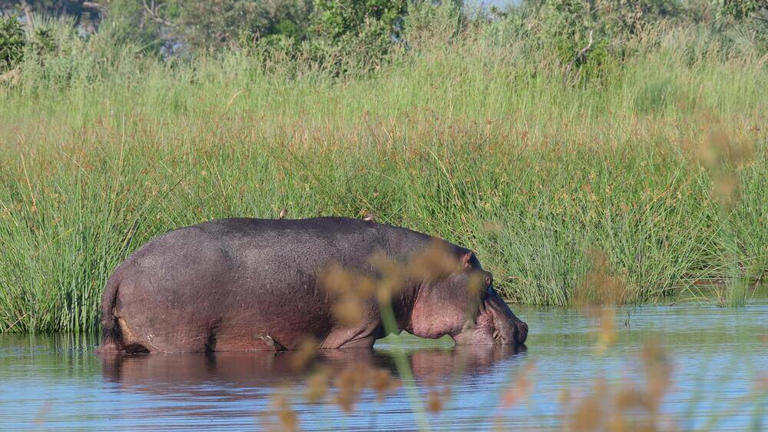
I went on my first safari trip to South Africa. I won't make these 10 mistakes next time.
- I spent a week on safari in South Africa , visiting three different reserves.
- I found that planning was essential and that I always needed to have my camera ready.
- Next time I'd bring warmer clothing and a buff for dust control.

I spent a week on safari in South Africa, visiting three different reserves.
It was a thrilling adventure I'll never forget, and I got to see incredible creatures such as hyenas, elephants, and lions.
It's no wonder more travelers are looking to weave game reserves into their trips. According to the most recent data collected by the travel agency Go2Africa , interest in beach and safari combo trips was up 20% from 2022 to 2023 alone.
But although the trip was great, it wasn't always easy — and I had a few missteps from the planning phase to the wildlife observation.
Here are mistakes I made on my trip that that everyone should avoid on their first safari .
We booked our trip during a busy part of the year.
I try to avoid traveling during holidays , which often means more crowds. Unfortunately, we ended up booking during Easter break, which was the end of summer in the southern hemisphere.
The lodges were full and busy with lots of kids, and the prices were higher. We still had a great time, but if we'd booked different dates — maybe during a low season — we may have paid less for a more private experience.
The mornings were cold, even in summer.
Our morning game drives started before sunrise in an open-air jeep.
The safari guide was wearing shorts, so I thought I would be comfortable matching that. Wrong! I was so cold on our first ride.
I quickly learned that although it was summer, a beanie and down jacket would've been cozy on the drive.
I missed photo opportunities because my camera wasn't ready.
I knew I wanted to keep my camera out at all times when on a game drive. But after several hours of driving, we were approaching the gate and I tucked my phone away.
That's when we turned a corner and saw a large white rhino facing us in the middle of the road. It was a dramatic moment I captured in my head, but I didn't have time to snap a photo before it darted into the bushes.
Next time, I'd be better prepared for animals that might pop up near the exit.
I had no idea how dusty the roads were going to be.
The safari terrain changed based on where the guide drove each day, and some routes were quite dusty.
After a day of exploring, I felt as if I had dust in my ears, eyes, nose, and mouth. Sunglasses helped shield my eyes, but I wish I'd brought a buff to cover the rest of my face.
Driving between game reserves made me more tired than I'd expected.
Our safari adventure included visits to three different wildlife reserves, and we rented a car to get between them.
On each transition day, we had a morning game drive, then a drive to get to the next reserve, and then an evening game drive there.
That was a lot of sitting, and by the time I got to the evening game drive, I was tired. Next time, I may space my schedule out more.
I made the classic mistake of leaving the car door open when unloading the luggage.
At one point, I walked my bags inside my accommodations, leaving the door open behind me. When I came out, the neighbors were taking photos of a monkey inside my car.
He was quick because, fortunately, I didn't have any food in the car for him to run off with.
Now I know to stay on top of shutting and locking my car doors when at a game reserve.
We got too close to elephants.
Animals can be unpredictable and safaris are not like a zoo. I learned how quickly a situation can change while watching a herd of elephants eating in Kruger National Park.
They started crossing the road in front of my car, and a large one turned to look right at us and started shaking his head. It seemed clearly displeased with our presence.
I flipped the car into reverse faster than you can say "elephant," but it was a scary moment.
Consuming too much liquid can be risky.
Evening safari drives include a stop in the bush around sunset for a "sundowner" beverage. One of the nights, my drink proved to be too much liquid for my bladder.
The problem was that we were following a pride of lions, so there was no chance of hopping off the truck to relieve myself.
I was able to hold it, but next time I'll be more careful with the amount of liquid I consume before and during bush drives.
I was caught off guard by load shedding.
Load shedding is the name for scheduled power outages in South Africa that help prevent the power grid from being overloaded.
Some places have backup generators or solar panels to alleviate power disruptions, but I learned not to expect that to always be the case.
When the power turned off during our trip, I found myself sitting in complete darkness. I scrambled for my phone flashlight, but I could've avoided that panic by plugging in the emergency light that was provided.
- Main content
How Much Does an African Safari Cost?
Being surrounded by giraffes, elephants, lions, zebras, and cheetahs in Africa sounds like a dream come true. But it also sounds expensive. Getting a guide, accommodations in an area with easy access to wildlife, and airfare adds up quickly. So, how much does an African safari cost?
An African safari can run anywhere from $200 to $1,600 per person per day, or even more for something ultra-luxe. Read on for an in-depth breakdown of the costs below.
How Much Does an African Safari Cost on Average?
The cost of an African safari will vary depending on the specific destination, the type of accommodations, and the time of year among other factors.
The most budget-friendly safari includes tent accommodation and costs approximately $200 per person per day, while the most luxurious African safari can be up to $1,600 per person per day or more, with the sky the limit on high-end perks.
Your African safari costs include all park admission fees, meals, camping equipment, drinking water, and transportation. While most are at least a few nights, they can range from a short one-day adventure to a multi-week-long excursion. You’ll also need to account for tipping your guides thorughout, with the standard tip $10 to $20 per person per day.
Things That Impact Your African Safari Cost
You can do many things to cut your African safari costs, while other things will bring the price up. I always tend to focus on what’s important to me and splurge on those aspects. For instance, if you like staying in luxury accommodations, you might plurge on your stay but go during the off-season so it’s not as pricey.
The Length of Your Safari
Obviously, the total cost of your safari will be more the longer it is. However, the daily cost is cheaper when you book multiple days with one guide. It’s kind of like buying in bulk at Sam’s Club or Costco.
The Time of Year You Go
There is a high and a low season for African safaris. The high season is generally from May through September, when the kids are out of school in the Northern Hemisphere, the weather is the coolest and driest, and it’s easy to spot the animals. The downside is that it will cost more due to the higher demand.
For a more budget-friendly safari, consider the low season which is primarily summer in the Southern Hemisphere from around October through April. It will be hot and humid, typically with short bursts of rain between the sunshine, although heavy rains can occur in March and April.
Where Your Safari Is
The country and park you choose for your safari will have an affect on the cost. A safari that includes multiple countries will cost more compared to staying in one park. South Africa offers some of the cheapest safari options because it’s easier for self-drive trips, with the parks built better for these types of excursions.
The Level of Accommodation
You can stay in everything from a tent purchased at your local outdoor sporting goods store to yurts and lodge rooms with furniture and modern technologies like Wi-Fi. There are resort-like stays possble too, if you want an African safari that includes high-end accommodation like a villa, along with pools, bar and restaurant service.
Your Mode of Transportation
Driving yourself through one of the many parks and reserves is an option, but it’s generally not the best way to go. A guided safari ensures a better experience as the guides know where the animals hang out, which means you’re much more likely to spot the wildlife you want to see.
Less costly guided safaris are typically in open-roof minivans that people are crammed into. The nicer African safari tours use more comfortable Jeeps that are entirely open, ensuring that you’ll see everything wherever you sit.
How Many People Go On The Safari
The more people that come with you, the less your African safari will cost. Most accommodations will hold two people, and some have capacity for as many as five, although there’s usually a per-person charge for the safari. Still, it will cost less since you’ll be sharing one accommodation.
The Best African Safari Destinations
There are safari destinations throughout Africa. Each location has its own unique wildlife and price range, so it’s important to choose based on the type of African safari experience you want and your particular budget.
Kenya is the original safari destination. It makes sense, with multiple large game reserves, the great migration, and a slew of cultural experiences to encounter. Some of the best reserves to visit in Kenya include:
- Masai Mara National Reserve- The most popular park in Kenya.
- Samburu Game Reserve- Has unique wildlife, like Beisa oryx, reticulated giraffes, and Somali ostrich .
- Tsavo National Parks- The largest and most remote park in Kenya.
- Amboseli National Park- You can see Mount Kilimajaro at this park.
- Lake Nakuru National Park- Millions of flamingos and white rhinos live here .
There are many great lodges to stay at in around these parks that will take you on a drive to see the wildlife every day. One that we can recommend is Elephant Bedroom Camp which gets its name from the elephants known to frequent the grounds. You might see monkeys and impalas right from your luxury tent too.
This camp has all of the comforts that any modern accommodation would include like a pool, hot and cold water, electricity, and WI-FI. A daily drive through the bush in an open-air vehicle, a picnic lunch, cultural visits, and entertainment by Samburu warriors are all included.
If your dream is to see a gorilla or chimpanzee in the rainforest, then Uganda is the African safari destination for you. It’s different than most of the other African safaris in that here they’re enjoyed in rainforests rather than the desert. You can check out some amazing waterfalls during your safari. Some of the top parks to consider in Uganda are:
- Murchison Falls National Park- Has various mammals such as giraffes, buffaloes, and crocodiles.
- Bwindi Forest National Park- Has the largest population of endangered silverback gorillas.
- Kibale Forest National Park- Has the highest diversity of primates in Africa.
- Mgahinga National Park- A large park spanning three countries where endangered silverback gorillas live.
- Queen Elizabeth National Park- One of two places where lions climb trees.
To be fully immersed in the rainforests that gorillas and chimpanzees roam, stay at Bwindi Lodge . You might even spot colorful birds and chimpanzees swinging from the trees in the Bwindi forest right from your room. There’s also a village nearby hosting the award-winning Bwindi Bar.
Another advantage of staying at the Bwindi Lodge is that you can trek into the forest to see the mountain gorillas and other wildlife instead of having to get into a vehicle. There’s also a waterfall trail for exploring the landscape as well.
Botswana is a lesser-known safari destination, so it will feel more exclusive and it comes at a smaller cost. There are a variety of landscapes and different types of wildlife, but one of the most popular types of safaris here is a boat safari where you can see elephants and hippos. The best parks in Botswana are:
- Okavango Delta- The most popular park in Botswana, famous for boat safaris on its winding channels.
- Chobe National Park- You can take a car to this park, making it more accessible. Elephants are a popular group here.
- The Kalahari- Look for black-maned lion during the wet season.
- Makgadikgadi Pans- Find unique African animals across glistening salt pans.
- Moremi Wildlife Reserve- One of the most remote and diverse wildlife areas of Botswana.
Staying at Abu Camp gets you up close and personal with elephants. Since the camp is next to a lagoon, there is a herd of elephants that call it home. There’s even a chance to sleep in the elephant boma for the ultimate experience. Every type of safari is available here too, from game drives to boat safaris.
Abu Camp has super comfy accommodations with modern furnishings and all the luxuries of any good hotel. There’s a plunge pool to cool off during the day while you wait for your evening safari while the private canvas tents overlook the Delta providing picturesque views.
Tanzania is home to the Serengeti, where millions of wildebeest form one of the most incredible sights that can be witnessed on the planet. It’s also home to Mount Kilimanjaro, where the most adventurous can summit its peak. This place is basically home to everything you’d envision when thinking of Africa. The most popular safari parks in Tanzania are:
- Serengeti National Park- The world’s most popular destination for a safari.
- Ruaha National Park- The largest park in Tanzania with many elephants and giraffes.
- Ngorongoro Crater Conservation Area- Home to the Ngorongoro Crater, where you can find the largest population of lions in the world .
- Lake Manyara National Park- Home to a massive lake where you can spot animals looking for water during the dry s eason.
- Mikumi National Park- Mostly flat grassland, making it easy to spot wildlife.
For the best views over the Serengeti day and night, Klein’s Camp is a great place to stay for your safari. It’s situated on the border of the national park, allowing it to be one of the only camps offering open-air night drives. It’s also perfectly positioned to watch over the Serengeti right from your room.
Klein’s camp feels extremely exclusive as it includes 10,000 hectares of privately leased land. You can go off-roading anytime during the day, or follow a zebra trail. There are also specialized photography tours and visits to the Maasai village to experience their unique culture.
South Africa
South Africa is where you want to go to save a few dollars. There is plenty of wildlife and it has better infrastructure than most other safari destinations. That means there’s more opportunities for self-guided tours, which means significant savings. Of course, there are great guided tours too they just cost more. The best reserves in South Africa are:
- Kruger National Park- The most popular park in South Africa with the Big Five.
- Madikwe Game Reserve- A malaria-free, affordable park with rare wild dogs.
- Sabi Sands Game reserve- A private reserve bordering Kruger National Park.
- Phinda Private Game Reserve- Famous for cheetah sightings.
- Tswalu Kalahari Reserve- The largest private game reserve in South Africa.
If you want to stay in luxury on your South African safari, Loapi Tented Camp provides the quintessential safari aesthetic. However, it comes with a fully stocked kitchen, and an environmentally friendly plunge pool. All have plenty of space between each for a more secluded feel.
Each safari home comes with your own personal butler, a private chef to cook all your meals, a study with Wi-Fi, a full bar, and indoor/outdoor shower. You’ll even have your own safari vehicle with a private tour guide to take you out every evening. When you don’t feel like exploring by vehicle, head out on horseback instead.
About The Author
K.C. Dermody
K.C. Dermody is the author of Best Travel Guide for First Time Visitors to Ireland and has had hundreds of travel articles published online and in print, including Yahoo! Travel, Trips To Discover, Hotels.com, Travelocity, and many more. She also creates itineraries for major tour companies focused on Greece, Croatia, Iceland, Ireland, the UK, Canada, and the US.
Share This Article
Africa Safari trip 2025: Hilary Barry to host Viva Expeditions trip

Hilary Barry will be a host on the Viva Expeditions Africa by Rail tour in August 2025. Photo / Supplied
Kiwis eager to embark on a 10-day Africa safari can join television presenter Hilary Barry in August 2025
To see a giant lion prowling around the African jungle is one thing. To have the experience narrated by beloved television presenter and self-described “lippy suburban mother of two” Hilary Barry is another thing entirely.
It’s something 72 Kiwis can experience in August 2025, when Barry sets off on a 10-day luxury rail trip with New Zealand travel company Viva Expeditions.
“It’s always been a dream of mine to experience the stunning landscapes and amazing wildlife up close,” said Barry, who said it would be an “absolute thrill” to see a lion in the wild.

The famous broadcaster won’t just be there to snap photos of the big cats; she’ll also be the official host for guests on the trip around South Africa and Zimbabwe.
The Africa itinerary includes stops at Kruger National Park, where travellers can spot the “Big Five”′ animals, a private game reserve, Hwange National Park, and the world-famous Victoria Falls.
Those who prefer the comforts of home or a hotel over roughing it in the jungle have nothing to fear; the trip will take place on the Rovos Rail, one of the world’s most luxurious vintage trains.
While Barry has been known to inspire viewers (and infuriate others) with her fashion choices on television, Barry told the Herald she’ll be taking a practical approach to her outfits for the trip.
“Definitely nothing off the shoulder. I don’t want to be mistaken for a wildebeest and end up on the menu of an apex predator,” she joked. “That said, I think I could rock a safari suit”.

Barry has travelled to Africa several times but this will be the first time she goes as a holiday-maker rather than a reporter.
“I had the opportunity to travel across Kenya to the northern border with Somalia, home to the world’s largest refugee camp at Dadaab,” she said, adding that the team reported on the humanitarian crisis as people fled the violence of Al-Shabaab militants in Somalia.
Barry continues to be a vocal advocate for justice and social issues however she is “absolutely thrilled” to visit the continent as a tourist on August 28 with Viva Expeditions.
If you’re still looking to tick “safari” off your bucket list, there are few ways more glamorous or unique than doing it on an old-school luxury train with Barry beside you.
This isn’t the first time Viva Expeditions has recruited a household name to host a trip. In 2023, former New Zealand Prime Minister, Sir John Key led a 13-day cruise to Antarctica.
The tactic was a “resounding success” according to Viva Managing Director Rachel Williams, and the team were excited to do something similar for the Africa by Rail tour.
“Hilary Barry is such a warm and friendly person, and her adventurous spirit and love for storytelling make her the perfect travel companion for an ‘Africa By Rail’ journey,” Williams added.
Tickets for the tour start at $16,066 per person, with 72 spots available.
Latest from Travel
The ultimate cosy christmas: visit washington dc in december, ‘oppressive’: guillermo del toro gets haunted in scotland hotel, a chilling newspaper excerpt on the titanic disaster has been discovered after 112 years, kiwi aussie love story heroed in new qantas commercial.

Plan now for a Christmas with woolly hats, festive lights and eggnog.

'Lonely, horny' dolphin behind spate of attacks on swimmers

Plan now and play later

COMMENTS
Budgeting and costs for a safari in Botswana. Stays at isolated camps in the Okavango Delta start at roughly $650 per person, per night and can go up to an eye-watering $4000 a night. At approximately $300, Chobe National Park lodges are more affordable - so stretch out your days here to keep costs down.
Wild Rwanda Safaris: Bwindi Gorilla Safari. Courtesy of Wild Rwanda Safaris. Length: Three days. Starting price: $1,450 for two people with lowest-cost lodging. Adventurous travelers sticking to a ...
7. Mala Mala Game Reserve. Peter Beesley/Shutterstock. As one of the best safaris in Africa, Mala Mala Game Reserve is one of the best places to see lions in their natural habitat. Mala Mala borders the Kruger National Park, the largest game reserve in South Africa.
1 of 9. CNN —. With so many spectacular game reserves to choose from, determining the ultimate once-in-a-lifetime African safari experience is no easy task for travelers. From Tanzania's ...
We can't talk about the best place to go on safari in Africa without mentioning the epic Ngorongoro Crater. With a completely unique landscape and extremely high density of wildlife, including the highest concentration of lions in the world, it's no surprise that many Tanzanian safari itineraries include this 'Garden of Eden.'
Best Time To Go on a Safari in Tanzania. The best time to visit Tanzania for a safari is June to October, the dry season in the Serengeti. This is when the bush is thin and you can see more wildlife, including the Big 5. However, May through June is when visitors can see the wildebeest migration in the Serengeti.
Ranks #2 in Africa's Top 50 Safari Parks. 109 Sabi Sands Tours. #3 South Luangwa National Park Zambia. 4.71 /5. Walking and classic safaris, giraffe, four of the Big Five (no rhino), abundant wildlife. Ranks #3 in Africa's Top 50 Safari Parks. 57 South Luangwa Tours. #4 Okavango Delta Botswana. 4.70 /5.
What months are best to go on an African safari? The African continent is massive, comprising 54 unique nations and nearly 2,000 languages. Most safaris take place in two main savanna regions of the African continent: Southern and East Africa. The Southern Africa region includes South Africa, Botswana, Namibia
And Chobe Game Lodge boasts the only all-female safari guide team in Africa. ( Meet the all-female anti-poaching unit saving rhinos and other wildlife. Elephants enjoy a sunny day in Botswana's ...
Green means go. While every luxury safari offers unforgettable wildlife encounters, there are plenty of options to consider. High-end African trips and settings vary hugely in their atmosphere and ...
Niarra Travel offers a 13-day Victoria Falls, Okavango, and Cape Town itinerary that incorporates the Zambezi River and Falls into a three-country itinerary (Zambia, Botswana, and South Africa). Jennifer Flowers. Jennifer Flowers is an award-winning journalist and the senior deputy editor of Afar. When it comes to choosing a safari in Africa ...
Phone +27 13 735 4000. Web Visit website. Located in the northeast of the country on the Mozambique border, Kruger National Park is the most famous of all South Africa's many game reserves. As well as the Big Five, the park is home to the vulnerable cheetah, the endangered wild dog and several elusive small cat species.
April to May (the 'long rains') November to December (the 'short rains') Generally, the main rainy season (the long rains) produces tropical downpours in the afternoons and many safari camps close. The short rains season sees the occasional brief shower, but safari camps stay open and game viewing is good. Most Kenya safari destinations ...
Go on safari through Kruger National Park, one of the largest game reserves in Southern Africa. This massive park is one of the premier safari spots in all of Africa and for good reason; it's home to over 500 bird species, 100 species of reptile and 150 mammal species, including the Big Five and the endangered African wild dog. View trip.
First Time Safari Tip #3: Now! Now! Anyone familiar with "Africa time" will understand that there are several meanings to the word now. There is "now," "just now," and "now now." "Now" could mean anywhere from five minutes to two months later. "Just now" means in the next hour or so.
Find out why and where to go for the best African safaris in 2024. 1-866-438-8677 1-888-360-2392 1-800-619-441 0800-404-9451 ... After enjoying one of the best places to go on safari and discovering some of Africa's best national parks and wildlife, spend some time relaxing on idyllic Indian Ocean islands. ...
Fast facts about Tanzania: Regular sightings: All Big 5, predators including cheetahs, hyenas and jackals. Types of safari: Walking safaris, game drives, sundowners, night safaris, photographic safaris. Budget: ££-£££££ Best time to go: Visit between July and October, when Tanzania is at its driest.This also coincides with the Great Migration river crossings but, just like in Kenya, the ...
Most days on safari begin before dawn. While watching the sunrise in Africa is reason enough to rise before the sun, you're also up early because the first two hours of daylight are the best times to see wildlife - in the cool of early morning, most animals are out and about and active (even some of the nocturnal species such as hyena).
Masai Mara National Reserve, Amboseli National Park, Samburu National Reserve, the Laikipia Plateau and Lake Nakuru National Park in the Great Rift Valley. Kenya's Wildlife. Kenya is a Big Five safari destination, with plenty of opportunities to see lions, elephants, leopards, buffalo and the endangered black rhino.
Botswana. June through September is the best time to go on safari in Botswana. There is little chance of rain, and the weather is still lovely and warm during the day. Huge herds congregate around the Okavango Delta during this time, making a trip in a mokoro (traditional canoe) extremely rewarding. Botswana is one of Africa's most expensive ...
Located in the northeastern part of South Africa this vast wilderness sanctuary that is one of the best places to go on safari in Africa is accessible for both self-drive safaris and guided game drives. Game includes the Big Five as well as cheetahs, wild dogs, giraffes, zebras, hippos, crocodiles, and antelopes. ...
The best time to go on safari is between June and October, during the dry season. This is a cooler time of the year and you are more likely to see animals, who are searching for water sources. During these months, you can also catch the iconic Masai Mara migration. Here is a breakdown of some of the best countries to visit, when to go, and the ...
Embarking on a safari in Africa is high on many people's travel bucket list. Ever since we're children, we are exposed to stories and cartoons of wild animals roaming freely through the plains ...
I spent a week on safari in South Africa, visiting three different reserves. It was a thrilling adventure I'll never forget, and I got to see incredible creatures such as hyenas, elephants, and lions.
After much planning, I finally booked my safari tours, 13 days in Kenya, end of June. But after a long trip to get here, I'd love to see something other than animals before heading home. I know this is a Kenya forum, but I'm sure many who post here have experiences elsewhere in Africa.
You can go offroading, go any time of day, or follow a zebra trail. They will also take you on specialized photography tours and visit the Maasai village to see their unique culture. South Africa. South Africa is where you want to go to save a few dollars. There is plenty of wildlife, but it has better infrastructure than most other safari ...
Kiwis eager to embark on a 10-day Africa safari can join television presenter Hilary Barry in August 2025. ... 'I am ready to go full tilt Karen,' the traveller said after describing the situation.